Nepal is a country of staggering contrasts, where the world's tallest mountains rise above chaotic cityscapes, and ancient traditions thrive amid modernity's rush. Yet, beneath it all lies an enduring generosity — a warmth that turns strangers into friends and fleeting moments into lifelong memories.
Nepal hums with contradictions — where towering Himalayan peaks cast their shadows over bustling streets, and ancient temples coexist with modern-day chaos. It’s a place that wears its history, poverty, and resilience openly, but also carries an unmistakable warmth, a kindness that feels like a steady flame against the cold winds of change.
I first stepped foot in Nepal in 2017, not knowing what to expect beyond the postcard-perfect views of Everest and whispers of spiritual retreats. What I found was something far greater: a land whose heart beats with an almost indescribable generosity. Strangers offered tea before they even asked my name, and those with so little shared so much, reminding me of what hospitality truly means.
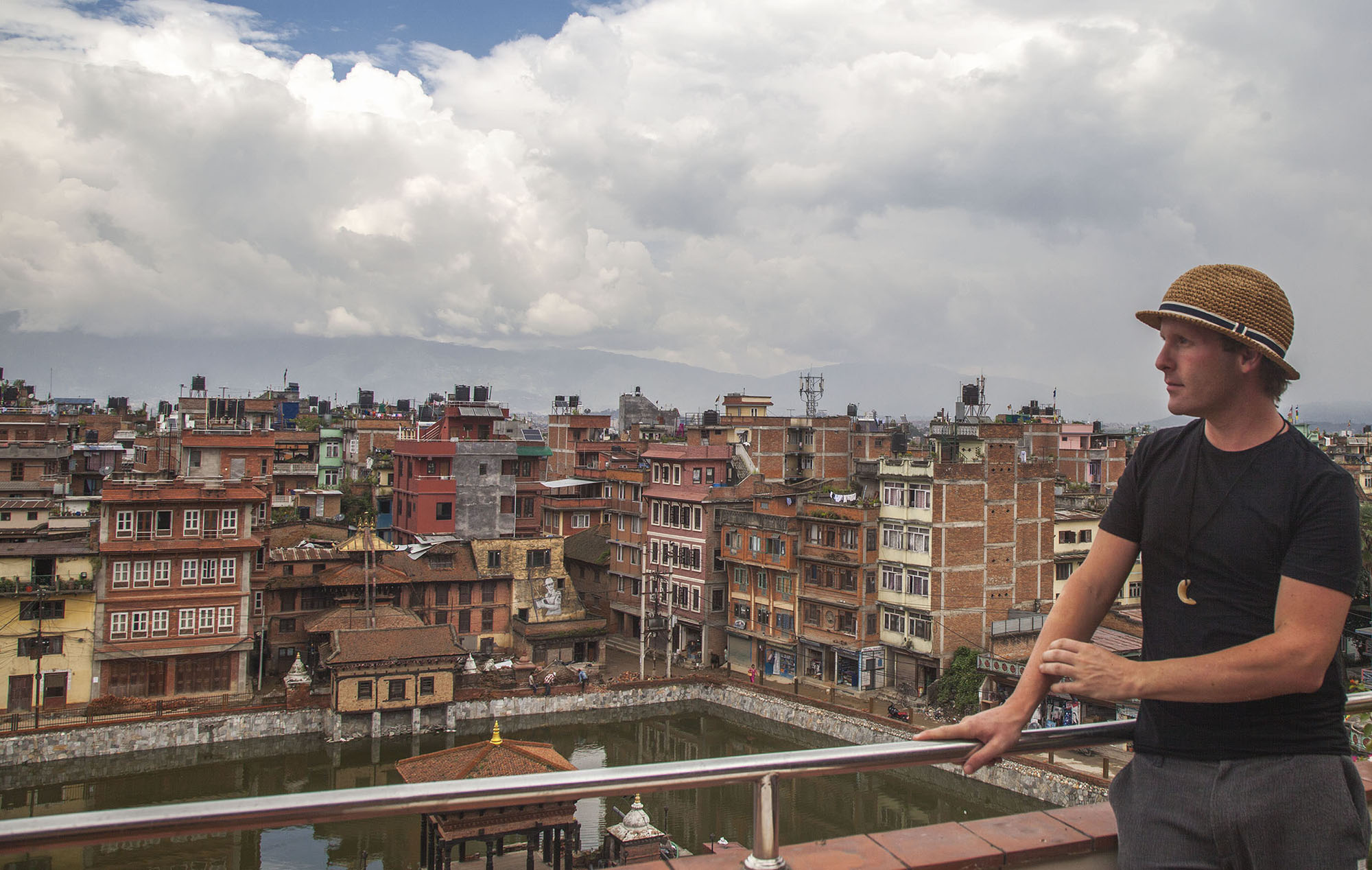
It’s no exaggeration to say I was changed — so much so that I returned years later, not as a tourist, but as a guest at the wedding of a friend I made and lived with during my first visit. Nepal had woven itself into my story.
This article will guide you through crafting your own Nepal itinerary, whether you're visiting for a week, two weeks, or longer. From the chaotic charm of Kathmandu to the tranquil lakes of Pokhara, the wildlife of Chitwan, and the endless trails of the Annapurnas, this guide will ensure your journey captures the heart of this extraordinary country.
Along the way, I’ll share personal insights and tips to help you navigate its beauty and challenges, and above all, to experience Nepal not as an outsider looking in but as a traveller connecting deeply with the people and places that make this country unforgettable.
This itinerary has been adapted and shortened for practicality. My first visit to Nepal spanned several months, part of which I spent volunteering and deeply immersing myself in the culture.
For those with limited time, I’ve created this abridged version, designed to capture the essence of Nepal in two to four weeks. It includes must-see highlights as well as a few flexible options to tailor your journey to your interests.
Travel times can be slower than expected, especially if you’re relying on local buses rather than private transport. If you’re here for just 14 days and wish to follow this itinerary (except for the optional treks), you might need to cut time short in Nagarkot or Pokhara to allow for the longer journeys (or consider flying on one of the longer routes, such as between Pokhara and Bharatpur, Chitwan).
Planning for flexibility is key to making the most of your trip.
Disclosure: This article contains affiliate links. If you make a purchase through these links, I may earn a small commission at no extra cost to you. Thank you for supporting my blog!
Solo Travel Insights from My Nepal Itinerary
The best part of travelling solo in Nepal isn’t just the breathtaking mountains — it’s the people you meet along the way. From the towering Himalayas to the busy streets of Kathmandu, the country has a way of making strangers feel like family.
When I rented a small apartment outside of Thamel, the owner, who lived on the ground floor, invited me to a dinner party within days of my arrival. There, I met his family and friends, sharing a meal and stories that felt like a warm embrace from a place that was quickly becoming my second home.

This openness isn’t rare in Nepal. Walking through its bustling streets or quieter rural villages, you’ll find that even a simple chat can lead to unforgettable connections. Many of my memories revolve around spontaneous moments: joining a group of locals for tea, exchanging smiles with shopkeepers, or meeting fellow travellers in a guesthouse.
Volunteering also opened doors to deeper connections, letting me experience life through the eyes of Nepalese families.
If I had to distill the essence of my solo journey in Nepal, I’d say it lies somewhere between the grandeur of the mountains and the simplicity of human connection.
Save this article for future reference!
Nepal Itinerary: Overview
➡ Days 1–2: Kathmandu (काठमाडौं)
Begin your adventure in Nepal’s capital, Kathmandu. Explore the historic Durbar Square, the sacred Swayambhunath (Monkey Temple), and the sprawling Boudhanath Stupa. Wander through the bustling streets of Thamel and enjoy a taste of local cuisine. Don’t miss Pashupatinath Temple for a glimpse into Nepal’s spiritual heart.
➡ Day 3: Patan (ढाँचा)
Discover the rich history of Patan, just a short trip from Kathmandu. Visit Patan Durbar Square and its surrounding temples, shrines, and courtyards. Explore the Golden Temple (Hiranya Varna Mahavihar) to immerse yourself in the city’s Newar Buddhist heritage.
➡ Day 4: Bhaktapur (ख्वप)
Step back in time in Bhaktapur, the ancient capital of the Kathmandu Valley. Admire the stunning architecture of Bhaktapur Durbar Square, visit Pottery Square, and try the famous Bhaktapur curd (juju dhau). Explore the alleys of this UNESCO World Heritage site.
➡ Days 5–7: Nagarkot (नागरकोट)
Escape to the hill station of Nagarkot for breathtaking Himalayan views. Hike through the surrounding countryside and enjoy a peaceful sunrise over the peaks. Spend your evenings unwinding with local meals.
➡ Optional (12–14 Days): Everest Base Camp (एभरेस्ट बेस क्याम्प)
For adventure seekers, embark on a trek to Everest Base Camp. This 12–14-day journey takes you through stunning mountain landscapes, traditional Sherpa villages, and high-altitude terrain. A bucket-list experience for hiking enthusiasts.
➡ Days 8–9: Bandipur (बन्दीपुर)
Travel to Bandipur, a hilltop town known for its preserved Newari architecture and stunning mountain views. Stroll through the pedestrian-only bazaar, visit the local monastery, and explore nearby villages like Ramkot for an authentic cultural experience.
➡ Days 10–12: Pokhara (पोखरा)
Unwind in Pokhara, Nepal’s adventure hub. Take a boat ride on Phewa Lake, visit the World Peace Pagoda, and hike up to Sarangkot for sunrise views. Don’t miss paragliding or exploring caves and waterfalls for a dash of adventure.
➡ Optional (15–20 Days): Annapurna Circuit (अन्नपूर्ण सर्किट)
If you have the time, take on the Annapurna Circuit, one of the world’s best trekking routes. This 15–20-day journey passes through diverse terrain, from lush valleys to high-altitude deserts, offering unparalleled views of the Annapurna Range.
➡ Days 13–14: Chitwan (चितवन)
End your trip in Chitwan National Park for a wildlife experience. Enjoy a canoe ride on the Rapti River, a guided jungle safari, and a visit to a Tharu village. Keep your eyes open for rhinos, tigers, and other incredible wildlife.
KATHMANDU (काठमाडौं) (Days 1-2)
Arriving in Kathmandu feels like stepping into a different pace of life.

On my first day, I wandered through Thamel, dodging motorbikes in narrow alleys lined with trekking shops and market stalls. The sound of temple bells cut through the noise, pulling me toward hidden courtyards where locals gathered to light butter lamps.

At Durbar Square, I spent time sitting on the ancient steps, watching the interplay of life — children chasing pigeons, street vendors calling out to passersby, and the slow rhythm of rituals unfolding at centuries-old shrines.
The second day involved a climb to Swayambhunath, the Monkey Temple. The steps were steep, but reaching the top brought a view over the valley that silenced the city’s clamour. Prayer flags fluttered in the wind, and I joined others in circling the stupa, letting the moment settle.

Later, I explored Boudhanath Stupa, where rows of prayer wheels turned under my hand as locals walked in silent meditation.
Kathmandu, to me, is layers of movement and stillness, a place where chaos and calm exist side by side.
Looking to explore the best of Kathmandu in just one day? This private tour lets you dive into the city’s rich culture and history, with stops at iconic UNESCO World Heritage sites (like Pashupatinath Temple and Boudhanath Stupa, among others).
➡ Check it out here
Top Attractions and Activities in Kathmandu
Explore the iconic Boudhanath Stupa and Swayambhunath (Monkey Temple) for their spiritual significance and panoramic views. Wander through Durbar Square’s ancient temples and hidden courtyards for a glimpse of Kathmandu's history and daily life.
But start your journey in Thamel, the city's beating heart.
Thamel
Thamel is where I began my first steps in Kathmandu, drawn by its energy and the promise of familiarity within its chaotic streets.
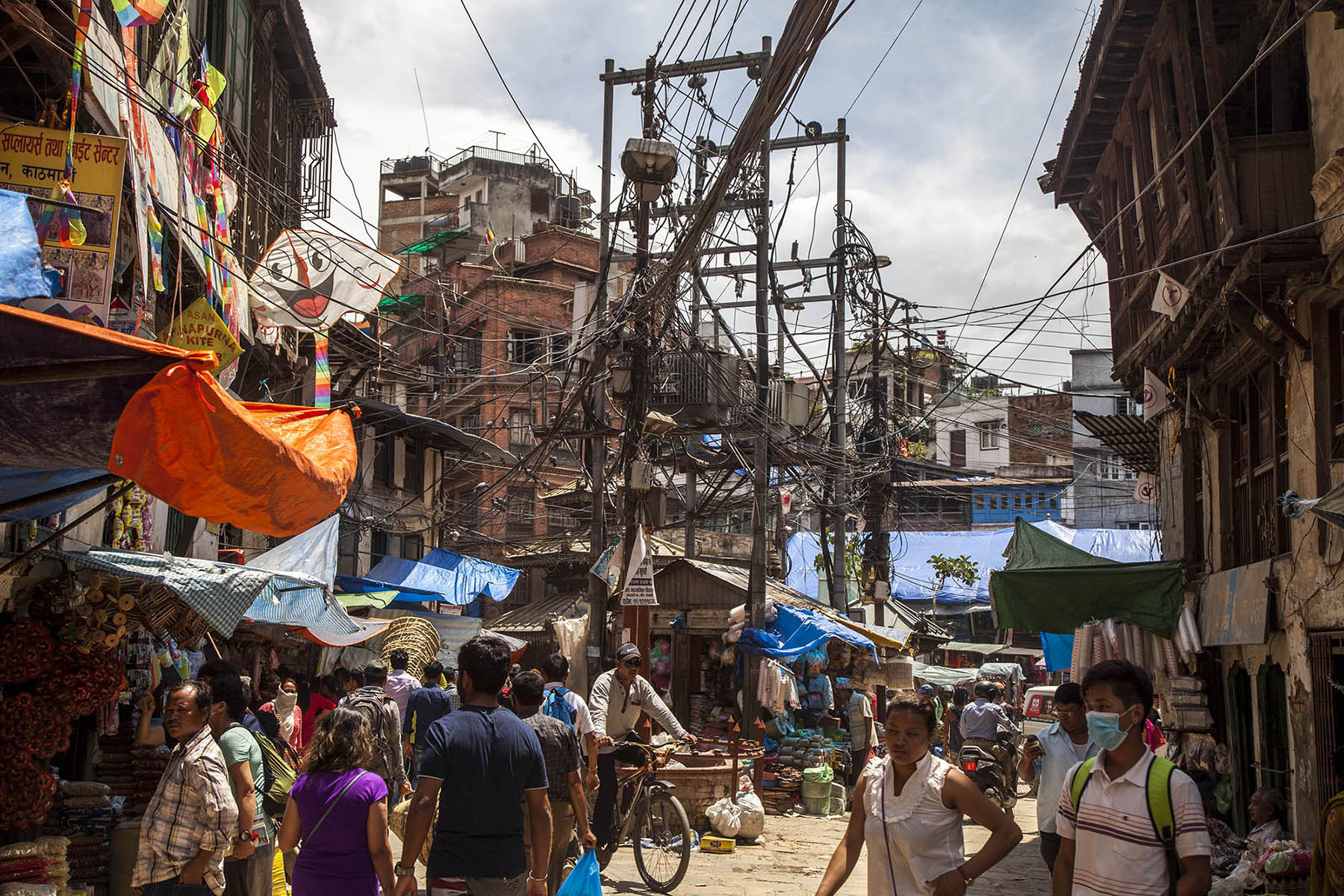
It's Kathmandu's bustling tourist district, a maze of narrow streets packed with shops, cafes, trekking agencies, and guesthouses catering to travellers from around the world.
I found myself wandering along Thamel Marg, dodging rickshaws and potholes while soaking in the eclectic vibe that still lingers from its 1970s hippie heyday. The mix of colours, sounds, and aromas was overwhelming at first — shops spilling over with woollen shawls, trekking gear, and souvenirs, with a cacophony of voices beckoning you to pause - it's a shoppers paradise.
While the hawkers and offers for “special deals” (including shady characters whispering drug offers in the ear) can be relentless, the charm lies in the unexpected — an unassuming café serving an excellent dal bhat or a quiet rooftop escape above the hustle. Haggling is essential here, whether you’re booking a trek or picking up a handmade rug.
Despite the bustle, Thamel remains a gateway to adventure, a place where every alley whispers the possibility of a journey just waiting to unfold.
I'd recommend starting by walking its main streets like Thamel Marg to get a feel for the area, but don’t hesitate to explore the quieter side lanes where hidden cafes and shops await.
Kathmandu Durbar Square
Kathmandu Durbar Square is the historical and cultural heart of the city, a place where Nepal's royal past is etched into every carved beam and weathered brick.

Once the palace complex of Kathmandu’s Malla and Shah kings, it’s now a UNESCO World Heritage site and a living testament to the city’s history. While the 2015 earthquake left parts of the square in ruins, the remaining structures and ongoing restorations ensure its significance endures.
This square is one of three in the Kathmandu Valley, alongside Patan and Bhaktapur, each belonging to a former kingdom that once ruled the region. What makes Kathmandu Durbar Square special is the layered activity — locals weaving through courtyards, craftsmen chiselling woodwork, and devotees lighting oil lamps at shrines.
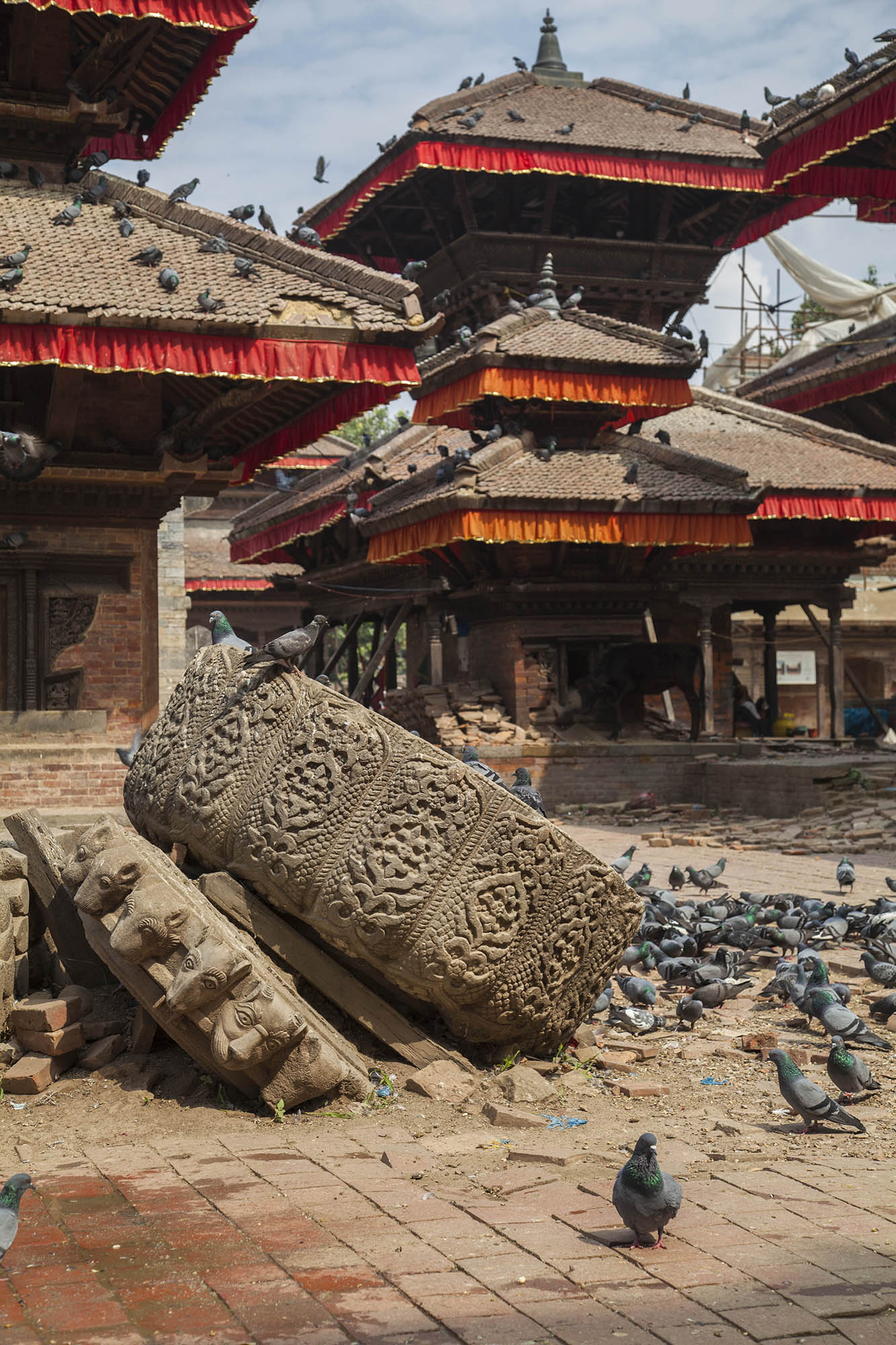
The Kumari Ghar, where the living goddess resides, offers a glimpse into a centuries-old tradition, while the towering Taleju Temple, though closed to non-Hindus, dominates the skyline. The intricacy of the Newari wood carvings is astounding, and even as scaffolding supports some damaged structures, their artistry remains undeniable.
Durbar Square is also a fantastic place to just sit and observe. From the temple steps, I saw children playing, vendors hawking trinkets, and life unfolding around me in a way that was timeless.


To deepen your understanding of the site’s history and symbolism, a guide can be worthwhile, but simply being present here is an experience in itself. It’s an essential stop that connects you with both the city’s past and its vibrant present.
A ticket costs 1,000 NPR. It's open between 10.30AM and 4.30PM Tuesday to Saturday, and until 2.30PM on Sundays. It's closed on Mondays.
Swayambhunath Temple
The path to Swayambhunath Temple begins with the climb — 365 stone steps winding their way up to one of Kathmandu's most iconic landmarks. The early morning air is cool, carrying the faint aroma of incense as you ascend, the city gradually falling away behind you.

Reaching the top, you’re greeted by the sight of the stupa, immense and serene, its watchful eyes painted on all sides, gazing over the Kathmandu Valley.
Arriving shortly after dawn or at dusk, the light's transformative, casting a warm glow over the sprawling city below. As I arrived, devotees circled the stupa, their hands brushing the prayer wheels in rhythmic motion, murmuring mantras. It felt less like visiting a temple and more like stepping into a living, breathing spiritual scene.
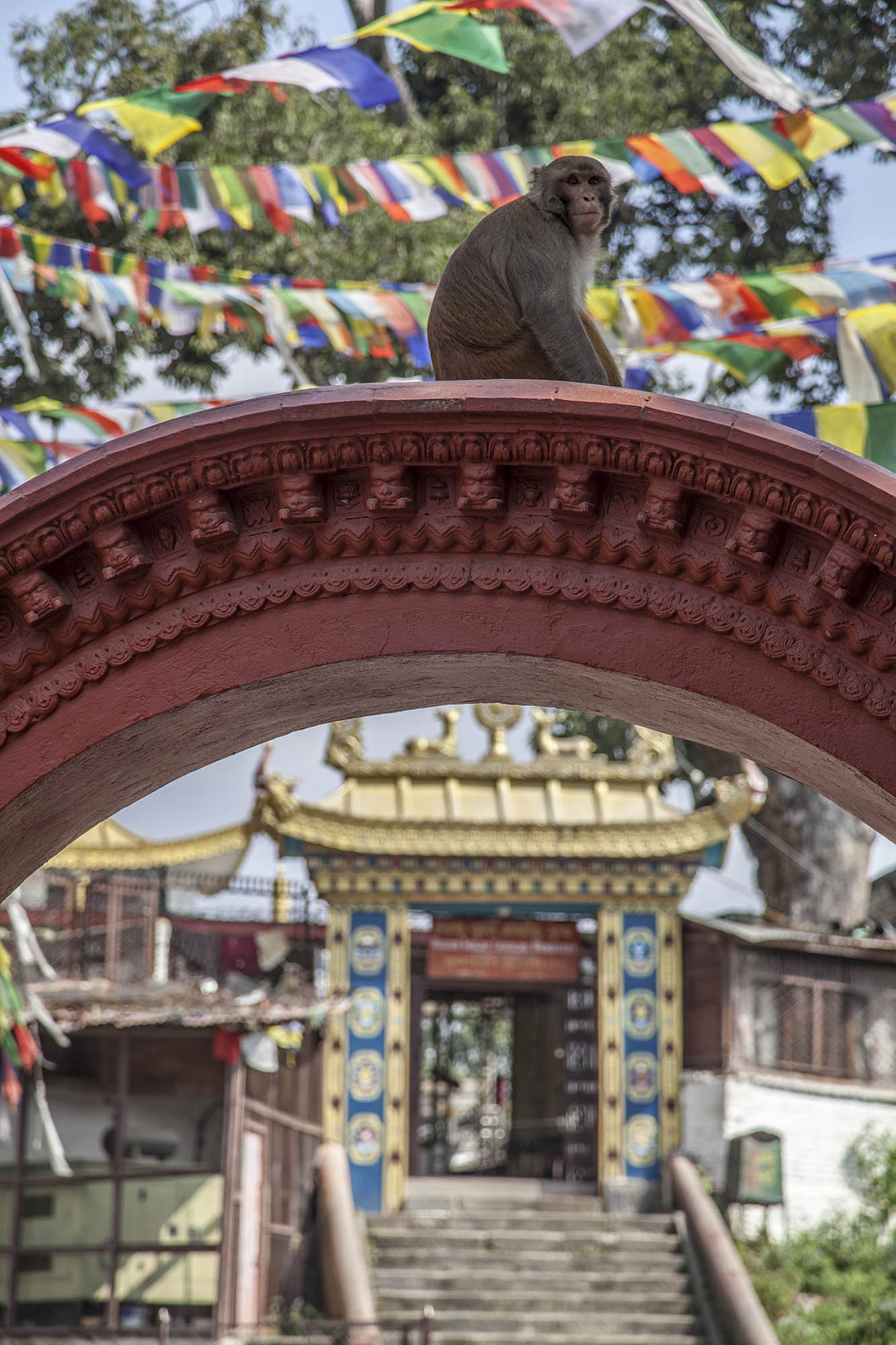
But the experience is shared with others — namely, the temple’s furry residents. Monkeys dart across rooftops and scramble up the stupa, their antics amusing until they focus on you. Keep your belongings close and your hands free; they’re opportunistic and won’t hesitate to snatch whatever catches their eye.

To fully appreciate Swayambhunath, timing is everything. Aim for the softer hours of dawn or dusk when the light and the atmosphere lend an ethereal quality to the visit. If you’re lucky, you might catch a glimpse of Kathmandu’s chaotic beauty below, framed by the golden stupa above — a juxtaposition of serenity and the bustle of everyday life.
Entrance to Swayambhunath is 200 NPR, the ticket office located on the left approximately fifty steps from the top. The temple is 3 km west of Thamel.
Pashupatinath Temple
The air grows heavier as you approach Pashupatinath Temple, one of the most sacred Hindu temples in Nepal. Set along the banks of the Bagmati River, this UNESCO World Heritage Site is both a place of worship and a stark reminder of life’s impermanence. While the temple itself is off-limits to non-Hindus, the surrounding ghats offer a deeply moving experience.

I was fortunate to visit the temple complex during Maha Shivaratri, a festival celebrating Lord Shiva that draws thousands of devotees from across Nepal and India. The temple grounds transformed into a sea of saffron-robed sadhus, flickering oil lamps, and a palpable spiritual energy. I documented the experience in a short documentary for my YouTube channel, which you can watch here:
It was a vivid reminder of the enduring significance of faith in the lives of so many.
Even on ordinary days, Pashupatinath is a place of profound reflection, somewhere that includes 518 temples, buildings and structures. The main attraction is the shining Shivalinga and Nandi, Shiva’s Bull.
The scent of incense mingles with smoke rising from funeral pyres, as families gather to perform final rites along the riverbanks. It’s humbling and deeply personal, a raw glimpse into a culture that embraces death as an intrinsic part of life.
Approach with respect and discretion — this is not a spectacle but a sacred ritual.
The temple also plays a central role in celebrating Nepal’s vibrant festivals, including Teej, a joyous occasion where women gather to honour Lord Shiva, donning bright red saris in a dazzling display of devotion. You can read more about my experience of this colourful festival here.
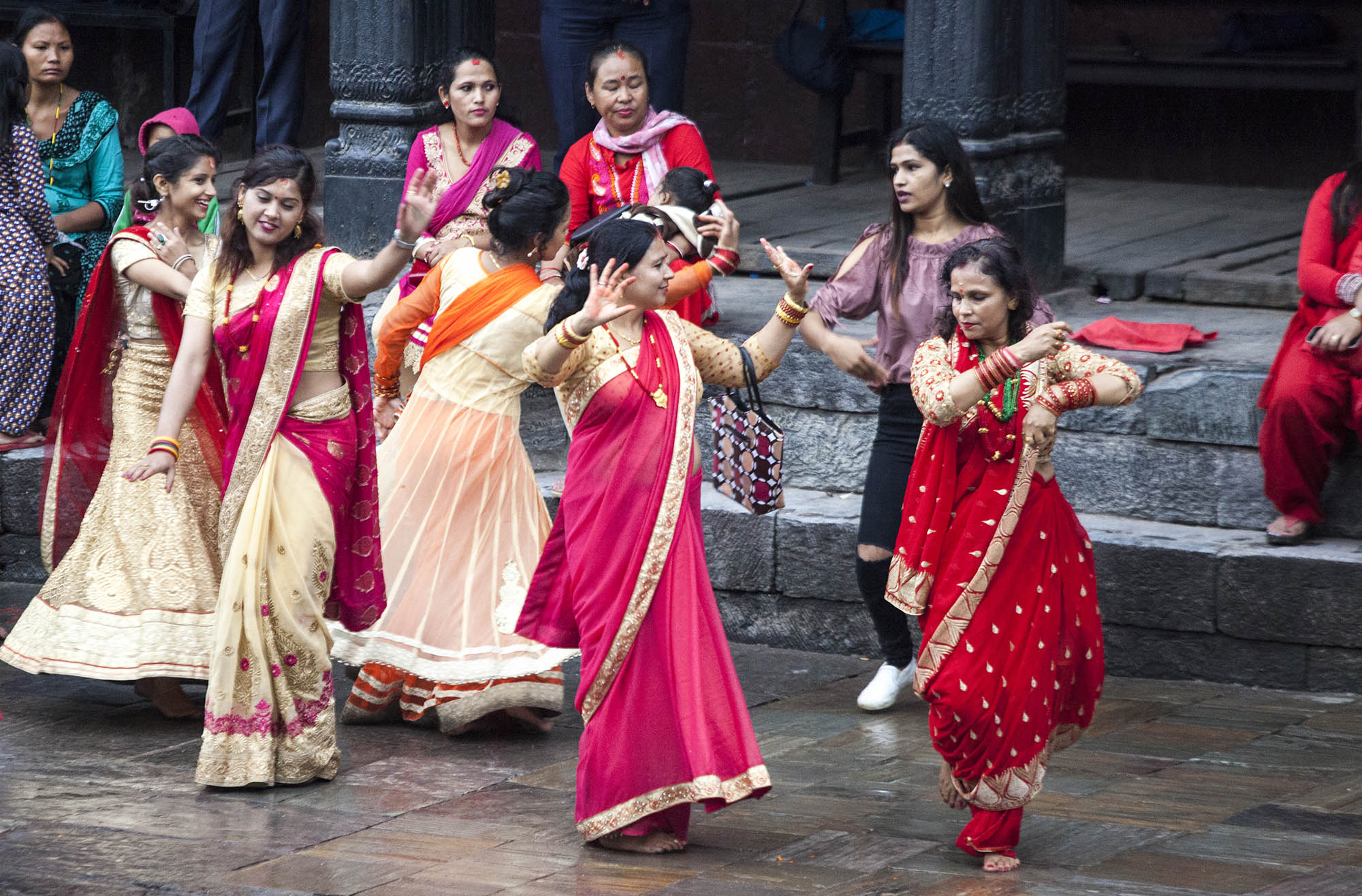
For a quieter visit, come early in the morning when the grounds are more tranquil. The sadhus — Hindu holy men adorned in saffron robes or ash — are often open to conversation, though many expect a small donation for photographs. Alternatively, watch the Aarti ceremony which commences at 6:30 PM each evening.
Pashupatinath Temple is a place where life, death, and spirituality converge in a way that is both unsettling and profoundly beautiful.
It'll set you back 1,000 NPR, and it's open between 7AM - 7PM daily.
Dive deep into the spiritual and cultural essence of Nepal with the Pashupatinath Temple, Hindu Crematorium, and Aarati In-Depth Tour. Guided by experts with a Ph.D. in the heritage of Pashupatinath, you’ll explore one of the world’s oldest Hindu temples, learn about the cremation rituals along the Bagmati River, and experience the vibrant evening Sandhya Aarati ceremony.
This tour offers a rare blend of mythological insights and scientific perspectives for a truly enlightening journey.
➡ Book your unforgettable experience here
Boudhanath (aka Boudha) Stupa
The sheer scale of Boudhanath Stupa is breathtaking, even from a distance. Towering above its surroundings, this massive white dome crowned with all-seeing eyes is one of the largest stupas in the world and a central hub for Tibetan Buddhism in Nepal. Its golden spire glints in the sunlight, while colourful prayer flags ripple in the breeze, sending mantras into the heavens.

I visited Boudhanath several times, each visit offering a slightly different experience depending on the time of day. Early mornings are meditative, with the soft hum of chants as monks and devotees circumambulate the stupa, spinning prayer wheels and murmuring ancient mantras. In the evening, the square takes on a magical glow as butter lamps are lit and the air fills with the scent of incense.
For first-time visitors, start by joining the kora — the clockwise walk around the stupa — a practice rooted in reverence and mindfulness. As you walk, take in the intricate details of the structure: the 13 steps symbolising the path to enlightenment, the vivid murals on nearby walls, and the eyes that seem to follow your every move, representing Buddha's watchful wisdom.

Around the stupa’s base, you’ll find a mix of traditional and modern influences: Tibetan monks draped in crimson robes, local artisans selling mandala paintings, and cosy cafes offering a serene spot to admire the view. Take a seat on a bench for an hour or so, and take in the intoxicating mix of prayers, pilgrims, chanting, incense and beggars.
If you're seeking souvenirs, this is the place to find intricately crafted Tibetan handicrafts — just be prepared to haggle a little. And don’t miss sampling a bowl of thukpa (a Tibetan noodle soup) or a plate of momos (dumplings) at one of the local eateries nearby.
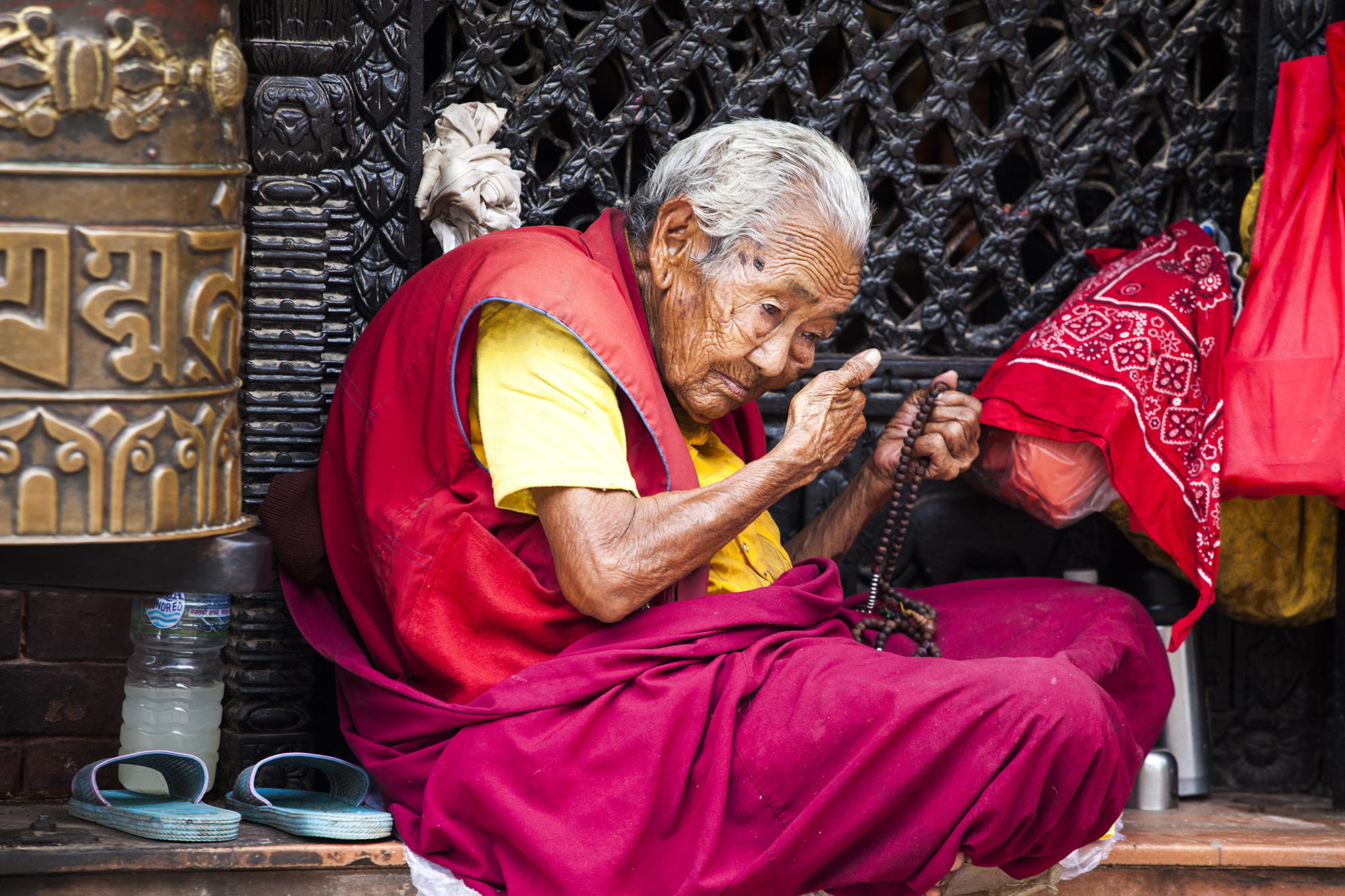
For ideal views of the Stupa, head to the rooftop restaurant Stupa View. The views are more incredible than the prices.
Boudhanath, or simply Boudha as locals call it, is a living testament to Nepal’s deep spiritual heritage.
Kopan Monastery
High above the hustle and bustle of Kathmandu, Kopan Monastery offers a peaceful retreat for the mind and soul. Nestled on a hill just north of Boudhanath, this Tibetan Buddhist monastery is renowned for its tranquil environment and its teachings on mindfulness and meditation.

When I visited Kopan, the journey itself was transformative. The climb (in a car) up winding paths offered glimpses of daily life in the villages, punctuated by the sound of prayer flags fluttering in the wind. As I approached the monastery, the noise of the city faded, replaced by the stillness of the air and the occasional ringing of bells.
The monastery grounds are open to visitors daily, except during specific retreats. Start by exploring the prayer halls with intricate thangkas and golden statues of Buddha.
The garden offers panoramic views of the Kathmandu Valley, a peaceful spot to sit and reflect.

Many visitors join guided meditation sessions or participate in the introductory courses on Buddhist philosophy — perfect for anyone seeking clarity or a moment of stillness.
Mornings are ideal to catch the light spilling over the valley, while afternoons can be a bit busier with day-trippers. Dress modestly, respecting the sanctity of the space, and take time to observe the quiet dedication of the monks as they go about their routines.
Kopan is a space to pause, to disconnect from distractions, and to reconnect with yourself.
It's open between 10AM - 4PM daily. Entry is free.
Garden of Dreams (Kaiser Mahal)
The Garden of Dreams, also known as Kaiser Mahal, is a beautifully restored neo-classical garden tucked away in the bustling chaos of Kathmandu, a contrast to the dusty streets outside.
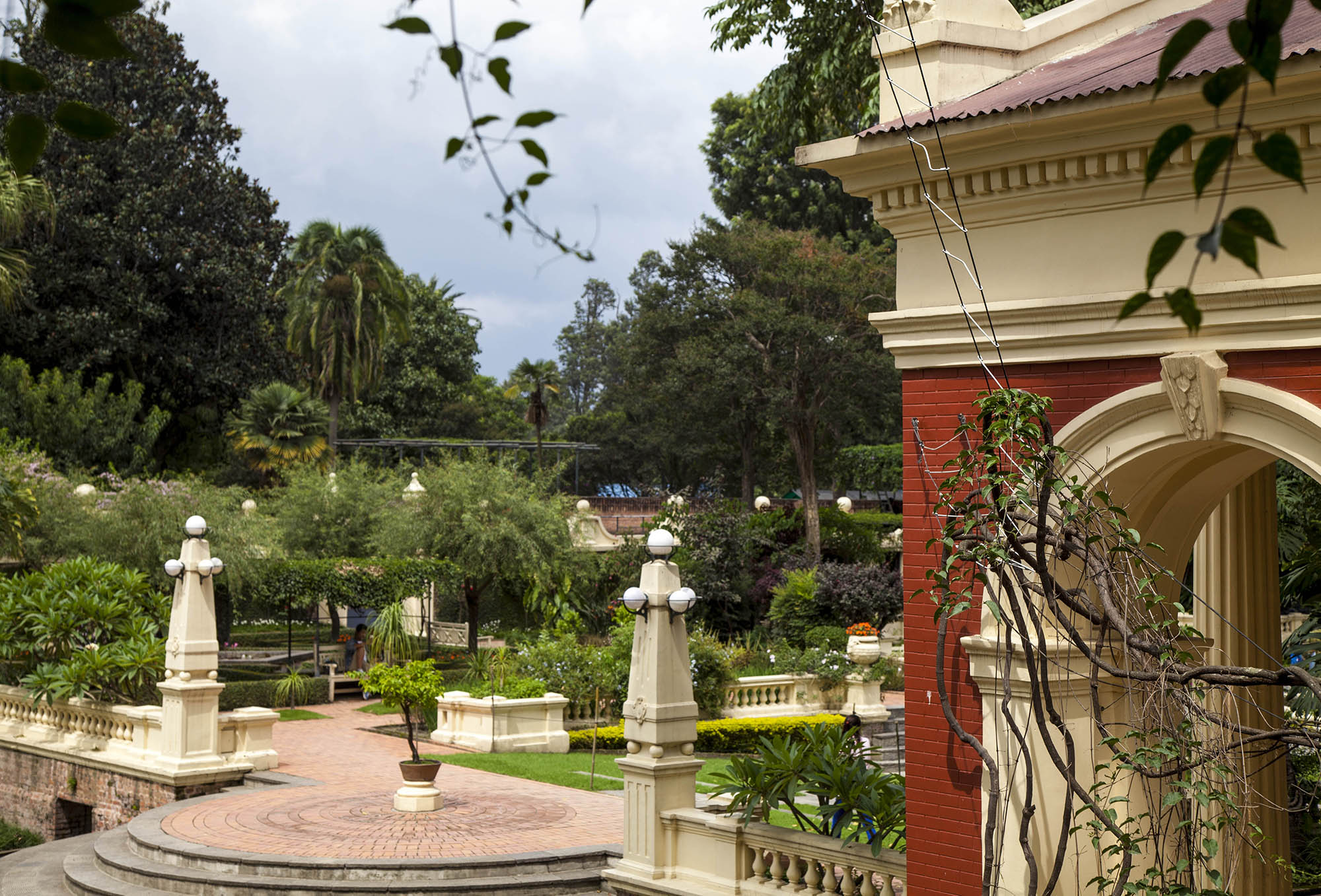
Its design seems European, with pillared gazebos and stone pathways weaving through the space. I came here a few times. Sometimes it was to sit quietly away from the noise of Kathmandu, other times to meet with new friends.
Once, I conducted an interview with Mingma, a man routinely on the summit of Mt Everest, among many of the world's other tallest mountains.
It’s the kind of place where people come to be still. You’ll see couples lounging on the grass, others sharing quiet conversations. The entry fee is modest, and there’s a small restaurant inside if you want something to eat.
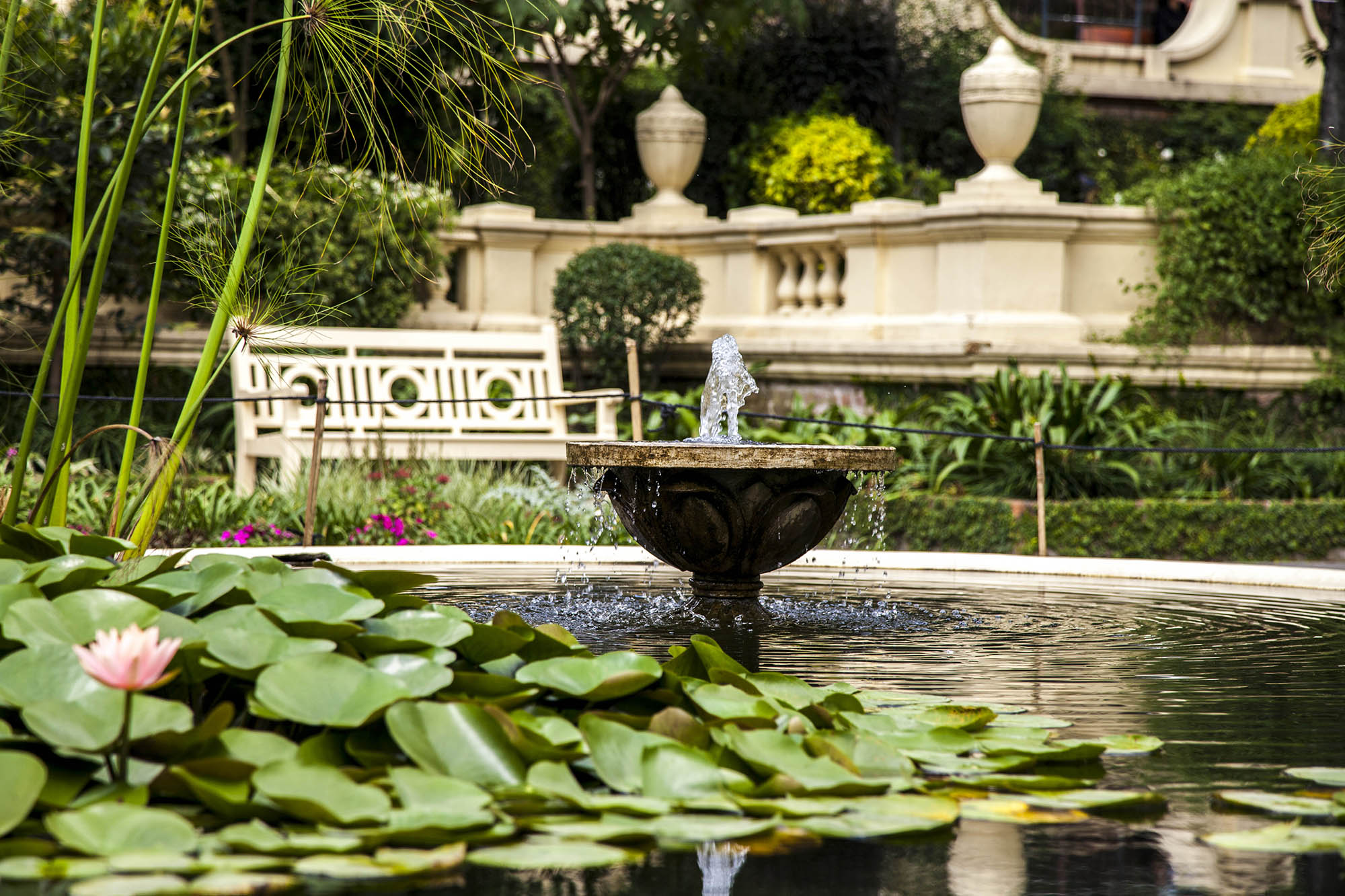
The garden isn’t large, but it’s enough. Enough to offer a break, to reflect, or just to sit and watch the light change in a way the city rarely lets you.
It's open 9AM to 9PM daily. You'll need to purchase the ticket at the entrance and it'll set you back 400 NPR.
Asan Tole
Asan Tole is one of Kathmandu’s busiest market squares, where tradition and daily life collide. Known for its tightly packed stalls and vendors, it’s a place to find everything from fresh spices and produce to local textiles and religious items.

When I visited, the square buzzed with energy — the calls of vendors, the shuffle of shoppers, and the occasional clang of temple bells in the background. Annapurna Temple, a small shrine dedicated to the goddess of abundance, anchors the square, seamlessly blending the sacred with the everyday.
If you’re planning a visit, mornings are calmer, but the evening crowds bring an electric atmosphere. It’s a perfect spot to observe local life, pick up unique finds, and practice your haggling skills.
Accommodation - Staying in Kathmandu
I personally hired an apartment and later stayed with locals during my time in Kathmandu.


The city, from what I saw while out and about on foot, offers a range of options from budget hostels to boutique hotels, particularly in areas like Thamel.
Budget: Thamel Heritage Hostel
Thamel Heritage Hostel is a new budget-friendly option in the heart of Kathmandu, offering a blend of comfort and convenience. Located just 700m from Thamel Chowk and 1.4km from Kathmandu Durbar Square, it’s an ideal base for exploring the city.
The hostel features air-conditioned rooms with city views, a garden, a terrace, and a bar for relaxing after a day out. With a variety of breakfast options and an on-site restaurant catering to different dietary preferences, it’s a welcoming spot for budget travellers. Bike and car rentals are also available for those looking to explore further afield.
Mid-Range: Hotel Thrive, A Tropical Courtyard
Hotel Thrive, A Tropical Courtyard is a comfortable mid-range option in Kathmandu, located just 1km from Hanuman Dhoka and close to popular attractions like Swayambhu and Thamel Chowk. The hotel features air-conditioned rooms with modern amenities, including private bathrooms, flat-screen TVs, and some with balconies offering city views.
You can relax in the lush garden or enjoy meals at the on-site restaurant serving Chinese cuisine. With a fitness centre, terrace, and a variety of breakfast options, it’s a convenient and relaxing base for exploring the city.
High End: The Dwarika's Hotel
The Dwarika's Hotel in Kathmandu is a luxurious high-end property that seamlessly blends heritage, sustainability, and world-class comfort. Known for its stunning traditional Nepali architecture and commitment to cultural preservation, staying here feels like stepping into Nepal’s rich history.
The hotel takes pride in its organic and eco-friendly ethos, from farm-to-table dining to in-house spa products inspired by ancient Ayurvedic and Himalayan practices. With its attention to detail, serene atmosphere, and focus on sustainability, The Dwarika's offers an unforgettable experience for those seeking both luxury and cultural immersion.
Food - Eating in Kathmandu
When it comes to eating in Kathmandu, the city offers an incredible variety of flavours and dining experiences, from street food to hidden rooftop spots.
During my time there, I explored a mix of local and international options, many of which I’ve detailed in this article on 10 Great Kathmandu Eats.
Do keep in mind that Kathmandu’s dining scene is ever-changing. Restaurants can open and close quickly — sometimes without notice — so it’s always a good idea to check reviews or ask locals for up-to-date recommendations before heading out.
Whether you’re craving momos, dhal bhat, or a slice of pizza, there’s something to suit every appetite.
Curious about Kathmandu’s hidden culinary gems? This secret food tour takes you through bustling markets, hidden alleys, and local eateries to sample traditional Nepali dishes, drinks, and snacks. Led by knowledgeable guides, you’ll not only taste incredible food but also uncover the history and culture behind it.
➡ Discover the flavours of Kathmandu and book your spot here
Transportation - Getting around Kathmandu
Getting around Kathmandu can be an adventure, but it doesn’t have to be overwhelming once you know your options. From walking through narrow streets to hopping on a local bus, here’s what to expect when navigating the city.
On Foot
Walking is often the easiest way to get around central areas like Thamel or Durbar Square, especially since traffic can be unpredictable. The streets are lively, with shopkeepers calling out, motorbikes weaving past, and temples tucked into unexpected corners.
Sidewalks are rare, nobody stops at pedestrian crossings (which begs the question: why are they there?) so you’ll need to share the road with others, but walking gives you a chance to notice details you’d miss otherwise.
By Taxi
Taxis are a practical option, especially for longer distances or when you’re carrying luggage. They don’t use meters, so you’ll need to agree on a price before starting the trip.
It can feel awkward negotiating, but it’s expected — most short trips within the city cost between 400-700 NPR. If you’re unsure what’s fair, ask your hotel or a local for advice beforehand.
By Bus or Microbus
If you’re on a budget and don’t mind a bit of trial and error, Kathmandu’s local buses and microbuses can be a fun way to get around. They’re cheap (usually under 50 NPR), but routes and stops aren’t always clear, as they’re usually announced in Nepali.


Locals are often happy to point you in the right direction if you ask. Just be prepared for a surprise or two — like the lady next to me, casually carrying a chicken in her bag. Apparently, the chicken paid less than I did!

These buses are best for well-known destinations like Boudhanath or Patan.
By Rickshaw
Rickshaws are a quirky and slower way to travel short distances, like moving between markets or tourist spots. Drivers are usually friendly, but fares can vary wildly, so always agree on a price before hopping on.

It’s not the most efficient way to get around, but it’s a memorable experience.
By Ride-Sharing Apps
Pathao and Tootle are popular ride-sharing apps in Kathmandu, offering motorbike and car rides at lower rates than taxis. They’re reliable, easy to book, and great if you’re not in the mood to haggle over fares.
Just make sure you’ve got mobile data to use the apps.
Renting a Motorbike or Scooter
For those who like independence and don’t mind Kathmandu’s chaotic traffic, renting a motorbike or scooter can be a great option. Rentals usually cost 1,000-1,500 NPR per day. Helmets are mandatory, and navigating the city can take some getting used to, as road rules are more like loose suggestions.
Double-check your travel insurance to make sure motorbike use is covered.
Transportation - Getting to Kathmandu
Reaching Kathmandu is straightforward, with plenty of options depending on where you’re coming from. As Nepal’s capital and main hub, it’s well-connected by air and road, though each option comes with its quirks.
By Air
Tribhuvan International Airport (TIA) in Kathmandu is Nepal’s only international airport, so it’s likely where you’ll land if you’re flying in. Flights connect the city to major hubs like Delhi, Bangkok, Doha, and Istanbul, among others and domestic locations. The airport is small and can feel chaotic, especially during peak trekking seasons, but immigration and baggage claims are manageable if you’re patient.

Once you arrive, getting from the airport to the city is easy. Taxis are available just outside the terminal, but be ready to negotiate. A ride into Thamel or central Kathmandu typically costs around 800-1,000 NPR. Prepaid taxis are also available at slightly higher rates but can save you the hassle of bargaining after a long flight.
By Bus or Jeep (From India)
If you’re travelling overland from India, Kathmandu is accessible via border crossings like Sonauli or Raxaul. From there, long-distance buses or shared jeeps take you to the capital. These journeys are budget-friendly but can be long and tiring, often taking 8-10 hours depending on road conditions.
Opt for a tourist bus if comfort is a priority, as they’re less crowded and make fewer stops compared to local options. While buses are reliable, shared jeeps are faster and a bit more adventurous, though you’ll be crammed in with other passengers and their luggage.
By Private Vehicle
For more flexibility and comfort, hiring a private car or jeep is a good option, especially if you’re coming from nearby cities like Pokhara or Chitwan. The roads to Kathmandu wind through beautiful mountain scenery, but they’re also narrow and bumpy in parts, so trips can take longer than expected.
Hiring a vehicle with an experienced driver is recommended if you’re unfamiliar with Nepalese roads.
PATAN (ढाँचा) (Day 3)
Patan, or Lalitpur, lies just across the Bagmati River from Kathmandu, offering a slower pace and a glimpse into Nepal’s rich tradition of craftsmanship. Known for its intricate architecture and thriving community of artisans, Patan feels distinct yet deeply connected to the rhythm of the Kathmandu Valley.

Spend your day exploring its courtyards and temples, discovering a city where history lives not in monuments alone but in the daily work of craftsmen shaping metal, wood, and stone. Unlike Kathmandu’s energetic streets, Patan’s alleys invite quiet wandering, offering a sense of intimacy often hard to find in larger cities.

While one day is enough to explore its main attractions, Patan leaves an impression that lingers, drawing you back to its quiet charm and enduring artistry.
Top Attractions and Activities in Patan
Patan, one of the oldest cities in Nepal, is known for its remarkable Newari architecture and rich cultural history. Explore its Durbar Square, centuries-old temples, and the hidden courtyards where traditional artisans still work today.
Want to explore Patan in just three hours? This small-group walking tour (max 10 people) takes you through the city’s ancient streets, from Patan Dhoka to Patan Durbar Square and the iconic Golden Temple. Learn about Newar Buddhism, Malla King history, and Nepalese architecture while visiting temples, shrines, and the Patan Museum.
➡ Discover more and book your tour here
Patan Durbar Square
Patan Durbar Square is a living testament to a city that refuses to let history fade quietly. As I stepped into the square (after purchasing a ticket), the first thing I noticed was the interplay of old and new: intricately carved temples standing shoulder to shoulder with scaffolding, reminders of the 2015 earthquake and the ongoing efforts to preserve this UNESCO World Heritage site.
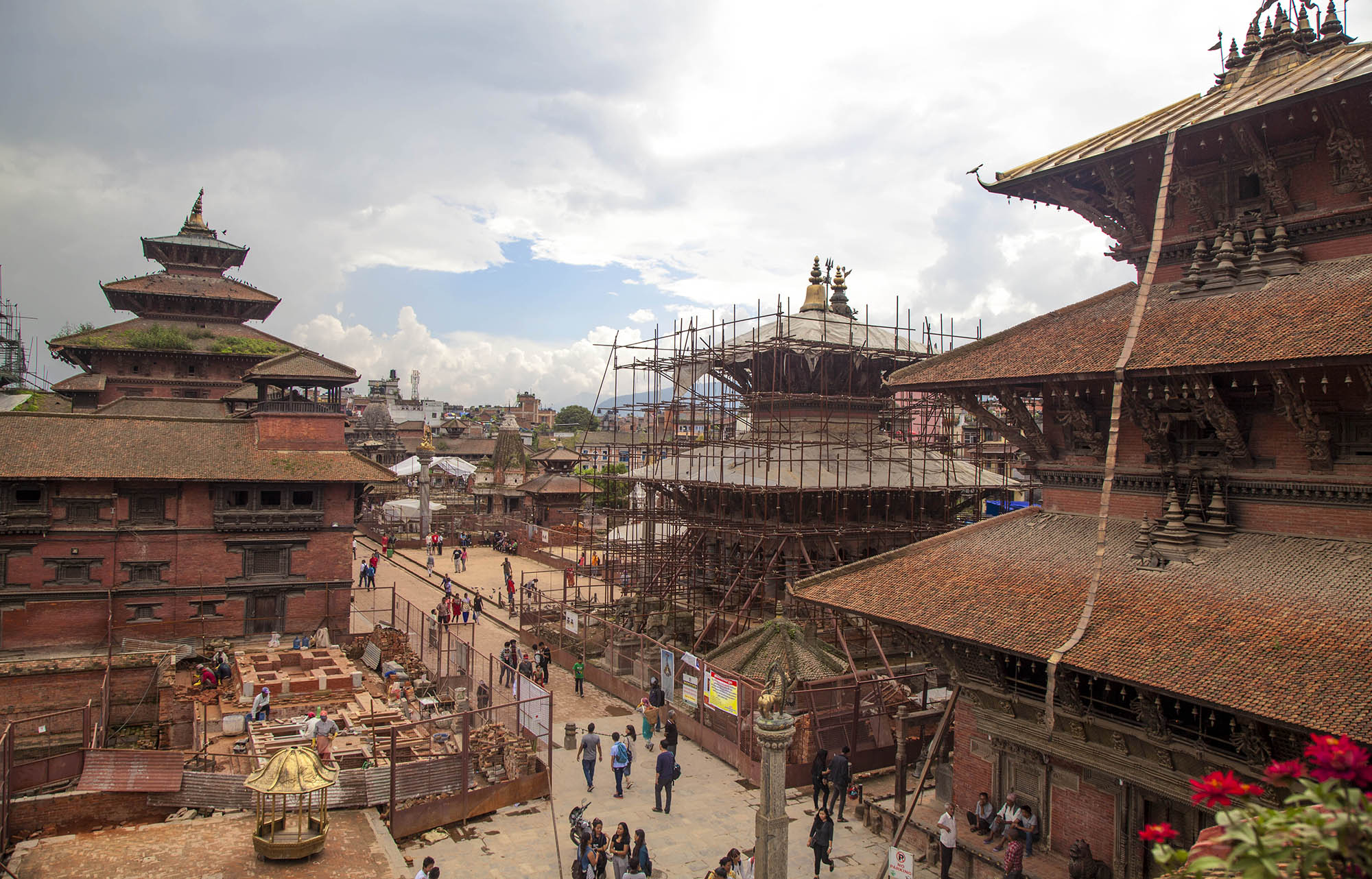
Yet, the square feels anything but somber. It’s alive with activity — locals chatting on temple steps and vendors selling brassware and beads.

I spent hours here, starting at the Krishna Mandir, a stone temple unlike any other in Nepal, its carvings as intricate as lacework. Nearby, the Bhimsen Temple stood wrapped in scaffolding, yet its towering presence was no less impressive.
One of my favourite moments was watching artisans work in the square’s many courtyards, their hands moving deftly over clay and metal — traditions passed down through generations.
When I needed a break, I climbed to a rooftop café, ordered tea, and let the view sink in. From above, the square’s organised chaos transforms into a harmonious dance of life and history.

A guide isn’t strictly necessary, but hiring one can reveal the stories behind the structures — the king who dreamed of Krishna, the Newar craftsmen who shaped the city, and the resilience of a place that carries its scars with dignity.
The square is open daily from 7 AM to 7 PM, and the entrance fee for foreigners is 1,000 NPR.
Golden Temple (Hiranya Varna Mahavihar)
Tucked away in the heart of Patan, the Golden Temple, or Hiranya Varna Mahavihar, is a gem of devotion. This 12th-century Buddhist monastery is renowned for its gilded façade and intricate carvings.

As you step through the stone entrance, you’ll find yourself in a quiet courtyard dominated by a golden stupa and prayer wheels. The main shrine glows with the warm hue of gold, while smaller details, such as carvings of mythical creatures and miniature stupas, invite closer inspection.
The temple has a storied past, including a legendary duel between a Brahman and a Buddhist priest, with the latter triumphing in dramatic fashion — a severed head from this tale is said to be used in rituals to this day.
The temple is still an active site of worship - I saw devotees moving about and lighting butter lamps. I was welcome to explore freely, but modest attire was a must.

Entry for foreigners is 100 NPR (which is separate to the Patan Durbar Square ticket price).
Pimbahal Pond
Pimbahal Pond, just a short walk from Patan Durbar Square, offers a quiet space to appreciate your surroundings. This historic water reservoir, originally built in the medieval period, serves as both a functional resource and a retreat. It’s not uncommon to see locals gathering by its edges, some washing clothes, others chatting in the shade of the surrounding trees.

When I first stumbled upon Pimbahal Pond, I wasn’t looking for it. I had followed an unplanned turn in the maze of Patan’s alleys, and the sight of its still waters stopped me in my tracks. The pond seemed to slow everything down — even the air felt lighter here. A lone bird skimmed the water’s surface, and the reflections of traditional Newari houses rippled in the breeze.

Wanting to capture the perfect perspective, I noticed the rooftop of Tajaa Pha The Heritage Home, asked the kind receptionist if I could head up, and she graciously agreed — allowing me to snap some unforgettable shots of the view.
While Pimbahal Pond doesn’t carry the grandeur of Patan’s temples, its charm lies in its simplicity and purpose. It's a slice of everyday life, a place that still plays a part in the community’s rhythm.
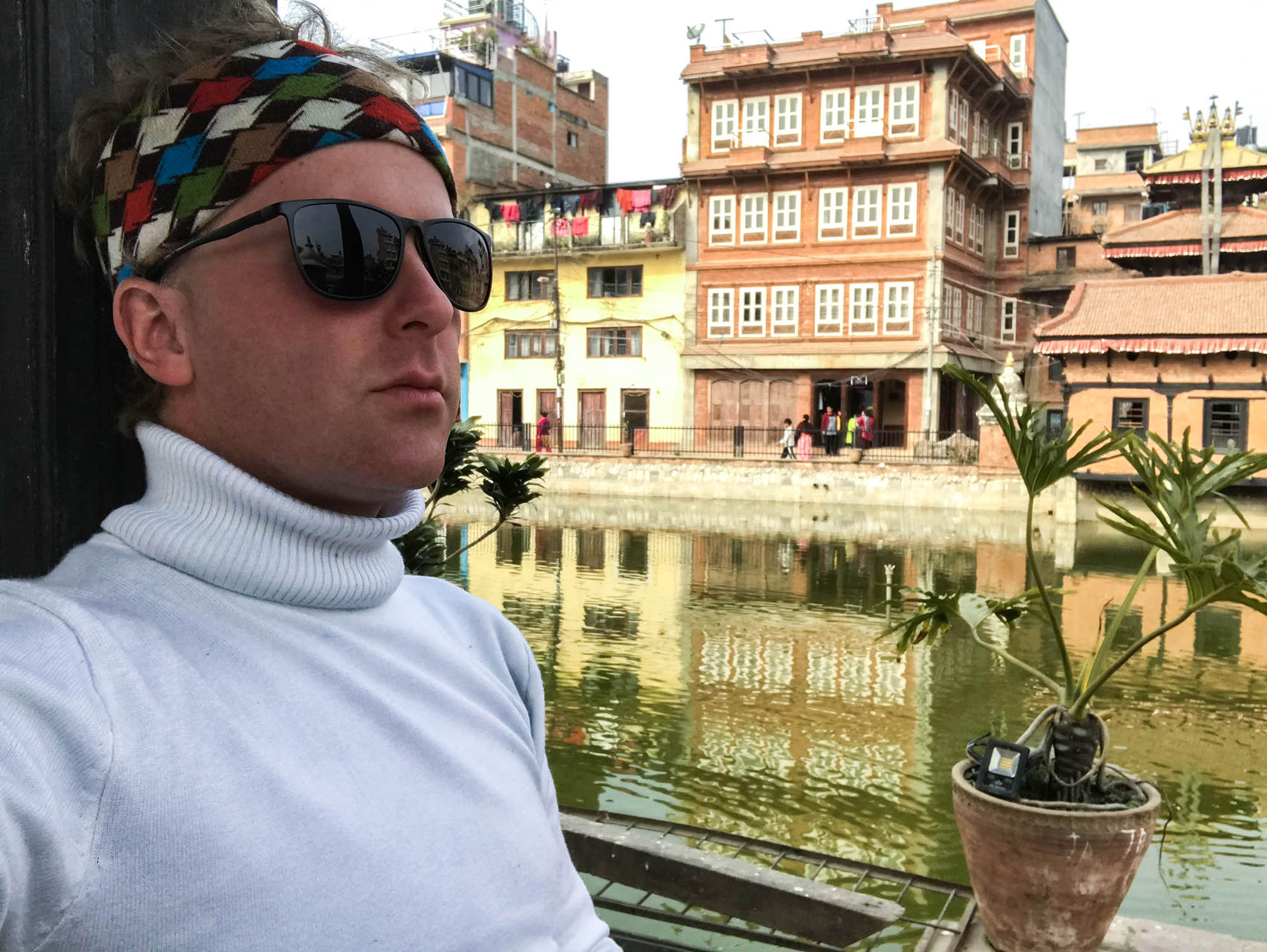
There’s no entry fee, no set hours; it’s open, like the sky above, for anyone who happens to wander by.
Mangal Bazaar
Mangal Bazaar, the bustling heart of Patan, offers a snapshot of daily life infused with centuries of history. Unlike the grandeur of Patan Durbar Square, Mangal Bazaar feels more intimate, a place where tradition and commerce seamlessly intertwine.

Here, the rhythm of life beats steadily: shopkeepers haggle over brassware and textiles, children dart between pedestrians, and the aroma of freshly fried samosas wafts through the air. It's the kind of place where you could wander without a plan, letting the alleys pull you into their maze of tiny workshops and hidden courtyards.
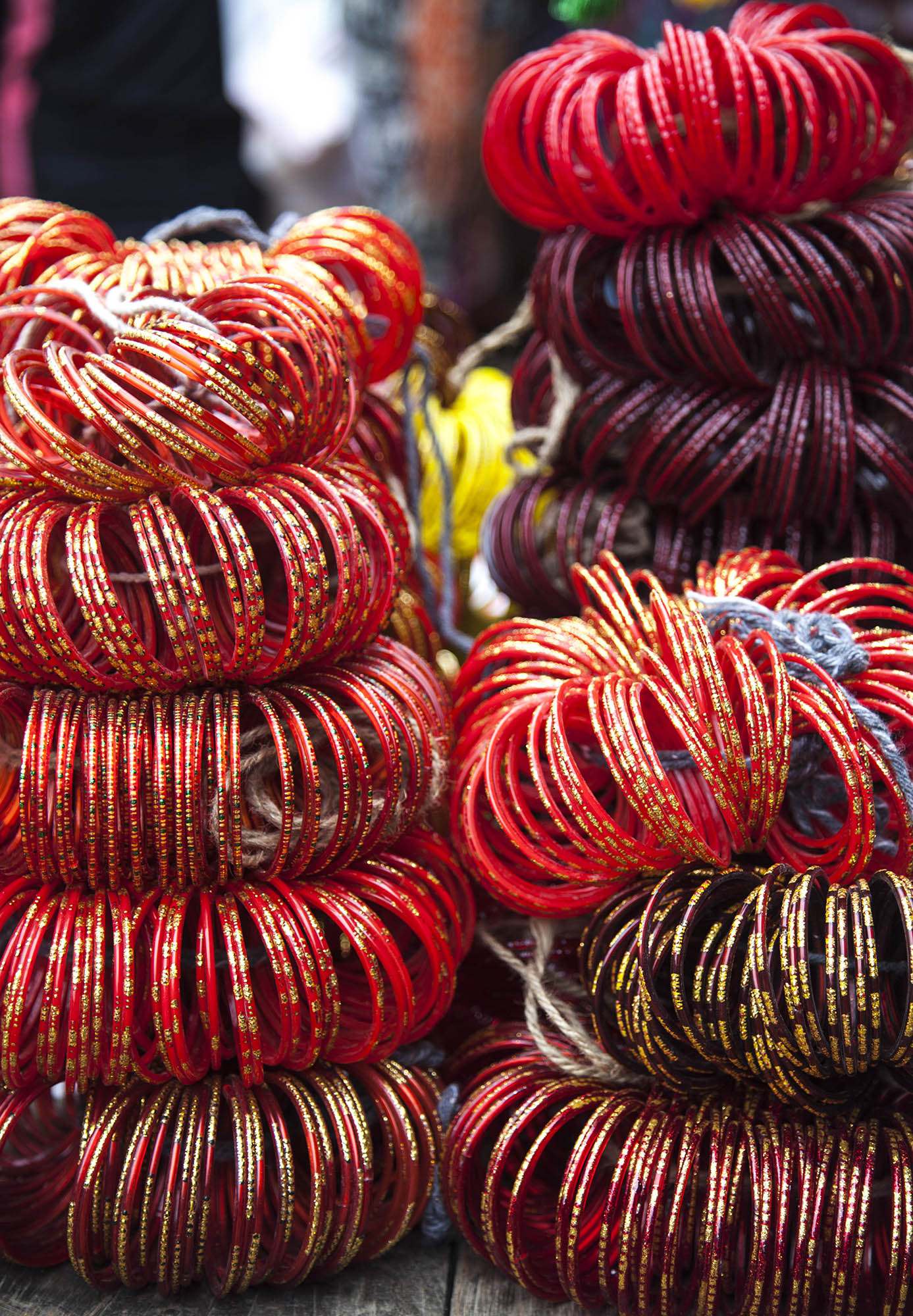
A short stroll from Patan Durbar Square, Mangal Bazaar is less about monuments and more about moments — a living, breathing reminder that history isn’t always confined to temples and palaces.
Accommodation - Staying in Patan
Although I only visited Patan as a day trip while staying in Kathmandu, it struck me as a quieter, more relaxed alternative to the capital. The area around Patan Durbar Square seemed to have several charming boutique hotels and guesthouses, offering a mix of traditional Newari architecture and modern comforts.
If you’re looking for a base with fewer crowds but still within easy reach of Kathmandu, Patan could be an ideal choice.
Budget - Mid-Range: Boutique Heritage Home
Boutique Heritage Home is a delightful budget-to-mid-range bed and breakfast set in a historic building just 200 metres from Patan Durbar Square. With its charming garden, sun terrace, and personalised service, it offers a peaceful retreat in the heart of Patan.
Some rooms feature modern amenities like satellite TVs and fully equipped kitchens, while the continental breakfast and on-site coffee shop add to the cosy, welcoming vibe. It’s a perfect choice for travellers looking for character, comfort, and proximity to local attractions.
Mid-Range: The Inn Patan
The Inn Patan is a charming mid-range option located in the heart of Patan, combining traditional Nepali architecture with modern comforts. The rooms are cosy and well-equipped, with private bathrooms, work desks, and free WiFi. Guests can enjoy a peaceful courtyard, a terrace, and a Nepalese restaurant serving delicious local dishes.
Its central location makes it ideal for exploring Patan, and the warm hospitality ensures a comfortable and memorable stay.
Food - Eating in Patan
While exploring Patan, I stopped at a rooftop restaurant overlooking Durbar Square, where the views were just as memorable as the food. Sitting under colourful umbrellas, I watched the quiet bustle of the square below — locals passing by, scaffolding rising against centuries-old buildings, and the faint hum of daily life.
I can’t recall the name of the place, but it felt like one of those simple, unpretentious spots where time slows down, and the atmosphere takes over.
Patan has no shortage of small eateries, rooftop cafes, and hidden gems serving authentic Nepali dishes or quick, tasty snacks. Menus are often presented on front doors or in entryways.
Transportation - Getting around Patan
Patan’s compact size makes it easy to explore.
On Foot
The best way to get around is often on foot. The narrow streets and hidden courtyards are full of surprises, from small temples to artisan workshops, making walking both practical and rewarding.
However, be mindful that some streets may double as work sites, with construction or repairs in progress.

Occupational health and safety (OH&S) standards can differ in the developing world, so exercise caution and watch your step as you navigate these areas.
By Bus or Microbus
Local buses and microbuses connect Patan to other parts of the Kathmandu Valley, including Kathmandu itself. They’re cheap but can be confusing for newcomers — ask locals for guidance if you’re unsure about routes.
By Rickshaw
For short trips within Patan, rickshaws provide a charming way to navigate the area.
By Taxi or Rideshare
For longer distances or if you’re venturing out of Patan, taxis are a reliable option. Be sure to negotiate the fare beforehand, as meters are rarely used.
Alternatively, ride-sharing apps like Pathao or Tootle are convenient and often more affordable.
Transportation - Getting to Patan
Patan is just across the Bagmati River from central Kathmandu, making it easily accessible.
On Foot
For those who enjoy walking, the journey from central Kathmandu to Patan can be done on foot. The 8km journey took me 1.5 hours, and offered a chance to experience the bustling streets along the way. Many roads were muddy and they were framed by crumbling homes post-earthquake.
By Bus or Microbus
If you prefer public transport, local buses and microbuses regularly run between Kathmandu and Patan, with routes heading toward Patan Dhoka or near Durbar Square. While inexpensive (usually under 30 NPR), they can be crowded and may require some patience.
I took a bus back to Kathmandu as I didn't want to repeat the 8km walk I'd taken on the way to Patan. It cost 20 NPR.
By Taxi or Rideshare
A taxi ride from Thamel or Kathmandu Durbar Square typically takes around 20-30 minutes, depending on traffic, and costs 400-700 NPR if you negotiate the fare.
BHAKTAPUR (ख्वप) (Day 4)
Bhaktapur, or Khwopa, feels like a city suspended in time. The moment you step through its gates, the modern world fades, replaced by the rhythm of everyday life unfolding against a medieval backdrop. Women lay grains to dry in open courtyards, potters shape clay with practiced hands, and the echoes of woodcarvers at work drift from shadowed workshops.

The city’s squares — Durbar, Taumadhi, and Dattatreya — are like stages where life and history meet. Towering pagoda temples, intricately carved windows, and sunlit alleys invite slow exploration, while the aroma of Juju Dhau, Bhaktapur’s famous king curd, tempts you to pause and savour the moment.

Bhaktapur is a city to experience, not just see. Its beauty lies not only in its monuments but in the quiet moments in between — a child chasing pigeons, a pot drying in the sun, or a craftsman shaping something timeless. It’s a place that lingers with you, long after you leave.
Looking to uncover the rich history of Bhaktapur? This private day tour takes you through the ancient capital, exploring its temples, pagodas, and vibrant Newar culture. Visit Pottery Square to see traditional pottery in action and stop by iconic sites like Dattatreya Temple. Don’t miss trying Bhaktapur’s famous curd for a true local taste.
➡ Learn more and book your tour here
Top Attractions and Activities in Bhaktapur
Discover Bhaktapur through its temples, squares, and the hands of its craftsmen.
Bhaktapur Durbar Square
Stepping through its gates (a 1,800 NPR entry ticket for foreigners), I immediately noticed the balance of grandeur and simplicity — pagoda-style temples rising above courtyards where locals still gather for daily life.
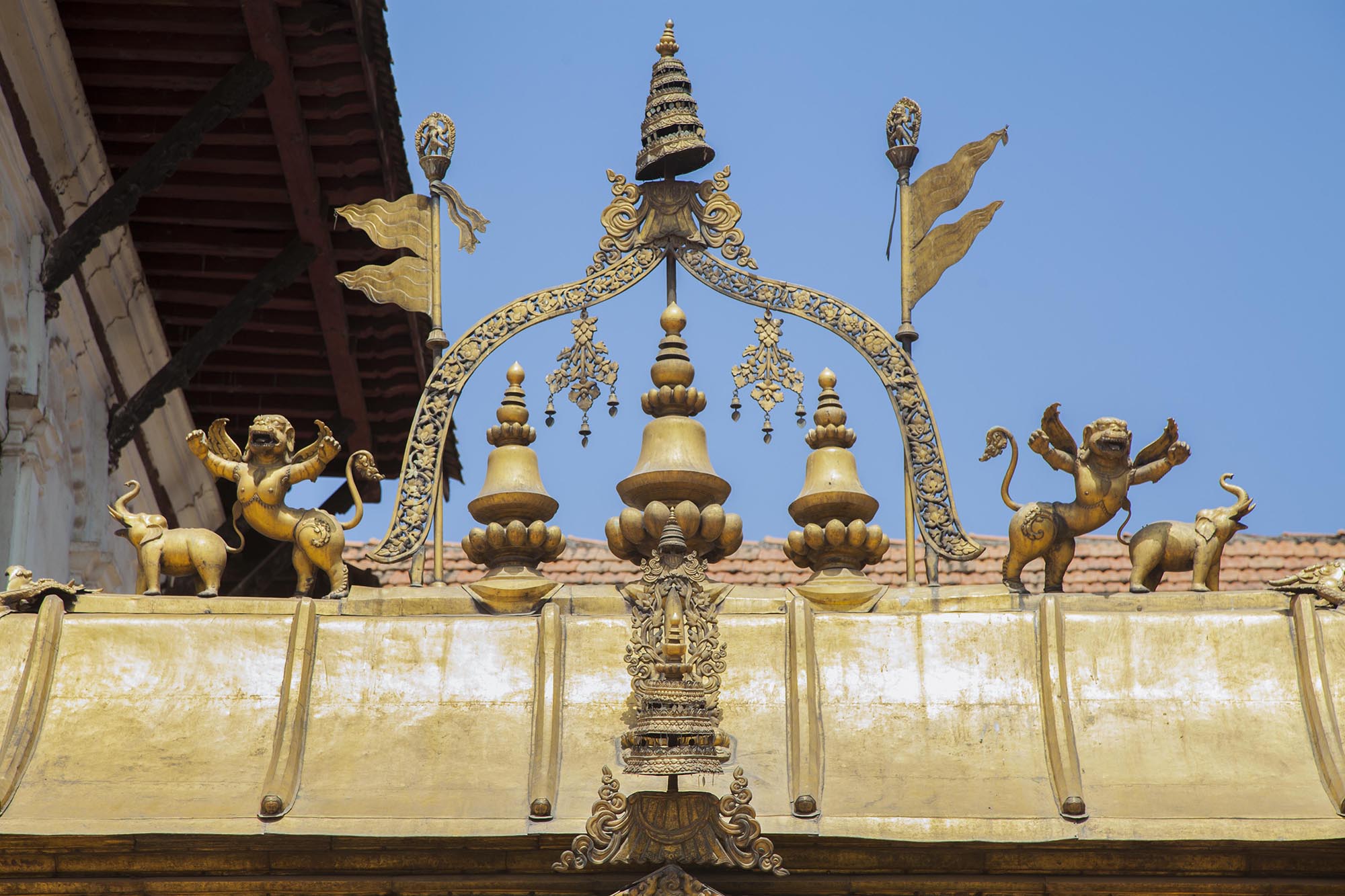
I started at the 55-Window Palace, its facade a testament to Newari woodcarving at its finest. Each panel seemed alive, as if whispering stories of kings and craftsmen. Nearby, the Golden Gate shimmered in the sunlight, its detail so fine it felt almost delicate — a stark contrast to the sturdy stone structures around it.
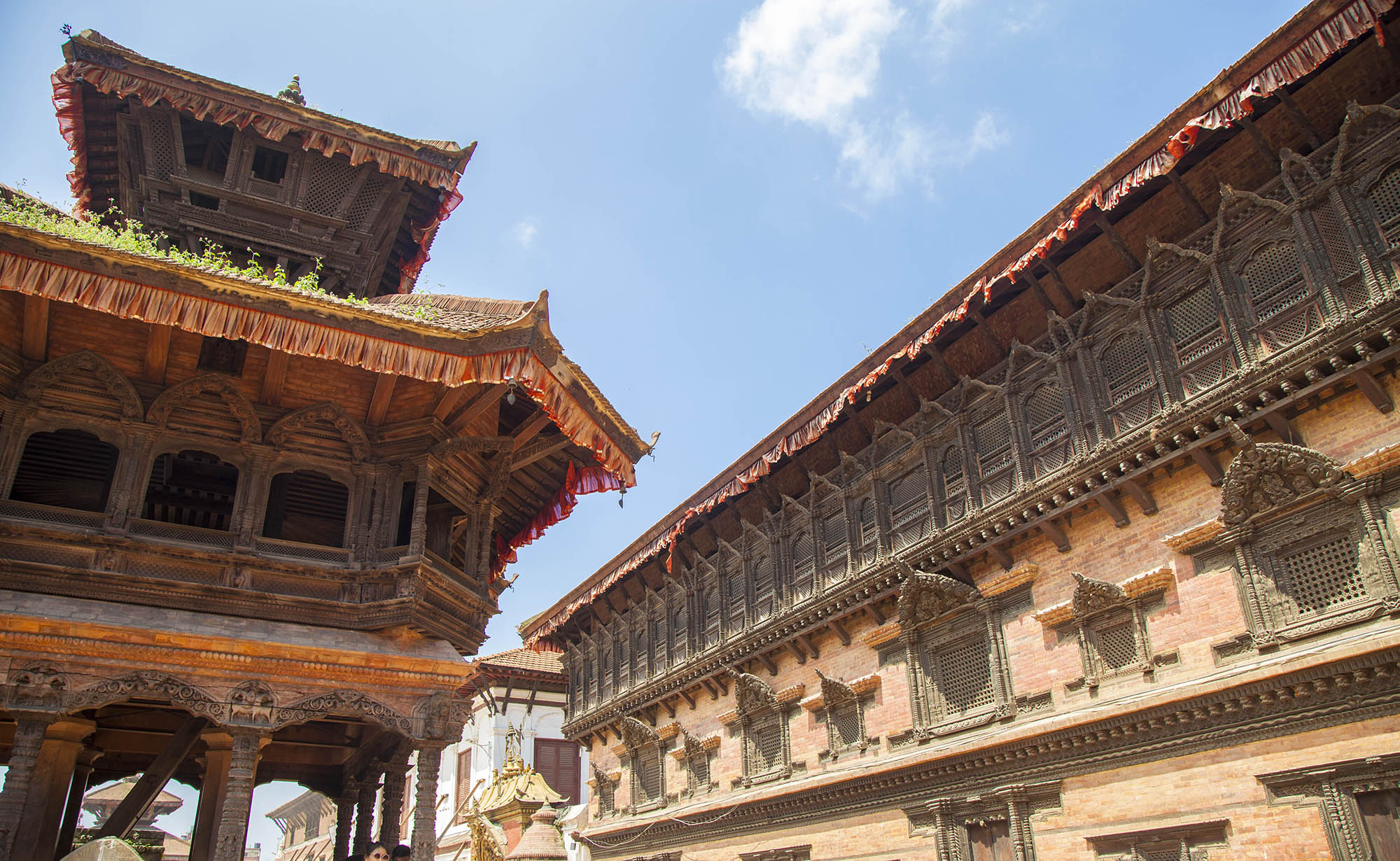
Life here moves at its own pace. Women sat spreading grains to dry, their movements unhurried. Vendors sold clay pots and beads, their goods laid out under the shadow of the Vatsala Temple.
I climbed its steps, taking a moment to rest and watch the square’s slow pulse — children darting about, men deep in conversation on temple steps, the faint clang of a bell marking time.
I explored some of Bhaktapur with a few other volunteers from my project — one of the few days in Nepal when I wasn’t travelling on my own. Sharing the experience added a different rhythm to the day: moments of conversation, laughter, and collective wonder.
If you want to understand Bhaktapur beyond its monuments, take time to explore its corners. A guide can help reveal stories of its past, but wandering on your own allows you to see its present.

The square is open daily from 9 AM to 5 PM (times which can fluctuate, so check locally before visiting), and it’s best explored in the morning or late afternoon, when the light softens and the crowds thin.
Taumadhi Square
Taumadhi Square is dominated by the towering Nyatapola Temple, the tallest in Nepal, whose five tiers symbolise strength, balance, and protection. Climbing its steep steps gave me a sweeping view of the square below, where locals gathered and vendors displayed everything from fresh produce to handmade trinkets. The energy here felt different from Bhaktapur Durbar Square — more grounded, as if life centred around this open space.

Nearby, the Bhairavnath Temple stood firm, its brass and stone features glinting in the sunlight. As I wandered, I found myself drawn to the subtle details — a carved dragon head, a weathered statue — each one a quiet reminder of the square’s storied past.
Spending 30 minutes here, especially in the late afternoon when the light softens, offers a glimpse into both the artistry and the daily life that define Bhaktapur.
Pottery Square
Pottery Square offered one of the most hands-on experiences of my time in Bhaktapur. I had seen potters at work before, but here, I had the chance to sit beside a local craftsman and try it myself. With his guidance, my hands shaped the clay on the spinning wheel — the earthy texture and rhythm of the process grounding me in a way I didn’t expect.

It was humbling to see how effortlessly he turned raw clay into perfectly formed pots while I struggled to keep mine upright.
The square itself buzzed with activity. Rows of freshly made pottery baked in the sun, their deep terracotta tones blending with the brick-paved ground. Potters worked in shaded corners, their hands moving with quiet precision. Vendors sold everything from small clay lamps to intricately designed vessels, and I couldn’t resist picking up a small souvenir.
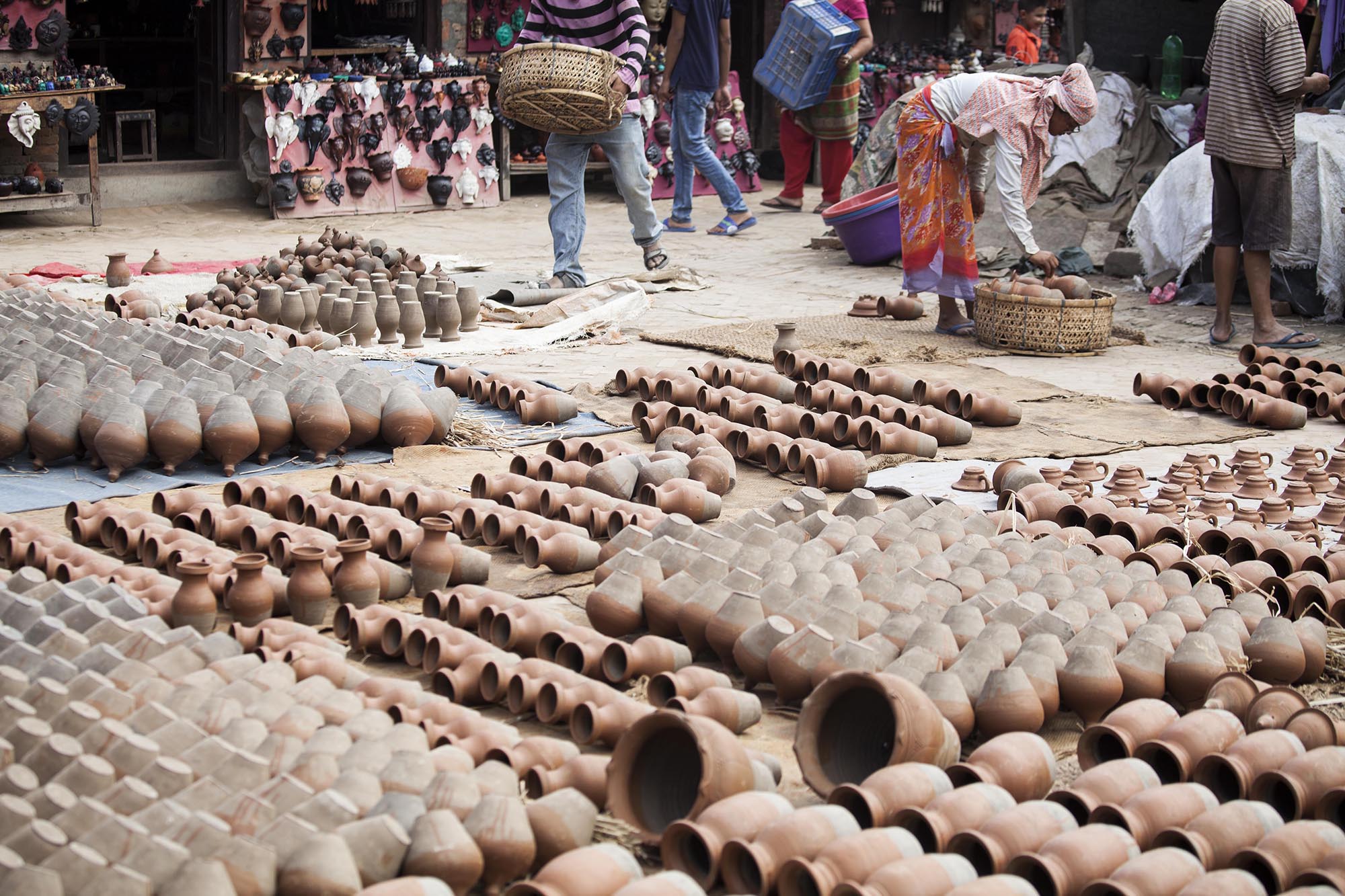
Pottery Square is less about sightseeing and more about slowing down to appreciate an art form that has been passed through generations. Whether you try your hand at the wheel or simply watch the artisans at work, it’s a place that connects you to Bhaktapur’s living traditions.
Dattatreya Square
The square’s heart is the Dattatreya Temple, a three-storeyed pagoda said to have been carved from the trunk of a single tree. As I wandered up to the temple, I couldn’t help but notice the woodwork — the windows, beams, and statues alive with detail.

The square feels like a step back in time. Locals sat in the shade, chatting quietly, while children darted between temple steps and workshops. The small museums and streets around the square, showcasing everything from metalwork to wood carvings, are worth exploring if you have time.

Dattatreya Square offers space to pause and observe — to see artistry not as something locked in the past but as part of daily life, still thriving, still evolving.
Peacock Window
Located just a short stroll from Dattatreya Square, the Peacock Window is housed in the historic Pujari Math. Often referred to as the "Mona Lisa of Nepal," this extraordinary example of Newari craftsmanship draws visitors for its precision and intricacy.

The window depicts a peacock with its feathers fanned out, framed by carved floral and geometric patterns. It’s more than just a work of art; it’s a symbol of the skill and creativity passed down through generations of Newar artisans.
Though technically separate from Dattatreya Square, the Peacock Window is an essential stop for anyone exploring Bhaktapur’s rich architectural heritage. Make sure to take a moment to marvel at its delicate details — a small, quiet masterpiece nestled in the city’s bustling streets.
Accommodation - Staying in Bhaktapur
I didn’t stay overnight in Bhaktapur, as I was basing myself in Kathmandu and visited on a day trip. That said, there are plenty of accommodation options if you decide to extend your stay.
Budget: Tulaja Boutique Hotel
Tulaja Boutique Hotel is an excellent budget option in Bhaktapur, just 200 metres from the iconic Bhaktapur Durbar Square. The rooms are simple but well-equipped, with private bathrooms, free toiletries, and kettles for added convenience.
The friendly staff and great location make it an ideal choice, especially for those keen to explore the area by bike, with rentals available on-site.
Mid-Range: Hotel Bhadgaon
Hotel Bhadgaon is a comfortable mid-range option in Bhaktapur, located less than 1km from Bhaktapur Durbar Square. With air-conditioned rooms, a seasonal outdoor pool, and a well-maintained garden, it provides a relaxing stay close to the town’s main attractions.
The hotel also offers a fitness centre, an on-site restaurant, and bike rentals for exploring the area. It’s also a great choice for families, with a children’s playground and spacious rooms.
High End: The Terraces Resort and Spa
The Terraces Resort and Spa offers a luxurious escape 15km from Bhaktapur, combining world-class service with breathtaking views and serene surroundings. Perfect for those seeking tranquility, the resort features spacious, air-conditioned rooms with private terraces, a spa, and an outdoor pool.
With its distance from town, arranging a private transfer is ideal for convenience. You can enjoy a mix of Cantonese, Indian, and Chinese cuisine at the on-site restaurant or relax in the sauna and hot tub after a day of hiking or cycling. Its blend of comfort and seclusion makes it a standout choice for high-end stays near Bhaktapur.
Food - Eating in Bhaktapur
In Bhaktapur, the volunteer crew and I grabbed lunch at a rooftop restaurant just outside Durbar Square. I don’t remember the name — it was one of those places you stumble upon while wandering — and honestly, that’s part of the charm. Bhaktapur is full of small, family-run restaurants and cafes, many offering incredible views of the old city and a welcome escape from the midday heat.

While I can’t make personal recommendations, it’s easy to find a spot to enjoy a meal.
If you’re looking to eat like a local, try Bara (lentil patties) or Yomari, a sweet dumpling often filled with molasses and sesame seeds. And if you’ve worked up a real appetite, don’t leave without tasting King Curd (Juju Dhau) — Bhaktapur’s famous creamy yogurt, traditionally served in clay pots. It's rich, slightly sweet, and a perfect way to end your meal.
Transportation - Getting around Bhaktapur
Bhaktapur is compact, charming, and best explored at a slower pace. Getting around is simple, and most of it is up to you and your feet.
On Foot
The best way to get around Bhaktapur is to walk. The city is relatively small, with most of its major attractions — like Durbar Square, Taumadhi Square, and Dattatreya Square — within easy walking distance of each other.
The narrow brick lanes are lined with traditional Newari architecture, hidden courtyards, and local shops. Take your time wandering, and don’t worry about getting lost — Bhaktapur’s beauty is in its details, and exploring on foot lets you soak up every bit of it.
By Bicycle
If you want to cover a little more ground, consider renting a bicycle. Some guesthouses or shops offer bikes for a small fee. It’s an ideal option for venturing to quieter areas outside the main squares, or just to save some energy while enjoying the sights.
Keep in mind that Bhaktapur’s lanes can be uneven and crowded, so a bit of confidence in your cycling skills helps.
Safa Tempos and Buses
Safa Tempos — small electric three-wheelers — are a common way for locals to get around and can be a fun experience if you want to travel like a resident. They generally follow fixed routes and are affordable.
If you’re heading further afield, you’ll find small buses or vans operating on the outskirts of Bhaktapur, linking the city to nearby villages and towns.
Taxis
Taxis are readily available and useful if you’re short on time or need a break from walking. You’ll often find them waiting near the main gates or popular attractions.
Fares aren’t always fixed, so it’s worth agreeing on a price before you hop in. If you’re coming from or returning to Kathmandu, taxis can also make for a convenient day-trip option.
Transportation - Getting to Bhaktapur
Getting to Bhaktapur is straightforward, with several options depending on your budget and comfort level.
By Public Bus
For budget-friendly travel, public buses are the most common option. Buses to Bhaktapur leave from Kathmandu’s Ratna Park bus station and usually cost only a few rupees. The journey takes about 45 minutes to an hour, depending on traffic.
Be prepared for a crowded ride and occasional stops to pick up passengers, but it’s an authentic experience of Nepalese daily life.
By Microbus
Microbuses, or mini-vans, also run regularly between Kathmandu and Bhaktapur. They are slightly faster and less crowded than public buses, though still very affordable. Microbuses can be found around Ratna Park or other central hubs in Kathmandu.
Like buses, they stop along the way to pick up and drop off passengers.
By Taxi
A private taxi is the most convenient option but comes at a higher price. If you’re travelling with a group or carrying luggage, this can be worth it. Taxis from Kathmandu to Bhaktapur can be negotiated for a fixed rate, usually around 1,500-2,000 NPR ($12-$15 USD).
Agree on the fare before starting your trip, and ensure the driver knows where to drop you off, as Bhaktapur’s core is pedestrian-only.
By Private Car
While I typically stick to public transport, I travelled to Bhaktapur in a private car with the volunteer group. If you’re short on time or prefer a smoother journey, hiring a private car with a driver offers flexibility and comfort.
Many hotels and travel agencies in Kathmandu can arrange this, and it’s especially useful for day trips or larger groups.
NAGARKOT (नागरकोट) (Days 5-7)
Nagarkot is where I went to pause.

It wasn’t about sightseeing or ticking off boxes. After the energy of Kathmandu, I needed somewhere to breathe, and Nagarkot offered exactly that. Perched at 2,175 metres, this small hill station is best known for its sweeping views of the Himalayas, but I didn’t come just for the scenery — I came to simply be and let time lose its grip.

Mornings started slowly, with mist rolling in and soft light filtering through my window. I’d sit on the terrace with tea, watching the clouds drift over ridgelines, as if they too had no rush to be anywhere. Days stretched out lazily, spent walking quiet trails or reading with nothing but birdsong for company.
By evening, the sunsets turned the distant mountains gold, and for a few minutes, everything felt still.

Nagarkot is the kind of place that doesn’t demand much of you. It’s a place to unwind, to reflect, and to reconnect — with nature, with quiet, and maybe with yourself.
Most people come to Nagarkot for its sunrise views over the mountains, and with good reason. When the weather plays along, the sun creeps up to light the peaks — Everest sometimes visible in the distance.
But what stayed with me most was the stillness. Nagarkot gave me room to breathe, think, and just exist, without expectation.

Whether you’re here for a day or a few, it’s worth allowing time to slow down and letting Nagarkot work its subtle magic.
Top Attractions and Activities in Nagarkot
Nagarkot gave me space to pause and breathe. High above the chaos of Kathmandu, I settled into a rhythm of slow mornings, quiet walks, and nights spent staring at a sky full of stars. It’s a place where you don’t need a schedule — just time and curiosity.
Panoramic Trail Hiking
The Panoramic Trail lives up to its name, offering a gentle hike with some great views in Nagarkot. I followed dirt paths winding through pine forests, where the scent of damp earth mixed with cool mountain air.


Small villages dotted the hillsides, their terraced fields stacked like green steps against the slopes.
Along the way, I passed locals carrying wood and food and children who shouted cheerful “Namaste!” as they ran past.
The hike took me around 2-3 hours, though you could stretch it longer if you stop to rest or chat.

No guide is necessary — the trail is "easy" to follow — but sturdy shoes and a bottle of water are essentials. In saying that, I did get lost at some point - fault of my own, of course - and managed to skip some of the trail.

If you’re lucky with clear skies, the snow-capped peaks of the Himalayas will keep you company.
Nagarkot Geodetic Survey Tower (Viewpoint/Lookout)
I first spotted the Nagarkot Geodetic Survey Tower from a distance — a simple, red-and-white steel structure that rises like a beacon on the hilltop. Climbing its steep steps (mind your head) was worth the effort.

At the top, the view stretched in every direction: the green folds of the valley below and the sharp line of the Himalayas carving into the sky.
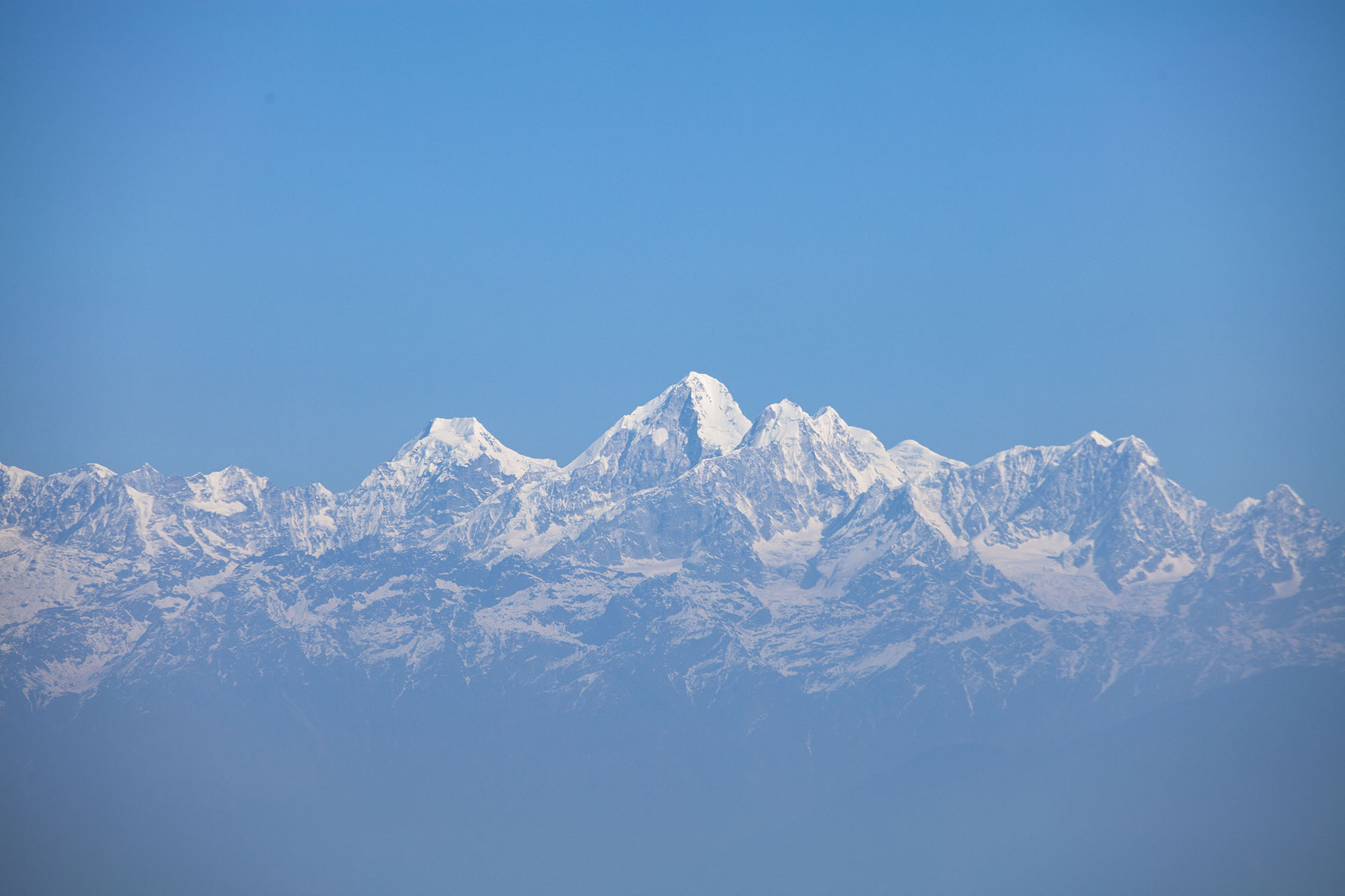
It’s one of the best spots for both sunrise and sunset — though if you’re here in the morning, be prepared for the chill.
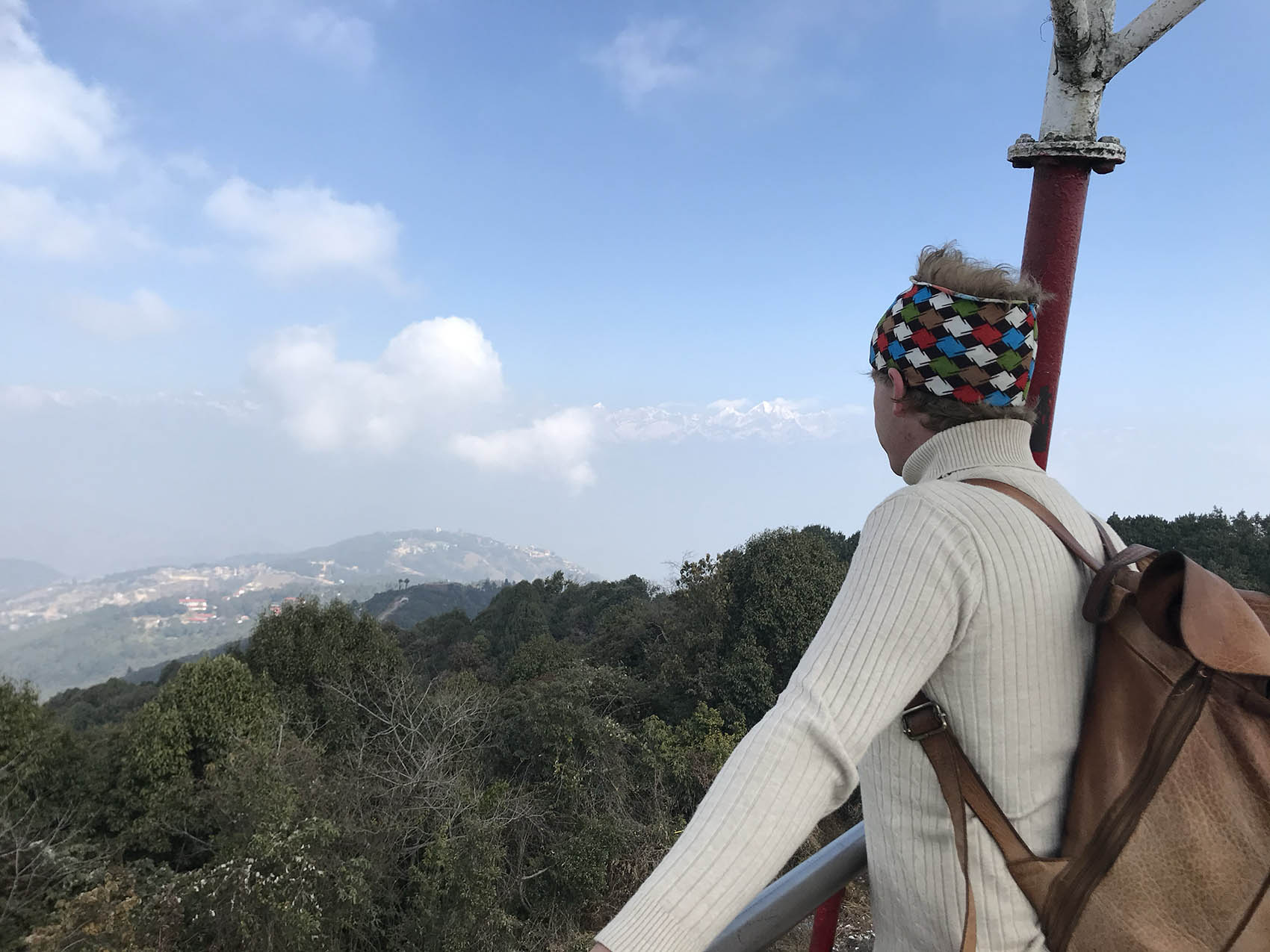
Bring a warm layer and maybe a cup of tea from a nearby stall to sip while you take in the panorama.
Sunrise over Nagarkot
Waking up early in Nagarkot is almost a rite of passage. I set an alarm, shuffled out of bed, and made my way to the hotel terrace (not the Viewpoint). The cold was bracing, and for a moment, the world was wrapped in quiet grey.

Then, as the first light spilled over the peaks, everything shifted. The mountains turned shades of gold and pink, and for a brief moment, it felt like the whole world paused to watch.

The best viewpoints are scattered around town, from hotel terraces to higher spots like the Geodetic Survey Tower. Even if clouds roll in, the anticipation — standing there in the cold, waiting for a glimpse of Everest (from the Viewpoint) — feels almost meditative.
Hotel at The End of The Universe
The Hotel at The End of The Universe is a fitting name for a place that feels removed from everything. I didn’t stay here overnight, but I spent an afternoon on its terrace, drinking tea and watching the clouds drift lazily through the valley.

There’s something charmingly laid-back about it — the kind of place where time slows down, and you could sit for hours without feeling like you should be anywhere else.
The café serves simple, hearty food, and the staff are as relaxed as the atmosphere. Even if you’re staying elsewhere, it’s worth stopping by for tea or a meal, especially when the afternoon sun warms the terrace just right.
Local Encounters
Nagarkot’s real magic happens in the in-between moments — encounters that make you feel less like a visitor and more like you’re part of the rhythm of the hills.

At the viewpoint tower, I met a teacher leading a class of schoolchildren. They were eager to get to know me, crowding around with shy smiles and practiced phrases in English. We took photos together — lots of gestures and laughter — and before I left, the teacher invited me to visit their school in Kathmandu. It was one of those unexpected moments of connection that stayed with me long after.
During the Panoramic Trail hike, I crossed paths with a group of women carrying goods, their brightly patterned skirts a burst of colour against the earth tones of the hills. We stopped and tried to chat, though the language barrier limited us to gestures and smiles. It’s remarkable how much can be shared without words — a reminder of the universal nature of kindness.

On the walk back to my hotel from the Hotel at the End of the Universe, I spotted a group of men crouched by a fire, its smoke curling into the evening air. They waved me over, and I joined them around the warmth. One of them spoke English, and we chatted for a while, swapping stories as they tossed pine needles into the flames.

In Nepal, hospitality feels effortless — strangers don’t hesitate to invite you into their space, whether it’s around a fire or for tea. It’s a culture built on openness, where the warmth of connection cuts through the cold mountain nights.
These encounters, however small, made Nagarkot feel alive. It wasn’t just the landscapes that left an impression — it was the people who filled them.
Accommodation - Staying in Nagarkot
Accommodation in Nagarkot ranges from budget-friendly guesthouses to charming hilltop hotels.
Budget: Hotel Everest Window View
Hotel Everest Window View is a budget-friendly option in Nagarkot that offers decent rooms, friendly staff, and a solid dining experience. The balcony was the highlight of my stay, with stunning views that made the trip worthwhile.

It’s a great base for exploring the area, and with cycling opportunities and Indian cuisine at the on-site restaurant, it provides good value for the price. The 7.9 rating feels just right for what’s on offer.
Mid-Range: The Fort Resort
The Fort Resort in Nagarkot is a solid mid-range choice, offering comfortable rooms with private bathrooms and the option of a terrace or balcony to take in the mountain views. The multi-cuisine restaurant and bar are perfect for unwinding after a day of hiking, which is a popular activity in the area. With its peaceful setting, it’s an excellent option for travellers and nature lovers.
High End: Hotel Country Villa
Hotel Country Villa is a high-end retreat in Nagarkot, offering stunning panoramic views. The spacious rooms come with satellite TVs, seating areas, and private bathrooms with free toiletries, ensuring a comfortable stay.
Spread across 2.51 acres, the property features a garden, terrace, and a multi-cuisine restaurant serving Indian and international dishes. Its proximity to everything makes it a convenient yet luxurious base for exploring the region.
Food - Eating in Nagarkot
Most of my meals in Nagarkot were enjoyed at Hotel Everest Window View, where I stayed. Breakfasts were simple but satisfying, and dinners offered that home-cooked comfort I needed after long, easygoing days. The views alone, whether I was sipping tea or eating daal bhat, made every meal feel special — like the mountains were part of the menu.

I also tried a few other spots around town, including the well-known Hotel at the End of the Universe and Mandap Giri Restaurant - both had great views. While I can’t recall other specific names, there are plenty of small eateries and cafés offering hearty Nepali fare.


In Nagarkot, food isn’t just about what’s on your plate — it’s about where you’re eating it, often with a sweeping view of hills and peaks that stretch endlessly into the horizon.
Transportation - Getting around Nagarkot
Nagarkot is a small, relaxed town where getting around is straightforward.
On Foot
The best way to experience Nagarkot is on foot. Most hotels and guesthouses are within walking distance of key spots like viewpoints, small cafés, and local shops. The trails around Nagarkot, such as the Panoramic Trail, are perfect for leisurely walks.
By Private Vehicle or Taxi
If you’re short on time or want to explore the outskirts, hiring a private car or taxi is an easy option. Taxis are available but can be expensive for short rides, so it’s worth negotiating the price beforehand.
By Bicycle
If you're looking for a bit of adventure, renting a bicycle is a great way to explore the hills and trails around Nagarkot. You can rent bikes from some guesthouses or small shops, and the terrain — while hilly for the most part — makes for a rewarding ride.
Transportation - Getting to Nagarkot
Nagarkot can be reached from Kathmandu or Bhaktapur, but the journey varies depending on your budget, time, and appetite for adventure.
By Bus
If you’re staying in Bhaktapur and feeling adventurous, taking the local bus is an affordable way to get to Nagarkot. The ride can take 3+ hours, depending on traffic and road conditions, and offers a no-frills experience that’s both slow and bumpy.
However, if you’re staying in Kathmandu or Patan, this option is less convenient — you’ll first need to catch a bus to Bhaktapur and then switch to a separate bus for Nagarkot. Keep in mind the bus from Kathmandu to Bhaktapur may drop you off far from where the Nagarkot-bound bus departs. Local buses can feel chaotic, so consider it an adventure.
By Private Vehicle or Taxi
The most convenient, albeit expensive, way to get to Nagarkot is by private car or taxi. On my return journey, I hired a transfer back to Kathmandu for NPR 2,500 - a rare indulgence for me.

This option offers the most comfort and eliminates the stress of navigating multiple transfers, particularly if you’re travelling with luggage or on a tight schedule.
For those planning to trek to Everest Base Camp, this would be the point to fly to Lukla (after returning to Kathmandu) and begin your journey.
If you’re skipping the trek, continue on to Bandipur (via Kathmandu).
Save this article for future reference!
EVEREST BASE CAMP (एभरेस्ट बेस क्याम्प) (Optional - 12-14 Days)
While I didn’t personally make the trek to Everest Base Camp, it’s such a popular and iconic experience in Nepal that I couldn’t leave it out.

For many, this is the ultimate bucket-list adventure. Unfortunately, my own journey to Nepal came with its challenges.
Just a few months earlier, while travelling through Cuba and Mexico, I contracted a rare atypical fungal pneumonia. It left my lungs struggling to function properly, and even the climb to the fourth-floor apartment I rented outside Thamel would leave me needing 30 minutes to recover. Trekking to Base Camp was out of the question, though it remained a dream.
Ever dreamed of flying over Everest without the gruelling trek? For US$1,500+, this helicopter tour takes you over the Himalayas, with a landing at Everest Base Camp and an optional breakfast at the world-famous Hotel Everest View.
➡ Learn more about this once-in-a-lifetime experience here
Still, I spent time researching the trek in detail and had the privilege of hanging out with Sherpas, including interviewing one (which you can red here). Here are a few general insights and tips for those planning the trek.
Length of the Trek and Route Options
The trek to Everest Base Camp typically takes about 12–14 days round-trip, starting with a flight to Lukla. Some trekkers add extra days for acclimatisation or opt for alternate routes like the Gokyo Lakes trek, which offers equally stunning scenery and fewer crowds.
While most itineraries follow the classic route from Lukla to Namche Bazaar and onward to Base Camp, some adventurous trekkers extend their journey with the Three Passes trek, which combines jaw-dropping landscapes with a serious physical challenge.
Practicalities and Preparation
Proper acclimatisation is essential to avoid altitude sickness. Pack wisely — layers are key for the changing temperatures. Most trekkers hire a guide or porter for support and insight, though independent trekking is possible for experienced hikers.
What to Expect Along the Way
Expect breathtaking Himalayan landscapes, traditional Sherpa villages, and suspension bridges that test your nerve. Guesthouses along the trail provide basic but warm hospitality, with hearty meals to refuel after a long day.
The Cost of the Journey
Trekking to Everest Base Camp isn’t cheap, but it’s a worthy investment for many. Here’s a rough cost breakdown:
- Permits: $50–$70 USD total
- Flight to Lukla (round trip): Around $200–$300 USD
- Accommodation: $5–$10 USD per night for basic teahouses
- Meals: $10–$15 USD per day
- Guide or Porter Fees: $20–$30 USD per day
- Gear Rentals (if needed): $50–$100 USD
Best Time to Trek
The best time to trek to Everest Base Camp largely depends on weather and trail conditions. Most trekkers aim for one of the two main trekking seasons:
Spring (March to May)
Spring is one of the most popular times to trek. The weather is relatively stable, with clear mornings offering breathtaking views of the Himalayas. Temperatures are comfortable, ranging from mild during the day to chilly at night. Rhododendrons bloom along the trail, adding vibrant colours to the scenery.Autumn (September to November)
Autumn is the other prime trekking season. The monsoon rains have cleared, leaving behind lush landscapes and crisp, clear skies. The temperatures are similar to spring — mild in the daytime and cold at night — making it ideal for trekking. This season also sees the highest number of trekkers, so expect busier trails and teahouses.
Personal Reflection: Dreams Deferred, Not Forgotten
Missing out on the trek was a disappointment, but it taught me something important about respecting my physical limits and adjusting expectations. Trekking to Everest Base Camp remains on my list, and in a way, I feel more connected to the journey through my time with Sherpas and learning about the trail.
For those who can make the trek, it’s a life-changing experience. And for those who can’t, it’s a reminder that sometimes the dream is as valuable as the destination.
BANDIPUR (बन्दीपुर) (Days 8-9)
Whether you’ve just returned from Everest Base Camp or skipped the trek and come from Nagarkot (via Kathmandu), Bandipur offers a scenic break on your way through Nepal.
Bandipur wasn’t originally part of my plan. It was a recommendation from a colleague I’d met while volunteering at Children of the Mountain in Kathmandu. She didn’t oversell it, just mentioned it as a place worth seeing, and I trusted her judgment.
Bandipur turned out to be an unexpected pause — a space to breathe differently, connect with nature, and let the trip unfold in a new way.

The ridgeline town feels quietly alive, surrounded by hills that are neither dramatic nor unremarkable — they just are. Walking its streets, there’s a sense of deliberate slowness, not forced or curated, but natural to its place. I remember spotting tomatoes drying in the sun, their colours stark against the earthy brick walls, as though the town had its own rhythm for time.

It was here that I stumbled upon a hidden litter of newborn puppies — unexpected life in an unlikely corner. They’d been born in a random, tucked-away spot, struggling with their mother to survive.


It wasn’t part of the itinerary, but alongside a few locals, I managed to help move the mother and pups to a safer space. The moment wasn’t some dramatic life lesson or epiphany — it was simple, grounding. It reminded me that travel often intersects with the everyday in ways you don’t plan.
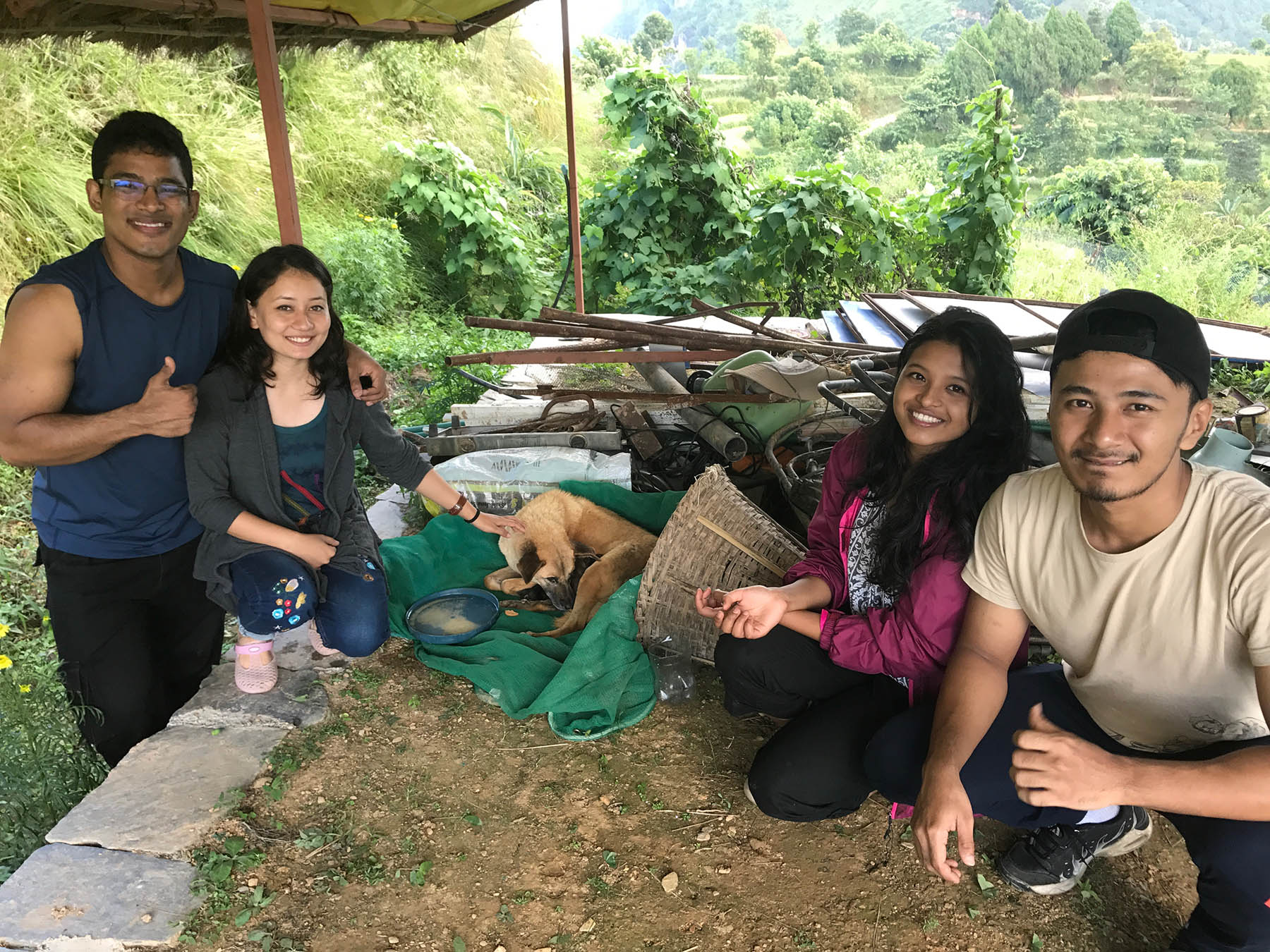
Bandipur isn’t a place to ‘do’ or ‘check off.’ It’s a place to exist briefly, to notice the details: the hum of a local market, the warmth of the hills, the unexpected encounters that stay with you long after you leave.
Top Attractions and Activities in Bandipur
Stroll through the main bazaar and enjoy panoramic views from Tundikhel, all while soaking in Bandipur’s unique hilltop charm.
Bandipur Bazaar
If you arrive by public bus from Dumre, the Bazaar is where you’ll find Bandipur at its most vibrant. Leave your bags at your accommodation and wander into this compact main street, where the past feels close enough to touch. The stone-paved thoroughfare is flanked by Newari buildings that lean slightly with age, their carved wooden windows softened by the passing of decades.
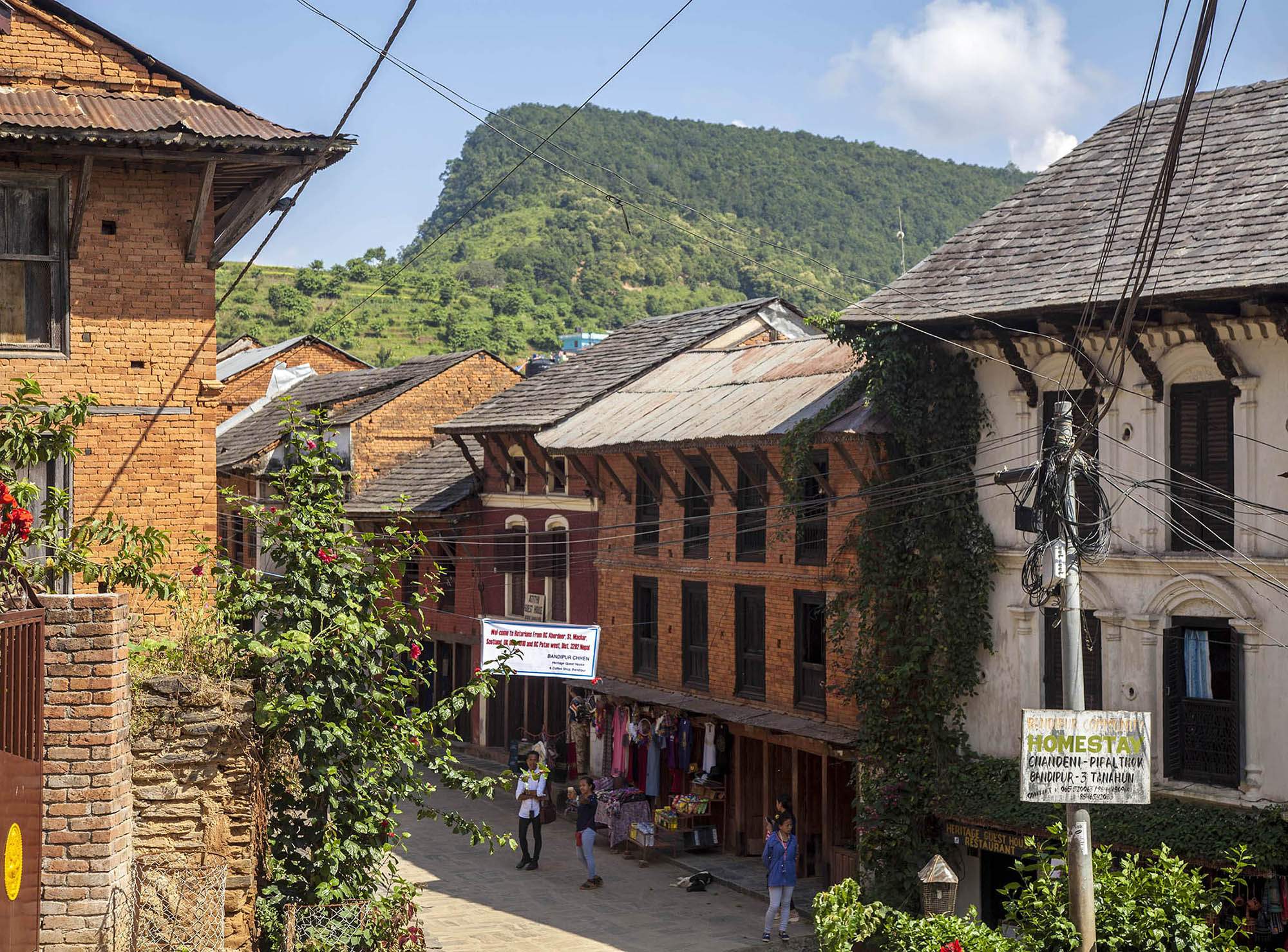
The quiet clatter of shop shutters, the hum of conversations in Nepali, the tomatoes sitting in straw baskets outside shops and the occasional aroma of spices drifting out from kitchens make it easy to imagine the Bazaar’s trading days of old.

Find a spot to pause — perhaps on the back porch of a tucked-away café, where tables are worn smooth by countless visitors. From here, the valley below stretches out in layers of green, the kind of view that asks nothing of you except to notice.
Boudha Sadan Shakyamuni Monastery
Set on a hill overlooking Gurungche to the west, this modest Buddhist monastery exudes a quiet simplicity. Its charm lies not in grandeur but in its surroundings — neatly tended gardens, green fields, and a sense of seclusion that rewards the effort of hiking up the winding dirt road from Bandipur.

The trail itself is part of the experience, weaving through small settlements and fields, with occasional glimpses of the valley below.
The bamboo rope-swing near the entrance offers a playful pause, inviting you to step back into childhood, even if just for a moment, before stepping into the monastery's peaceful atmosphere. The calm here is tangible, making it a perfect spot to sit, reflect, or simply enjoy the stillness.

The walk to the monastery from Bandipur Bazaar takes around 20–30 minutes.
Tundikhel Viewpoint
A short walk from Bandipur’s Bazaar (approximately 10 minutes), Tundikhel Viewpoint offers an unparalleled window to the Himalayas.
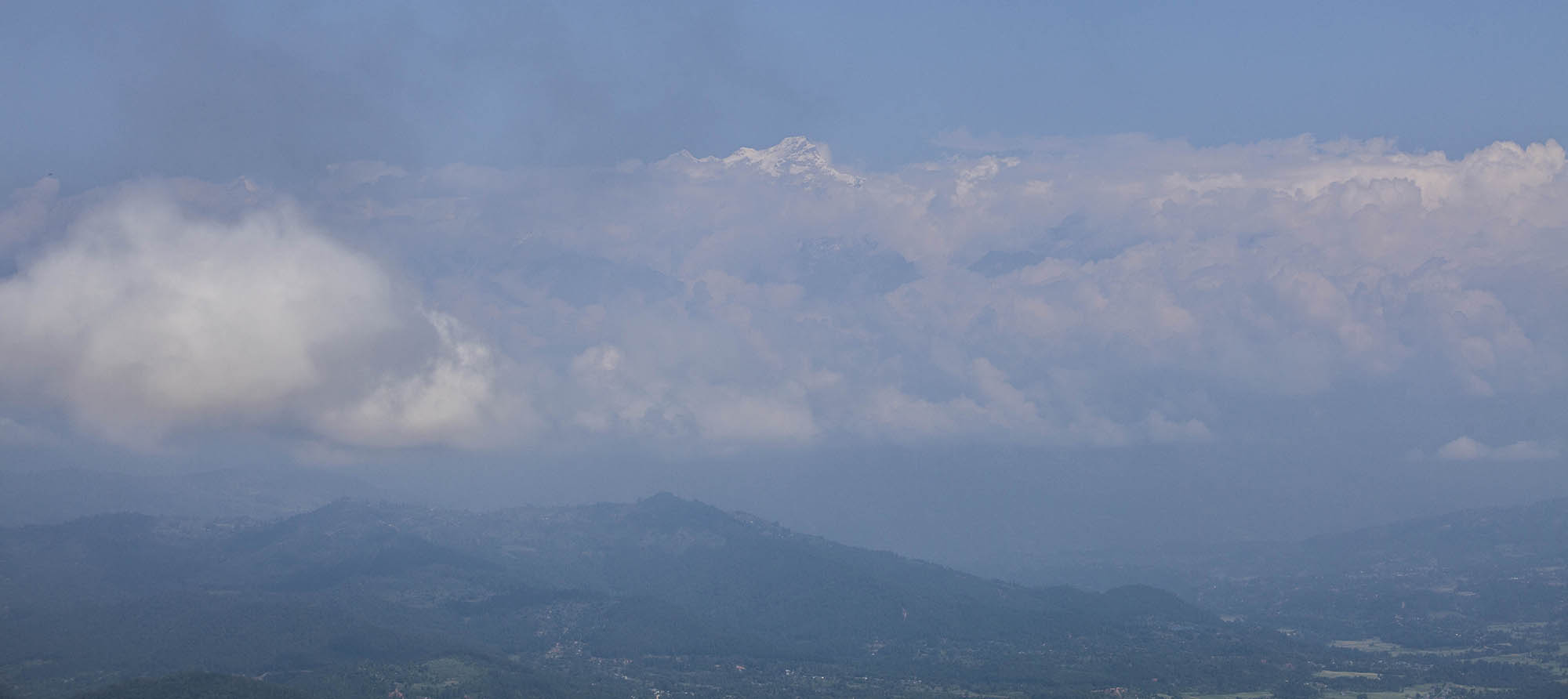
At just over 1,000 metres, with little to obstruct your view, the panorama unfolds in sweeping arcs, showcasing the range that stretches from Pakistan to China. Mornings are best for clarity, as the rising sun casts the peaks in golden light before the inevitable clouds begin to obscure them later in the day.
When I visited, the morning was gloriously clear, offering a glimpse of the range in its full grandeur. However, a power outage left my camera battery drained, forcing me to set aside any attempt at capturing the moment.
Instead, I stood still, soaking in the beauty without the distraction of a lens — an image stored in memory rather than pixels, unfiltered and enduring.
(Until the next day, when I returned to take a shot, though the mist and clouds had already reclaimed the peaks.)
Gurungche Hill
Just 500 metres west of the Bazaar, a winding concrete stairway leads to the crest of Gurungche Hill. While it doesn’t rival the towering Himalayan peaks visible in the distance, the hill rewards visitors with sweeping, near-360-degree views of the surrounding green hills and valleys.

The walk is short and manageable, taking about 15 minutes each way, making it accessible to most.
Both dawn and dusk are worth experiencing here, as the soft, shifting light transforms the landscape, revealing different hues and contours. I made the trek alone and encountered other travellers along the way — proof that a guide isn’t necessary, though company can add to the experience.
There’s no entrance fee, just the quiet reward of a view.
Curious about experiencing authentic village life in Nepal? This full-day guided hike from Bandipur to Ramkot takes you through stunning landscapes and into the heart of a traditional Magar village, where you can observe daily life, chat with locals, and even visit schools to learn about Nepal’s culture and traditions.
➡ Learn more and book your adventure here
Accommodation - Staying in Bandipur
Bandipur offers a range of charming accommodations, from cosy guesthouses to boutique hotels, many with stunning views of the surrounding hills and mountains.
Budget: Bandipur Samira Homestay
Bandipur Samira Homestay is a budget-friendly option that offers a warm, authentic experience in a family-run setting. I really enjoyed my stay here — the mountain views and the welcoming atmosphere stood out, though the cold showers took some getting used to.

It’s just a short walk from Thani Maai and Khagda Devi Temples, making it a convenient base to explore Bandipur.
Budget - Mid-Range: The Hotel
The Hotel in Bandipur offers a blend of budget and mid-range comfort, with clean and spotless rooms and a welcoming atmosphere. The panoramic roof terrace is perfect for taking in the stunning views, and the breakfast is consistently praised by guests.
The staff go above and beyond to assist with transport and other arrangements, making it a great choice for solo travellers and small groups alike.
Mid-Range - High End: The Old Inn
The Old Inn is a charming mid-range to high-end option in Bandipur, offering a blend of rustic ambiance and modern comforts. With rooms that feature balconies and stunning mountain or city views, it’s a perfect retreat for those seeking a serene getaway.
People love the daily breakfast options and the inn’s central location, making it an ideal base for exploring Bandipur’s timeless beauty.
Food - Eating in Bandipur
For a memorable meal in a heritage Newari setting, head to The Old Inn Bandipur, where the buffet lunch of roast chicken and vegetables will leave your taste buds and other senses thoroughly satisfied.

For a more casual bite, check out Himalayan Cafe or enjoy the welcoming atmosphere at The Hotel, where I met fellow travellers and shared stories over a good meal.
Bandipur’s food scene, though small, is full of charm and character.
Transportation - Getting around Bandipur
Bandipur’s compact size makes getting around fairly straightforward. Here are the main ways to navigate this charming hill town.
On Foot
Walking is the best way to explore Bandipur’s narrow streets and hidden courtyards. The main bazaar is pedestrian-only, allowing you to soak up the town’s relaxed vibe and admire the heritage Newari buildings at your own pace.
By Local Transport
For nearby villages like Ramkot, you can hire local transport, such as small jeeps or shared rides.
By Motorbike or Bicycle
For more freedom, consider renting a motorbike or bicycle. This is a great option for exploring the surrounding hills and countryside, though the terrain can be steep and challenging.
Transportation - Getting to Bandipur
Getting to Bandipur from nearby cities like Pokhara or Kathmandu is fairly straightforward, with options to suit most.
Here’s how you can make the journey.
By Bus
From Pokhara, take a bus to Dumre, which costs around NPR 700. Buses typically depart from either the Pokhara Tourist Bus Park (for tourist buses) or Prithvi Chowk Bus Station (for local buses). Once in Dumre, switch to a local bus or jeep for the 8km uphill ride to Bandipur, costing approximately NPR 25.
Be prepared for overcrowded buses on this final stretch, as they’re commonly used by locals.


From Kathmandu, you have a few options:
- Tourist buses leave from Kantipath near Thamel and cost around 800–1,000 NPR.
- Local buses depart from the New Bus Park at Gongabu, north of Thamel on the Ring Road, or from Kalanki, on the southwestern Ring Road. These are generally less expensive but may take longer.
- Once in Dumre, follow the same process to reach Bandipur by local bus or jeep.
By Private Vehicle
If you’ve rented a car or are travelling with a tour, driving to Bandipur is straightforward. The road to Dumre is well-maintained, though the uphill drive to Bandipur is steep and winding, so caution is advised.
Bandipur’s location off the main highway makes it accessible, but the final stretch requires a bit of effort, adding to the charm of arriving in this hilltop town.
POKHARA (पोखरा) (Days 10-12)
Pokhara is a city that invites you to slow down and let its natural beauty take centre stage. Nestled beside Phewa Lake and backed by the Annapurna Range, it feels like a world apart from the bustle of Kathmandu.

The mornings are serene, with the still lake reflecting the surrounding hills, while paragliders dot the skies above Sarangkot, catching thermals over the valley. It's a place where adventure and tranquility coexist seamlessly.
During your time here, wander along the lakeside promenade, rent a boat to explore the water, or hike to the World Peace Pagoda for panoramic views of Pokhara, the lake, and the distant snowcapped peaks. The International Mountain Museum offers insight into the region's mountaineering history, while Devi’s Falls and Gupteshwor Cave provide a glimpse of Pokhara’s geological quirks.
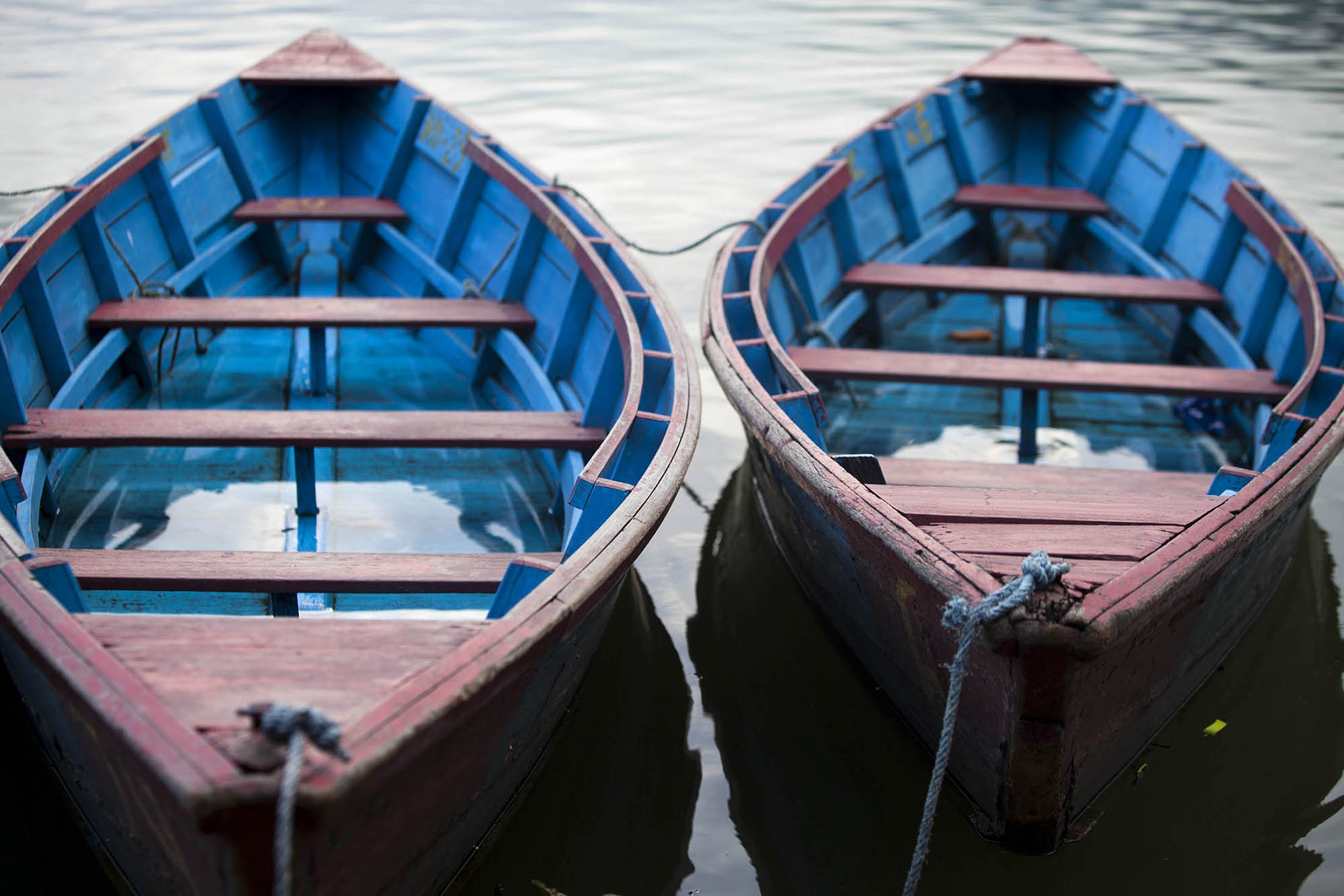
Whether you’re looking to recharge after a trek or dive into adventure with activities like zip-lining or bungee jumping, Pokhara delivers. It’s the perfect midpoint in your Nepal itinerary, offering a blend of comfort, culture, and just the right amount of thrill.
Top Attractions and Activities in Pokhara
Explore Phewa Lake, hike to the World Peace Pagoda, visit the International Mountain Museum, and enjoy adventure sports like paragliding and zip-lining.
Want to see a different side of Pokhara? Book a private tour with a local guide who takes you to hidden gems like the Bhalam and Armala villages, where you’ll explore a jungle cattle farm, enjoy local farm-to-table cuisine, and experience traditional Nepali life. With options for hiking or motorcycling, it’s a peaceful and authentic way to connect with nature and culture.
➡ Learn more and book your tour here
Lake Phewa
Phewa Lake, one of Pokhara’s most cherished landmarks, is framed by steep hills and the distant peaks of the Annapurna Range.

To fully experience its charm, step into one of the brightly painted wooden doongas (rowboats). Rowing solo is an option and costs less, but hiring a rower can add a layer of ease and local insight to the journey. Either way, the gentle glide across the water provides a different perspective on the lake’s calm, glassy surface.

I decided to hire a rower, drawn by the idea of relaxing while someone else navigated. The man I hired was charismatic, cracking jokes as we glided across the calm waters. The conversation flowed easily, and before long, he noticed my dSLR camera and asked if I could take his photo.
What started as a simple ride turned into an impromptu photoshoot, with him posing confidently on the bow of the boat, balancing with ease despite the rocking motion. His energy was infectious, and it added a lighthearted twist to what could have been a quiet, reflective experience.

The best time to visit is during the golden light of dusk, when the mountains cast long shadows over the shimmering waters. Worshippers heading to the Tal Barahi Temple often pass by in boats crowded with song and offerings, adding a lively contrast to the lake’s serenity. My midday excursion, while beautiful, came with a lesson in timing — it’s easy to underestimate the intensity of the midday sun reflecting off the water.

For those who prefer land to water, renting a bicycle from one of Lakeside’s shops is an excellent alternative. Cycle along the eastern road with the breeze on your face, and stop at the far end of the lake to watch paragliders touch down after their descent from Sarangkot.
Solo rowing costs 500–600 NPR per hour, while hiring a rower, like I did, ranges from 700–800 NPR per hour. Boats are easily available along Lakeside, usually at the ends of the main streets.
Barahi Temple
A short 50-metre boat ride from Lakeside, Barahi Temple sits on a small island in the middle of Phewa Lake, drawing both Hindu worshippers and curious visitors.

This two-story pagoda, dedicated to the goddess Barahi, is a hub of spiritual activity, particularly on Saturdays when devotees bring offerings — and, occasionally, animals for sacrifice — creating a scene that some may find confronting.
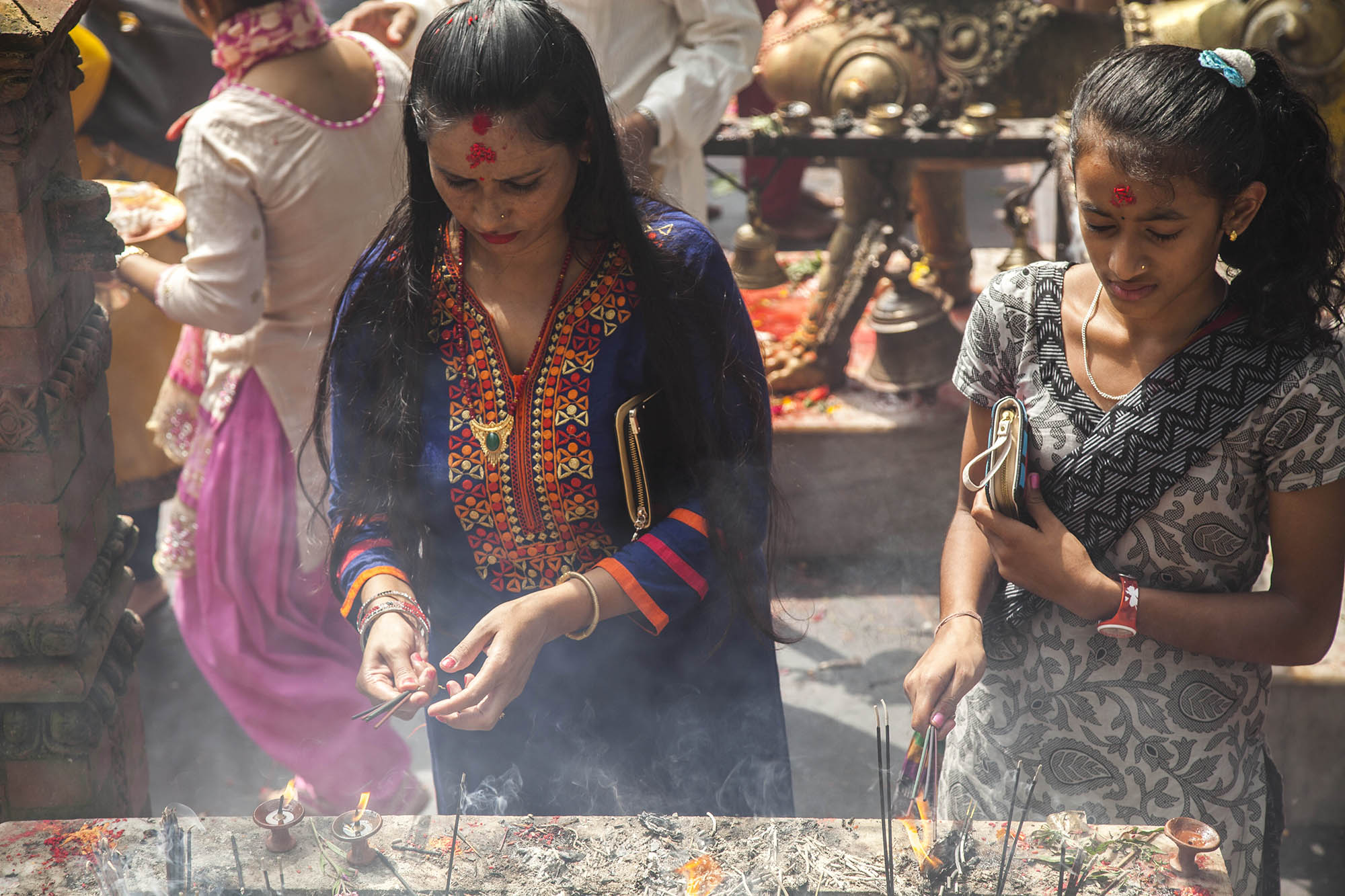

Non-Hindu visitors are welcome to explore the island, but visits are typically brief. A quick circumnavigation of the temple takes just a few minutes, leaving time to soak in the tranquil lake views before continuing to other attractions. I took my time, completing the circuit in about ten minutes, letting the peaceful surroundings balance the intensity of the temple’s rituals.
World Peace Pagoda (aka Shanti Stupa)
Built by Japanese Buddhist monks after World War II, Shanti Stupa — known as the Peace Pagoda — was created to symbolise harmony and unity among all people.

Perched on Ananda Hill, it offers breathtaking views of the Annapurna range, Pokhara, and Phewa Lake. Even if you’re not drawn to the stupa’s spiritual significance, the sweeping panoramas alone make the visit worthwhile. For trekkers, the walk to the stupa can serve as a mild warm-up for longer hikes in the region.
There are two main routes to reach the stupa.
The first begins with a boat ride from Lakeside to the trailhead, followed by a climb through hotel grounds and marked steps, taking around 40 minutes to an hour depending on your pace. Along the way, you’ll find shaded spots and small vendors selling refreshments.
The second route starts from Dam Side, following a forested trail with a gentler incline, gradually leading to the stupa’s serene setting.

While safety has improved over the years, signs along the path still advise travelling in groups or with a local guide. Solo hikers, especially women, were once at risk of attacks, though incidents have declined. I took the risk of walking alone and fortunately faced no issues.
Gupteshwar Mahadev Cave
Dating back to the 6th century, Gupteshwar Mahadev Cave is a sacred site housing a natural stalagmite worshipped as a lingam of Shiva.
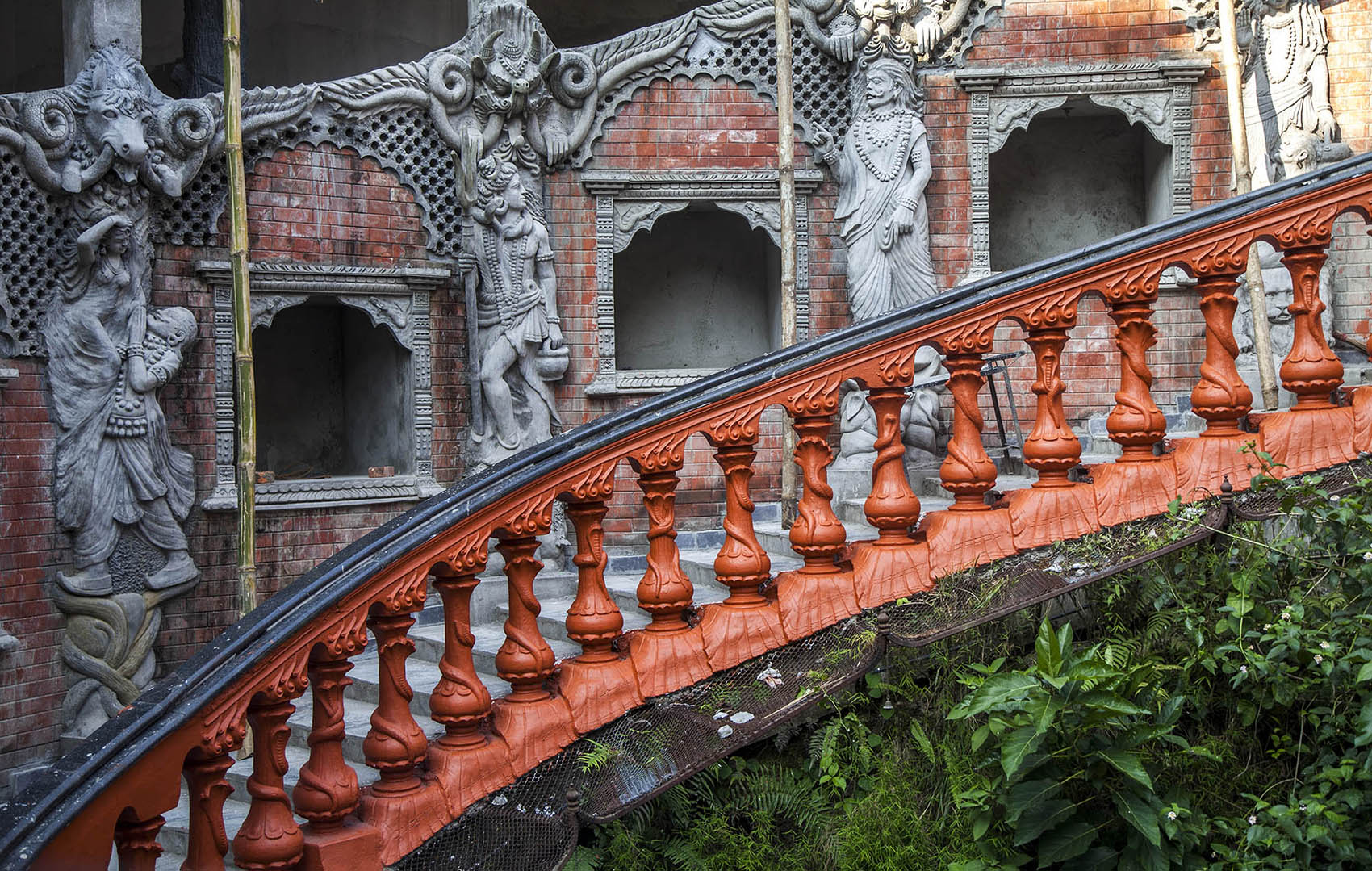
Winding down the opulent, intricately carved steps felt like a journey into another world. As I descended, the slippery stone steps spiraled downward, with cool water dripping rhythmically from the ceiling above. At the base, the temple appears — a quiet, enclosed space where the deity rests behind iron bars.
Beyond the temple, the cave extends into a tunnel that leads to an open cavern. With a bit of scrambling through the dimly lit passages, I eventually found myself in a dramatic space, with the roar of Devi’s Falls echoing in the darkness.

The journey is undeniably adventurous, though it may not be suitable for those uncomfortable with tight spaces or the occasional sense of disorientation in the darkness.
For those who embrace a sense of exploration, the Gupteshwar Mahadev Cave offers a mix of spirituality, geology, and adrenaline, making it a memorable stop in Pokhara.
Devi’s Falls
The roar of the water as it vanished underground was deafening, amplified by the post-monsoon surge. Devi’s Falls marks the final above-ground segment of the Pardi Khola stream, and while enclosed by 2-metre-high wire fences, the sheer power of the rushing water is undeniable.

The name “Devi’s” is an adaptation of David, a Swiss tourist whose tragic drowning alongside his girlfriend in the sinkhole prompted the implementation of safety measures.
I stood near the fence, letting the fine mist cool my skin — a welcome respite from the heat. Despite the crowds of tourists, there’s something captivating about watching the water disappear with such force, knowing the raw power beneath its surface.
The falls are conveniently located near Gupteshwar Mahadev Cave, making it easy to visit both in one trip. I combined these stops after descending from the World Peace Pagoda, creating a day filled with exploration.

For those seeking convenience, a taxi from Lakeside costs approximately 300 NPR.
International Mountain Museum
Nepal is renowned for its towering peaks, home to eleven of the world’s fourteen ‘8000-ers’ — the tallest mountains on Earth. A visit to the country’s sole Mountain Museum feels almost mandatory for anyone curious about the Himalayas. On a clear day, the hangar-like windows of the museum frame stunning views of three of these giants, adding inspiration to the wealth of information displayed inside.

The exhibits cover a broad range of topics: the alpine environment, the history of mountaineering (including the names of those who’ve reached the summits), and detailed insights into the ethnic communities that call these mountains home.
The displays, written in clear English, make it easy to absorb everything from summit minutiae to the tools of mountaineering. Photographs of iconic climbers, such as Sir Edmund Hillary — the first man to summit Mount Everest — are accompanied by their actual gear, including ice axes and crampons, giving a tangible connection to the human stories behind these legendary feats.
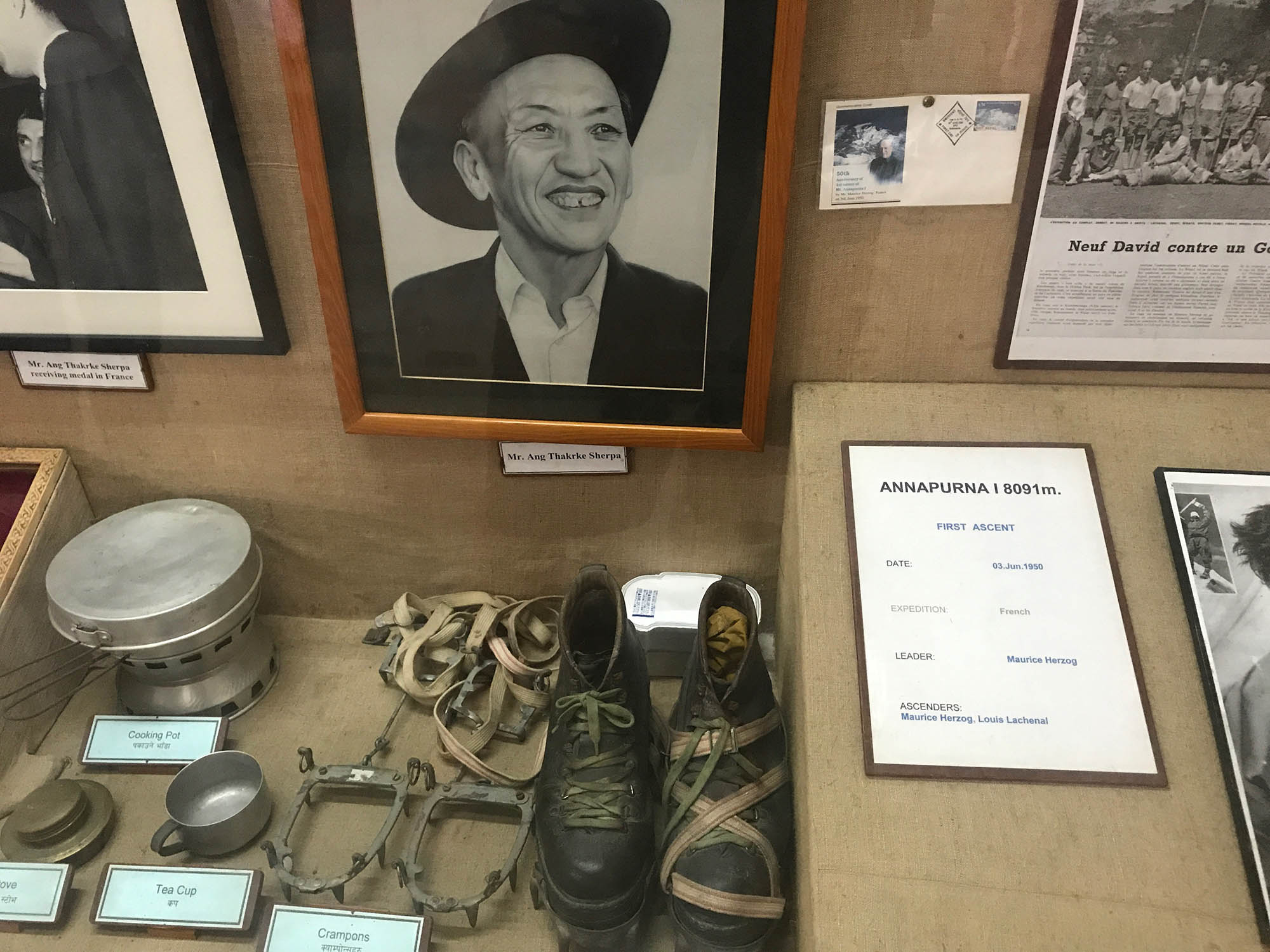
I spent hours immersed in the details of the ‘8000-ers,’ daydreaming about one day standing on Everest’s summit myself. While it’s an ambitious goal, the museum reinforced my belief that it’s worth striving for.
The museum is located 4km from Lakeside, easily reached by taxi or public buses. A taxi ride costs around 300 NPR, while city buses cost less than 20 NPR per trip, though you’ll need to take two.
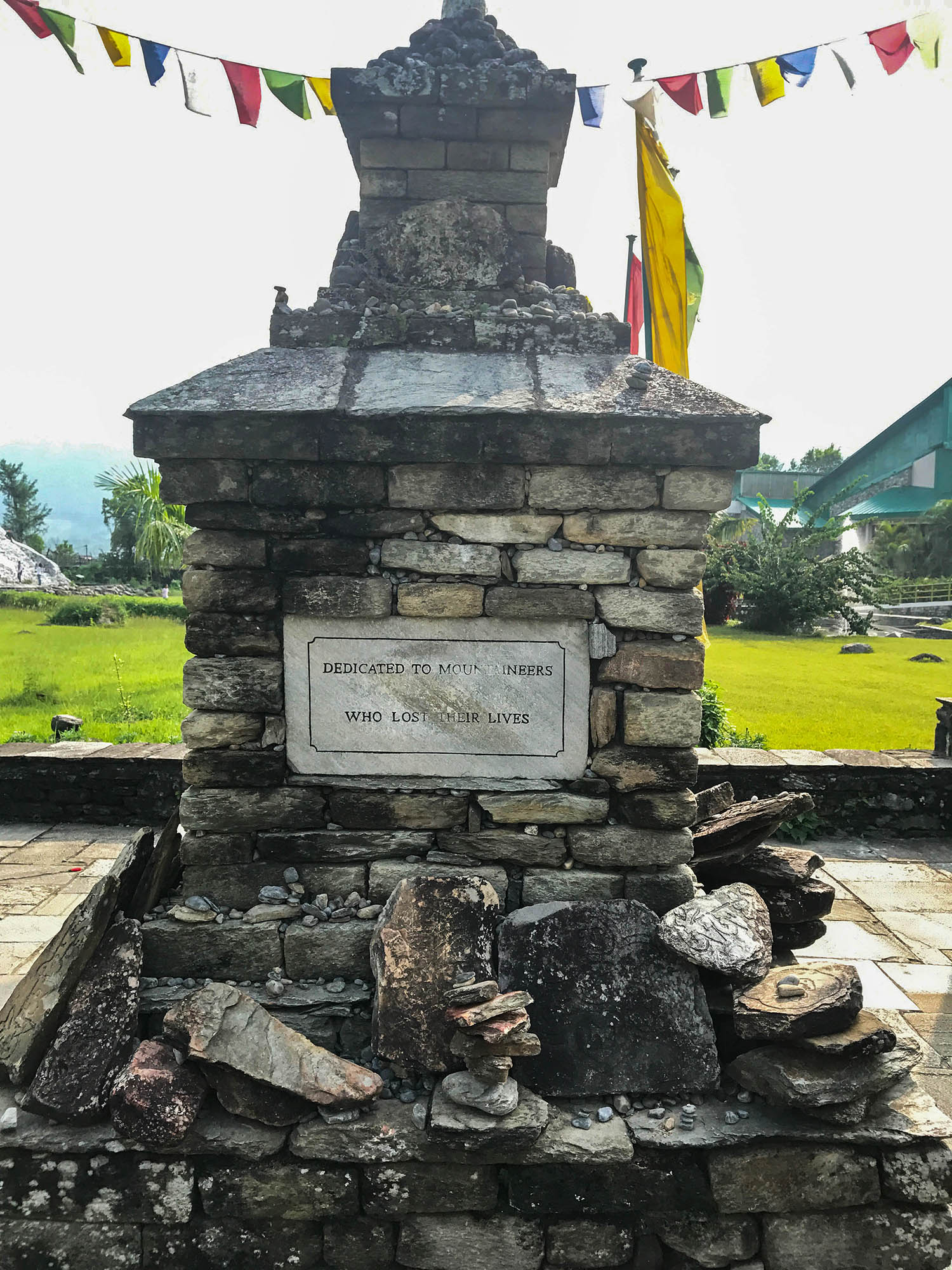
Entry to the museum costs 400 NPR, a reasonable price for such an enriching experience.
Mahendra Cave
Mahendra Cave, a natural limestone formation, is known for its impressive stalagmites and stalactites. Like its counterpart near Devi’s Falls, the cave holds religious significance for Hindus, housing a shrine dedicated to Lord Shiva. This blend of geological wonder and divinity makes it a popular destination for both devotees and curious visitors like me.

Water drips steadily from the cave's ceiling, creating a cool and damp atmosphere but also a slippery surface — sensible footwear is essential to navigate safely. The first half of the cave is dimly lit by artificial lights, but as I ventured deeper towards the temple, the lighting faded, adding to the sense of adventure. Despite the dimness, the natural beauty of the rock formations was captivating.
Reaching the cave requires a 1-hour journey from Lakeside, involving three separate bus rides, though the effort is worth it for the experience.
The entrance fee is nominal, making it an accessible stop for those exploring Pokhara’s surrounding attractions.
"Bat Cave" (Chamero Gufa)
Just a 500-metre walk along the mountain road from Mahendra Cave lies "Bat Cave", a limestone cavern known for its colony of horseshoe bats.

Clinging to the ceiling in complete darkness, these bats are best observed with a torch, which you can pick up at the ticket booth. Shining the light upward reveals thousands of them hanging overhead — a sight that’s equal parts fascinating and eerie, particularly in the cave's damp and unlit atmosphere.
The adventure doesn’t end with bat-spotting. Exiting the cave involves squeezing through a narrow opening, requiring you to crawl and contort your body — a thrill for the daring, though the option to retrace your steps back to the entrance exists.

Either way, it’s an experience that lingers, combining the excitement of exploration with a touch of spookiness.
The best time to visit is between September and May, when the bat population is most active. Like Mahendra Cave, the entrance fee is minimal, making it an accessible addition to your Pokhara itinerary.
Seti River Gorge
The Seti River carves a deep chasm through Pokhara, its glacial, milky-white water rushing 40 to 50 metres below. Standing on the footbridge, I leaned cautiously over the edge, marvelling at the sheer depth of the gorge and the river’s powerful flow. The sight of the Seti surging through its narrow passage is both humbling and captivating — a reminder of nature’s relentless force over time.

Access to the bridge comes with a small entrance fee, but it’s well worth it for the chance to witness this natural feature. One of the best places to view the Seti is on the return drive to Lakeside from Mahendra and Bat Caves, making it an ideal stop to round off a day of exploration.
Sarangkot Sunrise
The Annapurna range seems almost indulgent in its beauty, and there’s no better way to witness it than at dawn.

To see the peaks awaken under the soft light of sunrise, dragging yourself out of bed at 4.00 AM is a small price to pay. Davide, the Italian traveller I’d met at the hostel, and I shared the early morning ritual, groggy but eager, as we made our way up the winding mountain road to Sarangkot — a 5km drive from Lakeside.
Arriving by 5.15 AM, we secured a spot at the front of the viewing platform, tripods in place and anticipation building. Between 5.30 and 6.00 AM, as the sun crept over the horizon, the peaks began their transformation. Hues of gold and amber danced across the rugged silhouettes, casting a spell over the landscape that felt both fleeting and eternal.

It was a moment of connection — to the mountains, the earth, and the quiet company of a friend.

A return taxi from Lakeside costs 1,500 NPR, with prices fixed across providers. Sharing the fare makes it more manageable, as Davide and I discovered, splitting the cost and the experience in equal measure.

For anyone visiting Pokhara, a Sarangkot sunrise is a memory etched in light.
Sarangkot Tandem Paraglide
Launching from the ridge, with the Annapurna range towering in the distance and Phewa Lake sprawling below, is an experience etched into my memory. The sensation of soaring above the valley, untethered and free, was nothing short of exhilarating. My pilot expertly guided the paraglider, allowing me moments to revel in the vast expanse of greenery and mountain peaks.
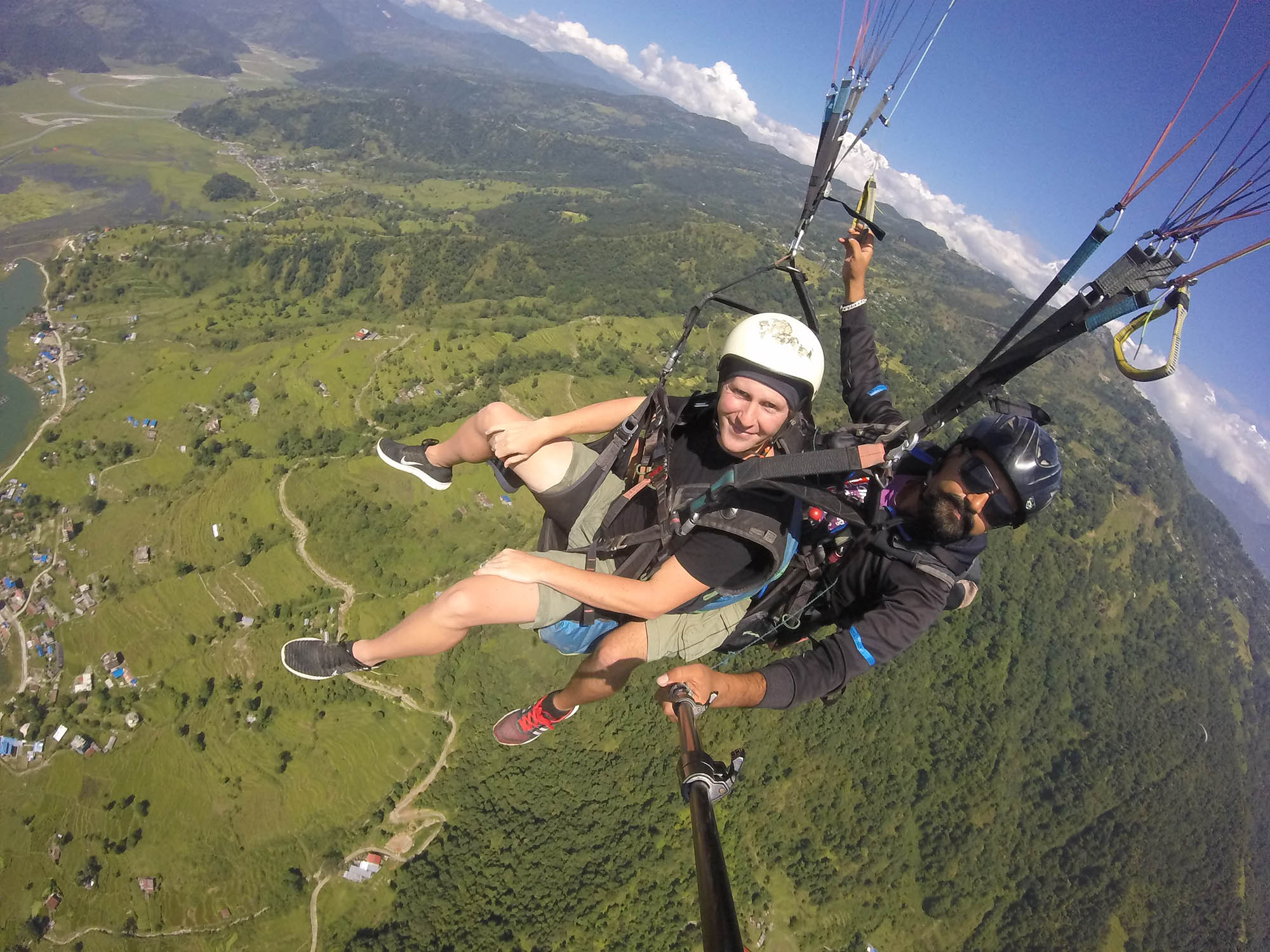
I wasn’t the only one to take the plunge. After my own flight, days later, I watched and supported friends who were embarking on their adventures. Krishna, one of my closest friends and someone I had lived with in Kathmandu, took to the skies with characteristic confidence. Years later, I attended his wedding — another unforgettable chapter in our friendship.


Toni, a kind-hearted woman I’d met while volunteering in Kavresthali, also joined the paragliding ranks. She’s still a dear friend, years following our meeting in Nepal.

The experience is well-organised, with professional pilots ensuring both safety and fun. While the initial nerves were palpable, the moment my feet left the ground, they were replaced by pure awe.
Paragliding off Sarangkot lets you soar above the Himalayas and Phewa Lake, taking in breathtaking views while your experienced pilot handles the flight. Perfect for thrill-seekers aged 10–70, this 30-minute tandem flight includes photos, videos, and hotel pickup if you’re staying in Lakeside.
➡ Learn more and book your flight here
Accommodation - Staying in Pokhara
Whether you’re after lakeside guesthouses or boutique hotels with mountain views, Pokhara has plenty of options to suit every style and budget.
Budget: Hello Inn Guest House & Apartment
Hello Inn Guest House, Pokhara is a solid budget option with a fantastic location just 1.2km from Pokhara Lakeside. The highlight for me was the roof terrace, offering magnificent views of the lake — perfect for unwinding after a day of exploring.

While it’s not particularly flashy, the guesthouse delivers on essentials with free WiFi, an on-site restaurant, and even yoga classes for those seeking a more relaxed pace. Its proximity to landmarks like Fewa Lake and Tal Barahi Temple makes it a convenient base for exploring Pokhara.
Mid-Range: Hotel Middle Path & Spa
Hotel Middle Path & Spa is a great mid-range choice in Pokhara, just a 5-minute walk from the stunning Phewa Lake. The rooms are clean and comfortable, with some offering panoramic mountain views, and the rooftop is perfect for soaking in the scenery.
The location is convenient, with easy access to the airport and bus station. With an on-site restaurant serving Nepali, Indian, and Chinese dishes, and helpful staff to assist with travel plans, it’s an excellent base for exploring the area.
High End: Bar Peepal Resort
Bar Peepal Resort is a top-tier option in Pokhara, offering a luxurious retreat just 1.4km from Pokhara Lakeside. With an outdoor pool, a fitness centre, and breathtaking mountain or city views from select rooms, it’s designed for relaxation and indulgence.
People rave about the buffet breakfast, attentive service, and tranquil garden setting. Its proximity to landmarks like Fewa Lake and Tal Barahi Temple, combined with amenities like a free shuttle service and a 24-hour front desk, make it an ideal choice for those looking to splurge in style.
Food - Eating in Pokhara
I spent a good amount of time in Pokhara, and much of it seemed to revolve around food — there’s no shortage of great places to eat here, whether you’re craving local flavours, international dishes, or a sweet treat by the lake.
For something local, head to Thakali Kitchen for a classic Nepali Thali — shared over dinner with Krishna and his friend, it was a meal that stuck with me for its simplicity and depth of flavour. If you’re in the mood for Tibetan food, Polata Tibetan served up a comforting bowl of chow mein and a surprisingly good rice pudding.
The lakeside area is where most of the action is, with plenty of international options to break up the daal bhat cycle. At El Bocaito, a Spanish spot by the water, I sat back with sangria, fried rice, and a view of the lake shifting colours as the day slipped into evening. Roadhouse Café became a repeat stop — honey-glazed chicken with vegetables one day, corn chips with salsa and tenderloin steak on another, all washed down with a peach iced tea.
Brunch in Pokhara can feel indulgent in the best way. I kept returning to the French Creperie and Bar (by myself or with Toni), where smashed avocado on toast with poached eggs and spinach hit the spot — paired with a vegan smoothie on my next visit. If you’re craving something lighter (or sweeter), the German Bakery is perfect for a quick stop; I grabbed a treat there more than once.
For a quiet meal perched on the edge of the mountains, there’s a nameless spot I stumbled upon that left me as satisfied by the view as the food.

It’s those unexpected finds — like a chow mein at Mints Hut by the lake, or a tagliatelle bolognese at Godfather’s Pizzeria — that make eating in Pokhara a mix of comfort, discovery, and indulgence.
Whether it was a mojito with chow mein at Bamboo Bar or rosemary chicken and lemon meringue at Moonshine, Pokhara’s dining scene felt easygoing, varied, and full of pleasant surprises. You’ll never go hungry here, and there’s something about lingering over a good meal with the lake or the mountains as your backdrop that makes it even more memorable.
Transportation - Getting around Pokhara
Getting around Pokhara is easy and relaxed, with a mix of options depending on how far you’re going and how much you want to spend.
On Foot
Walking was my go-to for most of my time in Pokhara, especially around the Lakeside area. The streets here are lined with cafes, shops, and beautiful views of Phewa Lake, making every walk enjoyable and unhurried.
Exploring on foot gives you the chance to stumble upon small details you’d miss otherwise — like a quiet café tucked away or a perfect spot to watch the lake at sunset.
By Local Bus
For longer trips, like heading to the International Mountain Museum or exploring some of Pokhara’s caves, I used the local buses. They’re cheap, informal, and a bit chaotic, but they get you where you need to go for just a few rupees.
Bus stops can be vague, so don’t hesitate to ask a local or driver for help — Nepalis are often more than happy to point you in the right direction.
By Taxi
Taxis are a more convenient way to cover ground quickly, especially if you’re short on time or heading to spots outside Lakeside. You’ll find them parked near popular attractions and along the main streets. Just remember to negotiate the fare beforehand, as meters are rarely used.
If you’re unsure of the price, check with your hostel, guesthouse or hotel or a local for a rough idea of what’s fair.
By Rickshaw
If you’re after a slower, more scenic ride, the cycle rickshaws in Lakeside are a fun option for short distances. While not the fastest way to get around, it’s a relaxed experience and a nice way to take in the views without walking.
Transportation - Getting to Pokhara
Getting to Pokhara can be a bit of an adventure in itself, with various options depending on your budget, schedule, and tolerance for road conditions.
By Tourist Bus
The most common option for travellers is the tourist bus, which runs daily between popular destinations like Kathmandu and Pokhara. The journey typically takes 6-8 hours, though delays can be common, especially during festivals like Dashain.
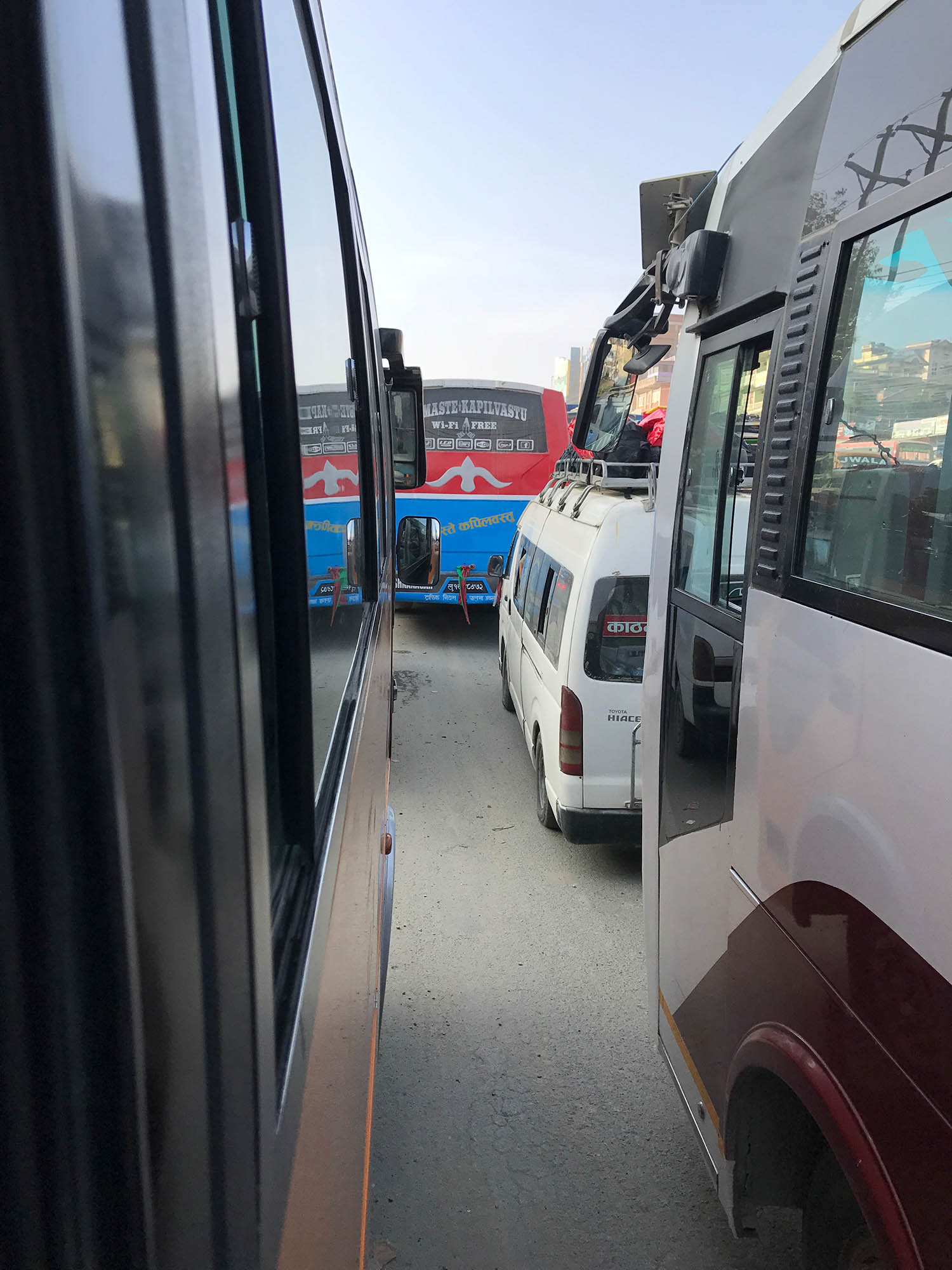

The roads can be rough and slow-going at first, but as you move further into the valleys, the scenery more than makes up for it.


I'll never forget following winding rivers, passing precarious suspension bridges, and admiring how villages dot the mountainsides.
Stops along the way allow for meals and bathroom breaks, though they’re often brief.

At the bustling Pokhara bus station, a mix of sights and sounds makes for a memorable arrival or send-off. Vendors weave through the crowds, selling everything from fresh pastries to bottled water, while stray calves wander freely, adding a touch of charm to the chaos.

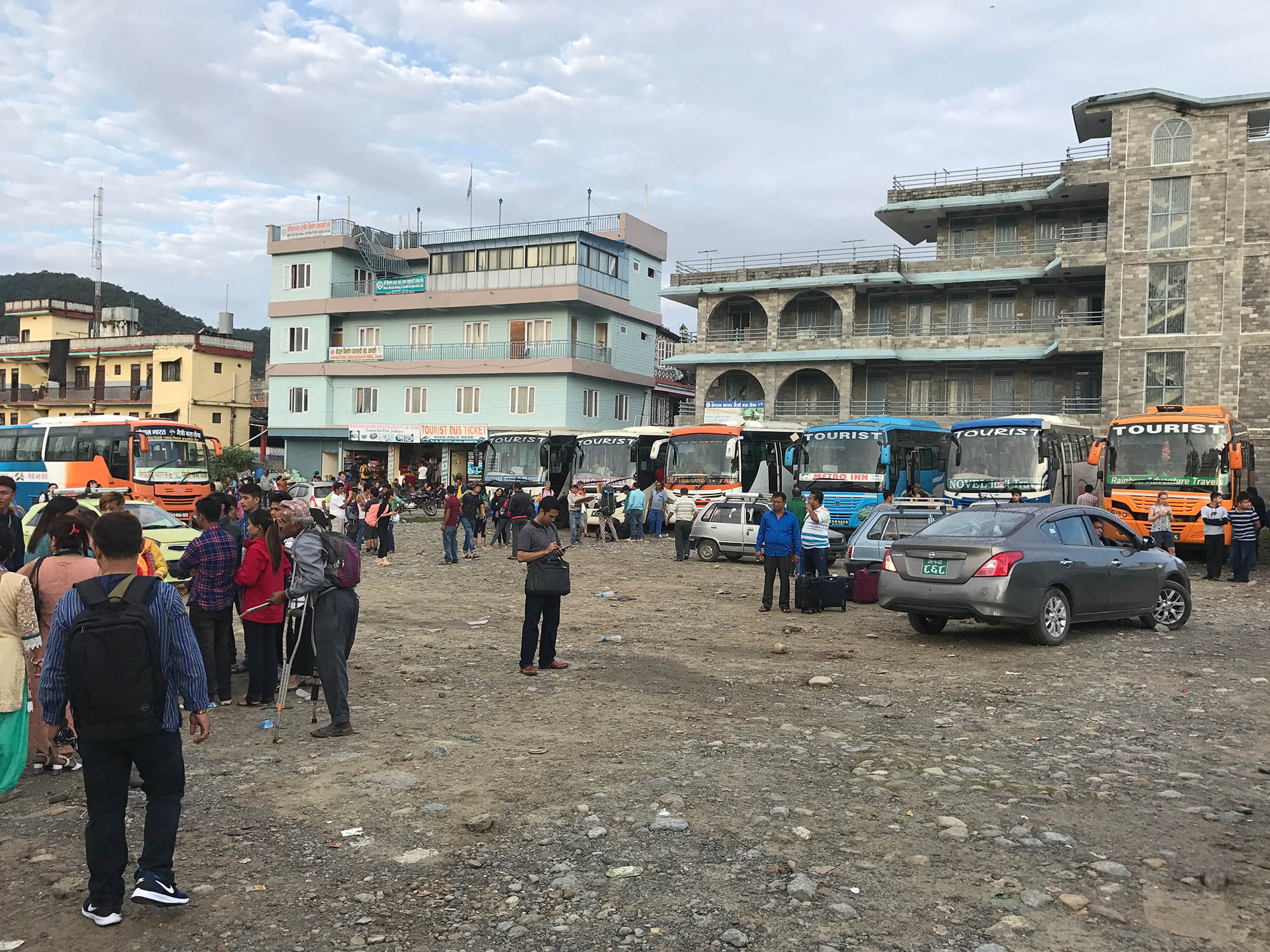
It’s a lively, chaotic hub where journeys begin or end — a true reflection of the energy and vibrancy of Nepalese travel.
By Local Bus
If you’re on a tighter budget or feeling adventurous, local buses also ply the route to Pokhara. While cheaper, they can be crowded, less comfortable, and prone to frequent stops.
Expect longer travel times, no-frills conditions, and a chance to experience the journey as locals do — Nepalese families, workers, and students crammed into the seats with bags of produce or luggage tucked wherever there’s space.
By Private Car or Motorbike
A more comfortable but pricier option is hiring a private car. With a car, you can set your own pace, stop for food or photos as you please, and avoid the chaos of bus travel. Be prepared for occasional delays due to traffic, roadworks, or even police stops (corruption isn’t unheard of).
My friend Krishna — whose wedding I returned to attend — met me in Pokhara during this trip, having made the journey all the way from Kathmandu on his motorbike with a friend riding pillion!
By Flight
If you’re short on time, flights from Kathmandu to Pokhara are the quickest option, taking just 30 minutes. The small planes offer breathtaking views of the Himalayas — worth the price if you’re craving a smooth and scenic arrival. However, flights can be delayed or cancelled due to weather, so it’s best to leave some buffer time in your plans.
ANNAPURNA CIRCUIT (अन्नपूर्ण सर्किट)(Optional - 15-20 Days)
Although I didn’t trek the Annapurna Circuit myself, it came up in countless conversations with fellow backpackers during my time in Nepal. It’s a challenging yet deeply rewarding journey, winding through a range of landscapes — from subtropical valleys to high-altitude passes — that showcase the immense diversity of the Annapurna region.

One vivid memory was chatting with Davide, an Italian traveller I shared a hostel dorm with in Pokhara. His stories brought the trek to life: the camaraderie with other trekkers, the sheer grandeur of Thorong La Pass, and moments of unexpected generosity, like villagers sharing food along the way.
Not all tales told by other trekkers were idyllic, though — there were graphic accounts of squatting by the track, battling sudden bouts of uncontrollable diarrhoea, reminders of how trekking can test both the body and spirit.
For those with the time, money, and stamina, and curiosity to take it on, the Annapurna Circuit promises unforgettable experiences. It’s not just about the landscapes but also the people you meet, the challenges you overcome, and the stories you carry forward.
What Is the Annapurna Range?
The Annapurna Range is a subrange of the Himalayas, named after Annapurna I, the 10th-highest peak in the world at 8,091 metres. It’s home to several towering peaks over 7,000 metres, such as Annapurna South, Gangapurna, and Machapuchare (Fishtail Mountain), revered for their beauty and sacred significance.
The range is a defining feature of central Nepal, drawing trekkers and climbers from around the world. What makes it truly remarkable is the diversity of its landscapes — from tropical valleys to alpine deserts — all accessible within a single trek.
Routes and Variations of the Annapurna Circuit
The classic Annapurna Circuit begins in Besisahar and winds through diverse terrains, reaching the Thorong La Pass at 5,416 metres before descending to the Kali Gandaki Valley.
The full circuit takes about 15–20 days, but shorter variations are available. For instance, many start from Chame or even Manang to skip the lower-altitude stretches. The trek typically concludes in Jomsom or Tatopani, though some continue to Ghorepani for the iconic Poon Hill sunrise view.
How Much Does the Annapurna Circuit Cost?
Trekking the Annapurna Circuit is relatively affordable, but costs can vary based on your style of travel. Key expenses include:
- Permits: Annapurna Conservation Area Permit (ACAP) and TIMS card, costing around $50–$70 USD total.
- Accommodation: Teahouses charge $2–$5 USD per night, though prices may rise at higher altitudes.
- Meals: Budget $10–$20 USD per day for basic food like dal bhat, noodles, or tea.
- Guides and Porters: Guides typically cost $25–$30 USD per day, while porters charge around $15–$20 USD per day.
Overall, most trekkers spend between $300–$800 USD, depending on their preferences.
Challenges of the Annapurna Circuit
The Annapurna Circuit is as demanding as it is rewarding. The high altitude is a significant challenge, especially when crossing Thorong La Pass, where altitude sickness can strike even the fittest trekkers.
The terrain is rugged, with steep ascents and descents requiring stamina and good footwear.
Weather is another factor — temperatures can drop drastically at night, and sudden snowfall may block routes.
Finally, gastrointestinal issues like diarrhoea are common due to unfamiliar food and water, so bringing water purification tablets or a filter is essential.
CHITWAN (चितवन) (Days 13-14)
I didn’t make it to Chitwan during my time in Nepal, but it came up in nearly every conversation I had with locals and travellers.


My friend Jorash (aka Saroj Neupane), a Nepali man I met in Kathmandu who is from Chitwan, described it as a place where nature and community come together in a way that’s hard to find elsewhere. "Chitwan is my birthplace and I often visit," he reflects.
His stories of lush jungles, rare wildlife, and small-town charm stuck with me enough that I feel it’s worth including here.
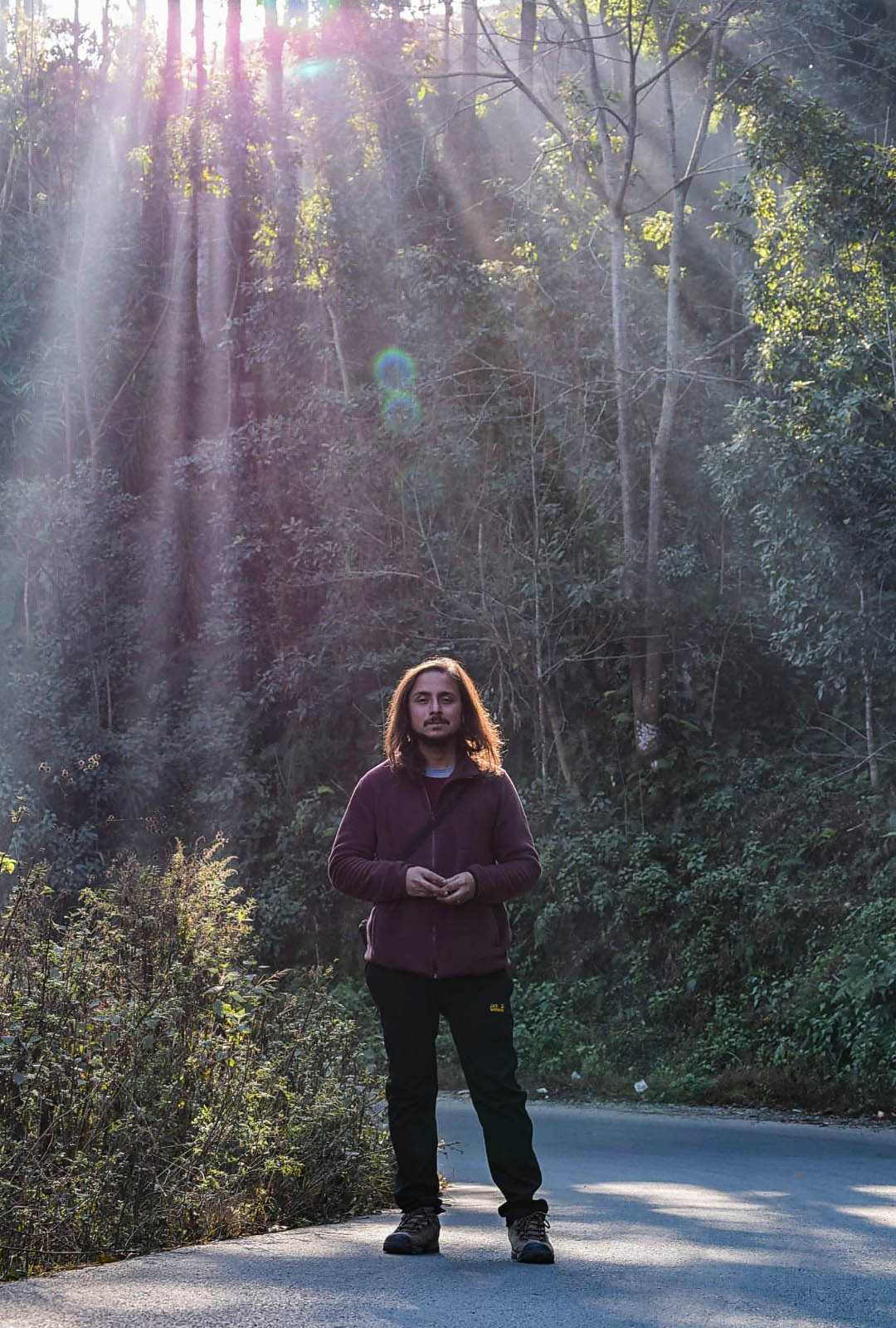
Chitwan is best known for its national park — a UNESCO World Heritage site — and offers a side of Nepal that contrasts sharply with the mountains and medieval towns. From jungle safaris to local village life, it’s a destination where you can experience both Nepal’s natural beauty and its warmth, as told to me by someone who comes from the region.
Here are the top recommendations Jorash shared.
Top Attractions and Activities in Chitwan
From the stillness of a canoe ride on the Rapti River to the rhythmic energy of a Tharu stick dance, Chitwan promises moments that are as vivid as they are unexpected.
Chitwan National Park
“Chitwan National Park is famous because it brings together nature and wildlife like nowhere else,” Jorash told me. Covering over 950 square kilometres of forests, rivers, and grasslands, it’s the oldest national park in Nepal and home to an impressive array of wildlife. You’ll find one-horned rhinoceroses, elusive Bengal tigers, and playful langurs, not to mention over 500 bird species.

The best time to visit is early in the morning when the park is alive with movement and sounds. Hire a certified guide to increase your chances of spotting the park’s rarer inhabitants, as their local knowledge is invaluable.
Jungle Safari
“Inside Chitwan National Park, you can explore by jungle safari,” Jorash said. Whether by jeep or on foot, exploring the wild terrain of Chitwan is a chance to get up close to animals you may have only seen in documentaries.
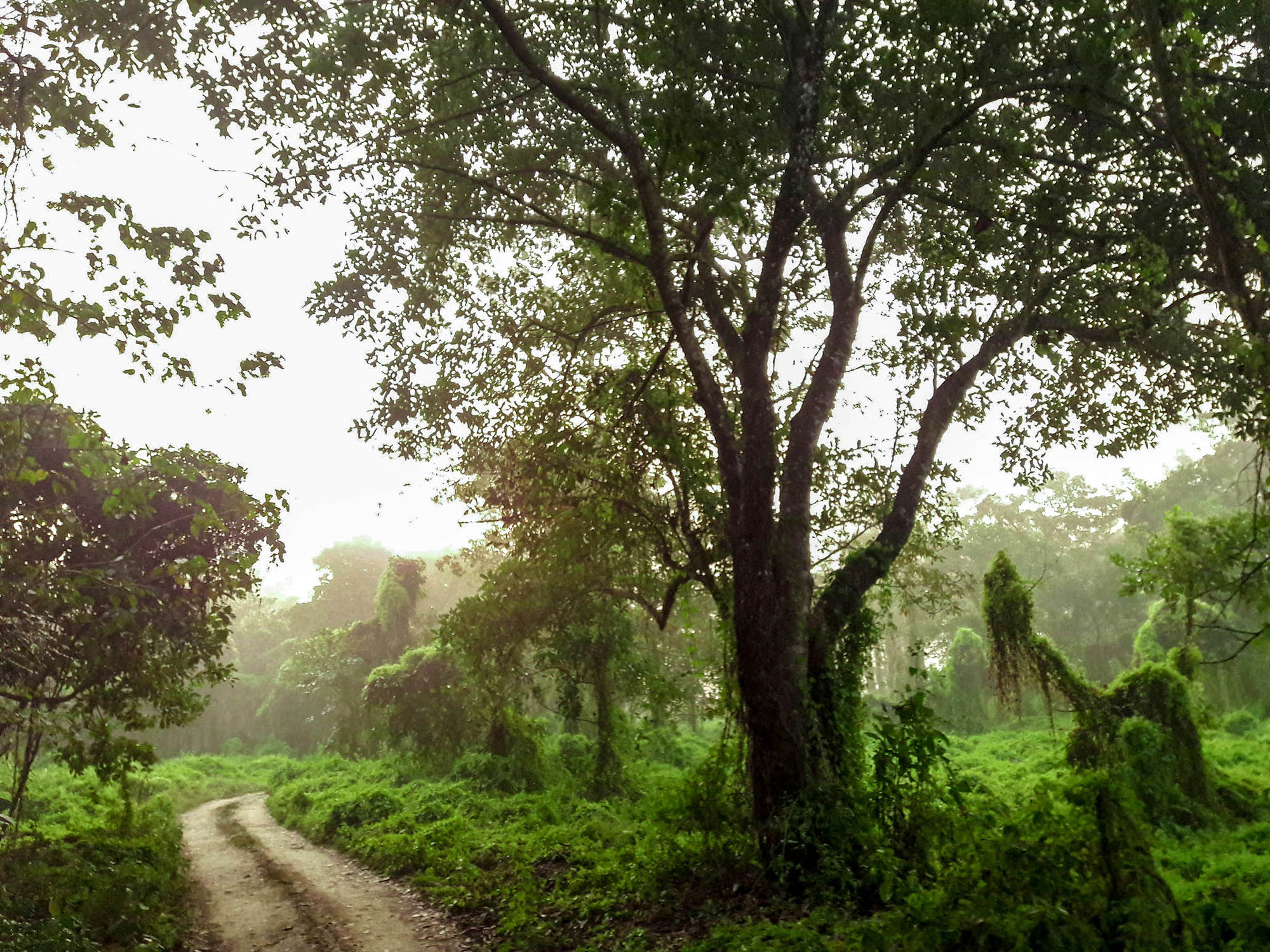
Taking a jeep safari at sunrise is particularly magical as mist lingers over the grasslands and the calls of exotic birds echo in the cool air. If you prefer a slower pace, walking safaris offer an intimate perspective on the jungle, though they’re not for the faint-hearted!
Rapti River Canoeing
"You can also explore the National Park by canoeing on the Rapti River" suggests Jorash.
A canoe ride here is an opportunity to observe wildlife along the riverbanks. Look out for crocodiles basking in the sun and kingfishers darting across the water.

The experience is especially serene in the late afternoon when the light softens and the jungle sounds grow richer. Local boatmen, who expertly steer the long wooden canoes, will share quiet stories about the region and its wildlife.
Experience the beauty of Chitwan National Park with a canoe ride on the Rapti River followed by an exciting nature walk through the forest, guided by a knowledgeable local expert. With a chance to spot wildlife like Bengal tigers and one-horned rhinos, this 2-3 hour adventure combines the tranquility of the water with the thrill of exploring Nepal’s iconic jungle.
➡ Learn more and book your tour here
Elephant Breeding Centre
"Don't forget to also visit The Elephant Breeding Centre," says Jorash, located near Sauraha, a place that evokes mixed feelings. While it’s fascinating to see baby elephants up close and learn about their care, it’s important to be mindful of ethical concerns regarding elephant captivity.

Advice? Go with curiosity but also ask questions about conservation efforts and responsible tourism practices.
Tharu Village Visit
Jorash encouraged me not to skip the Tharu villages scattered around Chitwan. The Tharu community has lived in this region for centuries, and their way of life remains deeply connected to the land.
You can wander through the villages, admire the distinctive mud houses painted with intricate designs, and see traditional farming methods in action. If you’re lucky, a local family might invite you to share a simple meal or cup of tea, offering a glimpse into their everyday lives.
Cultural Performance: Tharu Stick Dance
If you want to experience something lively and cultural, go to a Tharu stick dance performance. Performed in the evenings, these dances are an important part of Tharu tradition and tell stories of community, nature, and resilience.

The rhythmic clashing of sticks, paired with traditional drumming and chanting, creates a celebratory energy that’s hard to resist. Many guesthouses and cultural centres host these performances, so it’s easy to find one.
Accommodation - Staying in Chitwan
Chitwan offers a range of accommodation, from budget-friendly guesthouses in Sauraha to luxury resorts in quieter areas like Meghauli and Jagatpur, catering to all types of travellers.
Budget: Hotel National Park - A Peaceful Family Home in Sauraha
Hotel National Park - A Peaceful Family Home in Sauraha is a solid budget choice if you’re looking for somewhere peaceful and close to the action. It’s about 2km from Chitwan National Park and just 1.4km from the Tharu Cultural Museum, making it convenient for exploring the area. With soundproofed rooms, a garden to relax in, and a free shuttle service, it’s a welcoming spot for couples and solo travellers alike.
➡ Click here to book Hotel National Park- A Peaceful Family Home in Sauraha
Mid-Range: Sapana Village Lodge
Sapana Village Lodge is a fantastic mid-range option in Sauraha, just a 15-minute drive from Chitwan National Park. Surrounded by greenery and decorated with local fabrics and wall art, the lodge blends comfort with a commitment to supporting the local Terai community.
The open-air restaurant serves Nepali and continental dishes, offering panoramic views of the Rapti River — keep an eye out for elephants strolling by! With excursions like jeep safaris, cultural dances, and even cooking classes, it’s a great place to experience the area’s natural and cultural highlights.
High-End: Meghauli Serai - A Taj Safari Lodge
For a high-end stay near Chitwan National Park, Meghauli Serai - A Taj Safari Lodge offers luxury in the heart of nature. Located in Meghauli, this lodge features spacious rooms with river views, spa baths, and private balconies for soaking in the surroundings.
With a spa, outdoor pool, and fine dining options, it’s a retreat designed for relaxation and indulgence. Offering car hire and packed lunches, it’s ideal for travellers looking to combine adventure with world-class comfort. Perfect for couples or anyone wanting to splurge a little.
Food - Eating in Chitwan
While I didn’t visit Chitwan myself, it’s clear from conversations with locals that the region offers plenty of delicious options for travellers. As a major agricultural area, Chitwan is known for its fresh produce, including mustard and poultry, which make their way into many local dishes.
In the towns around the national park, such as Sauraha, you’ll find a mix of local Nepali food and more tourist-friendly fare. Many restaurants cater to travellers, offering everything from dal bhat (Nepal’s staple lentil and rice dish) to international options. If you want a truly local experience, don’t miss the chance to try dishes influenced by Tharu culture, which is unique to the region.
Food in Chitwan is generally affordable, with options ranging from small family-run eateries to higher-end restaurants in luxury resorts.
Transportation - Getting around Chitwan
Getting around Chitwan is relatively straightforward, from what I'm told, with several options depending on where you’re staying and what you want to explore. Here are some of the main ways to navigate the area.
On Foot
Many of the key attractions, particularly in Sauraha and the areas around the national park, can be explored on foot. Walking allows you to take in the scenery at a relaxed pace and discover hidden treats like artisan shops and local eateries.
By Bicycle or Motorbike
Bicycles are a popular way to get around Sauraha and nearby villages. Many hotels and guesthouses offer rentals, and cycling is a great way to see the Tharu villages and countryside. Motorbike rentals are also available for those who prefer a faster option, so long as you have a valid international licence.
By Bus or Jeep
Local buses and shared jeeps are affordable options for getting between towns and villages within Chitwan. While they can be crowded and sometimes lack a fixed schedule, they offer an authentic experience and are a budget-friendly way to travel.
By Canoe or Boat
For areas near the Rapti and Narayani Rivers, such as Golaghat and Meghauli, boats and canoes can be a unique way to explore. Canoeing trips on the Rapti River are particularly popular for wildlife spotting and enjoying the tranquil surroundings.
Transportation - Getting to Chitwan
Chitwan is well-connected to other parts of Nepal, making it accessible from Kathmandu, Pokhara, and beyond. Here are the main ways to get there.
By Air
For those short on time, daily flights from Kathmandu to Bharatpur, the nearest airport to Chitwan, are available. The flight is quick, taking about 25 minutes, and Bharatpur is just a short drive from Sauraha and other parts of Chitwan.
By Tourist Bus
Tourist buses are a popular option for travellers, offering a comfortable and affordable ride from Kathmandu or Pokhara. These buses usually depart early in the morning and take around 6–7 hours, depending on road conditions. They often stop in Sauraha, the gateway to Chitwan National Park.
By Local Bus or Microbus
For budget-conscious travellers, local buses or microbuses are an even cheaper option. While they may be less comfortable and more crowded than tourist buses, they operate frequently and connect Chitwan to many smaller towns. Be prepared for a longer journey due to frequent stops.
By Motorbike
Adventurous travellers can rent motorbikes and ride to Chitwan themselves. While this offers more freedom and a sense of adventure, it’s important to be cautious as Nepal’s roads can be challenging, with narrow lanes, rough conditions and unpredictable traffic.
Essential Travel Information for your Nepal itinerary
Before setting off on your Nepal adventure, it’s helpful to know key details. From navigating to ensuring your health and safety, this section has you covered.
Getting to Nepal
Getting to Nepal is relatively straightforward, with flights being the most common option, but there are other ways to arrive if you’re exploring nearby countries. Here’s a breakdown.
By Air
Flying into Nepal is the easiest and quickest option, especially if you're coming from further afield. Tribhuvan International Airport (TIA) in Kathmandu is the country’s only international airport, welcoming flights from major hubs like Delhi, Bangkok, Doha, Dubai, and Kuala Lumpur.
I arrived by flight each time I visited, but one moment stands out: I remember flying from Chengdu to Kathmandu in the afternoon, sitting on the left side of the plane. At one point, the pilot told everyone to move to the right as the sun was setting over Everest. Watching the summit glow against the fading sky was unforgettable — an introduction to Nepal that brought tears to my eyes.
Be prepared for visa-on-arrival queues and a bit of chaos at the airport, but it’s all part of the experience. Keep cash ready for visa fees, and don’t stress if things feel a little disorganised — Nepal’s magic begins the moment you land.
By Bus (Overland from Tibet [China])
If you’re already travelling through China, crossing the border by land is an option. From Tibet (China), you can enter via the Kodari or Rasuwa border points, although entry rules from China can fluctuate.
By Bus (Overland from India)
Long-distance buses run from Indian cities like Delhi and Varanasi to Kathmandu, usually via Sunauli. While this option is budget-friendly, it’s not the most comfortable — expect 24+ hours on bumpy roads. If you're adventurous and don’t mind the grind, it’s a memorable way to enter Nepal.
Key entry points from India include Sunauli-Bhairawa, Raxaul-Birgunj, and Banbasa-Mahendranagar, among others. It’s a cheaper route but far slower and can involve long waits at border control.
Getting around Nepal
Travelling within Nepal can be an adventure of its own, with options ranging from local buses and shared jeeps to domestic flights and private cars. The roads aren’t always smooth, and delays are common, but the scenery and experience often make up for it.
By Domestic Flight
For long distances, domestic flights are a time-saver and often provide breathtaking views of the Himalayas. Flights connect Kathmandu to Pokhara, Bharatpur (for Chitwan), and Lukla (the gateway to Everest).
Keep in mind that delays and cancellations are common, especially in bad weather, so it’s best to build in some buffer time.
By Bus
Local buses are the cheapest way to get around Nepal, connecting major cities, towns, and rural villages. They’re crowded, bumpy, and often slow, but they offer a slice of daily life.
For a more comfortable ride, tourist buses run on popular routes like Kathmandu to Pokhara or Chitwan. They’re cleaner, less crowded, and typically include a few rest stops along the way.
By Shared Jeep or Private Car
Shared jeeps are a step up from buses, especially for rougher routes to remote areas. They’re faster but still involve close quarters with fellow passengers.
If you want more comfort and flexibility, hiring a private car with a driver is the way to go. It’s pricier but allows you to stop wherever you like, whether it’s for photos, food, or just a break from the bumpy roads.
By Motorbike or Scooter
Renting a motorbike or scooter is an option if you want freedom to explore at their own pace. It’s ideal for areas like Pokhara, Bandipur, or around Kathmandu Valley. Just be prepared for chaotic traffic, uneven roads, and make sure you’re comfortable riding in challenging conditions.
Helmets are a must, and checking your insurance coverage beforehand is wise.
By Rickshaw or Tempo
In cities like Kathmandu and Pokhara, cycle rickshaws and electric tempos (small three-wheelers) are great for short distances. They’re slow, affordable, and often a fun way to experience the local streets — just make sure to agree on a price beforehand.
Visa for Travelling to Nepal
Let's talk visas. Most travellers can obtain a Tourist Visa on Arrival at entry points like Tribhuvan International Airport in Kathmandu. You can apply online up to 15 days before your arrival, which speeds things up at the airport.
When you arrive, you'll need:
- A passport valid for at least six months with at least two blank pages;
- A recent passport-sized photo (1.5” x 1.5” with a white background);
- Completed visa application form (you can fill this out online in advance or upon arrival); and
- Visa fee payment (having cash in US dollars is handy, though cards are often accepted, depending on the border crossing at which you arrive).
Visa fees are:
- $30 USD for 15 days;
- $50 USD for 30 days; or
- $125 USD for 90 days.
Keep in mind, you can extend your tourist visa for up to 150 days in a visa year if you decide to stay longer.
A heads-up: some nationalities need to get a visa before arriving, so it's wise to check the latest requirements before your trip - Immigration Department of Nepal.
Solo Travel in Nepal: What to Expect
Travelling solo in Nepal is a series of unexpected moments that add depth to your adventure. While many come for the towering Himalayas, I found just as much beauty in the connections I made and the slower pace I took after being unwell.
One of the most meaningful connections I made was with Krishna, who I met while volunteering. Over time, our friendship deepened, and I ended up living with him for a while. Through him, I met many of his friends, including Jorash and Sanjay. It was through these relationships that I experienced Nepal’s culture and hospitality on a much deeper level.
During my time in Nepal, solo travel wasn’t isolating, even when I spent quiet days recovering. In Kathmandu, stopping at street-side tea stalls often led to spontaneous chats with shopkeepers or locals curious about my story. I’d sit and sip chai while trading smiles and stories, or simply enjoy the rhythm of life around me.
Guesthouses provided their own kind of camaraderie. Travellers and locals alike would gather around communal tables, and whether I was feeling up to a long conversation or just quietly listening, those shared moments added richness to my time. One evening, after a long day exploring Pokhara, I found myself back at the hostel, and was joined by a fellow traveller, Davide, who has become a long-term friend.
Solo travel in Nepal isn’t just about independence — it’s about embracing the unexpected and being present. From shared cups of tea to moments of stillness in quiet villages, it’s the warmth of the people and the rhythm of life that leave the deepest impression.
Currency and Payments in Nepal
Nepal’s official currency is the Nepalese Rupee (NPR), and it’s good to familiarise yourself with it before you go. Most transactions are done in cash, so it’s a smart idea to carry small denominations for things like tea, local meals, or short taxi rides. ATM machines are available in cities and larger towns, but they can sometimes be unreliable, so having a mix of cash and cards is wise.
In more remote areas, cash is essential, as card payments are rarely accepted. Hotels, larger restaurants, and shops in Kathmandu and Pokhara will often take cards. I found that carrying a few thousand rupees in small notes made day-to-day life much easier, especially for markets and street vendors who don’t have change for larger bills.
One helpful tip: Don’t forget to keep your exchange receipts if you plan to convert rupees back to your home currency before leaving Nepal.
Tips to Stay Healthy While Travelling Nepal
As a nurse and a traveller, staying healthy in Nepal comes down to preparation and mindfulness.
Let’s start with the most common issue: food and water safety.
Diarrhoea is an all-too-common problem for visitors, often caused by contaminated water or improperly prepared food. Stick to bottled or boiled water (even for brushing your teeth), and avoid ice unless you know it’s made from safe water.
If you’re dining out, choose busy, well-reviewed restaurants where food turnover is high. Street food can be tempting, but exercise caution — hot, freshly cooked options are your safest bet.
Hand hygiene is key. Wash your hands before eating, especially if you’ve been handling money or navigating markets.
Altitude sickness is another consideration if you’re heading into higher regions.
Even if you’re not trekking, destinations like Nagarkot or higher areas around Pokhara can leave you feeling short of breath. Drink plenty of water, ascend slowly, and listen to your body. If symptoms like headache, nausea, or fatigue persist, descend to a lower altitude and rest.
It’s also worth packing a basic travel medical kit. Mine included oral rehydration salts, loperamide for diarrhoea, paracetamol for headaches or fever, and a broad-spectrum antibiotic for emergencies. Don’t forget insect repellent if you’re heading to regions like Chitwan, where mosquitoes can be a nuisance.
Lastly, be mindful of the sun. Even on cooler days in the mountains, UV exposure can be intense. A hat and sunglasses can help.
By staying prepared and aware, you can focus on enjoying Nepal’s beauty while keeping health hiccups to a minimum.
Cultural and Social Etiquette in Nepal
Navigating Nepal’s rich cultural landscape means being mindful of traditions and customs, many of which are rooted in deep respect for others. Whether you’re in Kathmandu or a quiet village, understanding a few basics will help you connect with locals and leave a positive impression. But beyond formalities, authenticity requires more than just following etiquette — it’s about being open to seeing the world through someone else’s eyes, even if just for a moment.
One of the most common greetings you’ll hear is Namaste, often accompanied by a slight bow and hands pressed together at chest level. It’s a warm and respectful way to acknowledge others, and responding in kind is always appreciated. Small acts of cultural respect like this set the tone for deeper connections.
When visiting temples or religious sites, modest clothing is essential.
Cover your shoulders and knees, and always remove your shoes before entering. Watch for signs indicating whether photography is allowed, and avoid pointing your feet toward sacred objects or people. This isn’t just a rule — it’s a glimpse into how Nepalese culture values reverence and mindfulness.
To move beyond the surface, it’s important to embrace the mindset of a learner rather than a tourist. Instead of rushing to categorise what you see as “right” or “wrong,” take a moment to observe.
Watch how people interact in markets, temples, or homes. Listen to how they speak to one another. You might notice small details — how tea is poured, how hands are used during meals, or how people greet each other in different settings. These subtleties say as much about Nepal as its landscapes.
If you’re invited into someone’s home, it’s an honour. Removing your shoes at the door, accepting tea with both hands, and engaging in unhurried conversation are ways to show gratitude and mutual respect. Don’t worry about “getting it right” all the time — sincerity matters more than perfection.
Consider spending time in places where life is slower and less mediated by tourism. Rural homestays, quiet villages, or even sitting in a local tea shop for an hour can teach you more about Nepal than a packed itinerary ever could. These moments allow you to observe life as it unfolds naturally.
Instead of seeking to do, focus on simply being — letting go of your own assumptions and embracing the rhythm of another way of life.
True connection also requires humility. You’re not there to validate or compare your worldview but to momentarily step into another.
Ask questions when appropriate, but listen more than you speak. Watch how Nepalese people navigate their challenges, celebrate their joys, and express their spirituality — it’s in these quiet moments that the heart of Nepal reveals itself.
By approaching Nepal with an open, non-judgmental mindset and letting go of the need to categorise every experience, you’ll find yourself not just travelling through a country but being welcomed into its soul. It’s this shift — from looking at Nepal to truly seeing it — that makes for an authentic experience.
Customising your Nepal Itinerary
The itinerary I’ve shared is a guide, but Nepal is incredibly flexible, and you can easily adjust it to suit your interests, the season, or how much time you have.
Prefer trekking over cities? Add extra days in the Annapurna region or Everest Base Camp. Not big on jungles? Skip Chitwan and spend more time in Pokhara or Nagarkot.
Weather can also influence your plans — monsoon might make trekking less appealing, while winter offers clear skies for mountain views.
Whether you want to slow down, explore deeper, or focus on specific highlights, Nepal welcomes a pace and path that’s entirely your own.
Recommended Books for Nepal Itinerary Planning
When planning your trip to Nepal, having a reliable guidebook can make all the difference. A well-researched book offers detailed insights, tips, and practical advice that enhance your experience and help you navigate the country with ease.
Here are some recommendations.
Nepal, by Lonely Planet
Lonely Planet’s Nepal guidebook is a go-to resource for travellers. It covers everything from iconic trekking routes like the Annapurna Circuit and Everest Base Camp to cultural highlights such as Kathmandu Valley’s temples and Chitwan National Park.
With detailed maps, accommodation recommendations, and tips for solo and group travellers, this guide is an essential companion for anyone planning a trip to Nepal. Whether you’re seeking adventure, cultural immersion, or simply practical advice, it’s packed with information to help you make the most of your journey.
Nepal, by Insight Guides
Insight Guides: Nepal is perfect for travellers who appreciate a blend of cultural and practical information. Known for its stunning photography, this guidebook provides an immersive introduction to Nepal’s landscapes, history, and traditions.
It covers major attractions like Kathmandu, Pokhara, and Chitwan, while also delving into local customs and hidden gems. With suggested itineraries and detailed cultural insights, this book is ideal for travellers who want to understand the story behind what they see. It’s both a visual treat and a practical planning tool for your adventure in Nepal.
Travel Insurance for Visiting Nepal
World Nomads
Travel insurance is an absolute must when visiting Nepal, whether you're trekking in the Himalayas, exploring ancient towns, or navigating local buses. The unpredictable nature of travel here — altitude sickness, food-related illnesses, or even road accidents — makes having reliable coverage essential for peace of mind.
World Nomads is a popular choice, offering coverage that’s flexible, straightforward, and tailored to adventurous trips. Their policies often include activities like trekking (up to certain altitudes), which many standard insurers exclude. It’s easy to extend or modify your policy online if your plans change, and their customer support is well-regarded by travellers, including me.
FAQs for Visiting Nepal
Here are answers to some common questions to help you plan your trip to Nepal.
Which month/season is best to visit Nepal?
The best time to visit Nepal largely depends on what you want to do, but most travellers agree that autumn (September to November) is the ideal season. The skies are clear, the weather is mild, and the mountain views are at their best — perfect for trekking, sightseeing, and photography.
Spring (March to May) is another great option, with blooming rhododendrons adding bursts of colour to the hillsides and temperatures warming up across the country.
If you prefer fewer crowds and don’t mind some rain or colder conditions, the winter (December to February) and monsoon (June to August) seasons have their own charm. Just be aware that heavy rains can make trekking routes muddy and limit visibility during the monsoon, while winter brings snow to higher altitudes and chillier mornings in cities like Kathmandu.
Ultimately, Nepal offers something special year-round, but autumn and spring are the safest bets for the best experience, and they're my personal favourite times to visit.
How many days in Nepal is enough?
The ideal length of your trip to Nepal depends on what you want to experience, but I’d say a minimum of 10–14 days is a great starting point. This allows time to explore Kathmandu Valley’s cultural hubs like Kathmandu, Bhaktapur, and Patan, spend a few days unwinding in Pokhara, and maybe fit in a short trek or a visit to Chitwan National Park.
If you’re short on time, 5–7 days can give you a taste of Nepal — exploring Kathmandu’s temples, taking a day trip to Bhaktapur or Nagarkot, and enjoying a couple of days in Pokhara.
For those looking to truly immerse themselves — perhaps with longer treks like the Annapurna Circuit or Everest Base Camp — 3–4 weeks would allow for a deeper, slower journey into Nepal’s diverse landscapes and culture.
Ultimately, Nepal is a place where time feels less relevant; even a few days can leave an impression, but longer stays reward you with richer experiences and more meaningful connections.
Which languages are spoken in Nepal?
Nepali is the official language of Nepal, spoken by the majority of the population. However, the country is home to incredible linguistic diversity, with over 120 languages and dialects.
You’ll often hear Newari in the Kathmandu Valley, while Tibetan and various Indigenous languages are spoken in the mountains.
English is widely understood in tourist areas, making it easy for travellers to communicate.
Save this article for future reference!
Nepal Itinerary Conclusion
Nepal is not a place you simply visit — it’s a place that invites you to pause. It’s in the rhythm of the prayer flags fluttering in the wind, the hum of a Buddhist chant carried through the valleys, and the unhurried way people pour tea as if time itself bends to hospitality. It’s in the dusty streets of Kathmandu, where chaos finds its own harmony, and in the stillness of a sunrise over the Himalayas, where the world feels infinitely larger yet strangely intimate.
For me, Nepal wasn’t about ticking off destinations or conquering mountain peaks. It was about the spaces in between — the quiet smile exchanged with a stranger on a crowded microbus, the earthy smell of incense mingling with the morning air, and the way life seemed to flow unbothered by the frantic pace of modernity. It taught me to simply be, to sit with curiosity instead of answers, and to see beauty in the unpolished edges of the world.
In Nepal, I found that it wasn’t what I did that mattered, but how I allowed myself to be present. That’s the real heart of the experience: surrendering the need to define it and letting the country and its people show you who they are. And in that, I felt something timeless — a connection not just to a place but to the shared humanity that weaves us all together.
If this resonates with you, feel free to share it with someone who might need a little pause in their own journey — or simply to reflect on what being, not doing, might look like for them.
